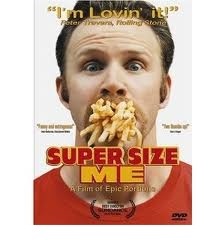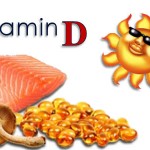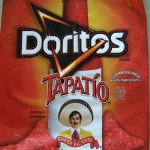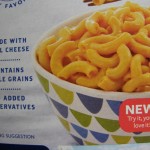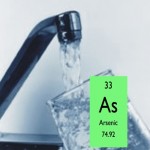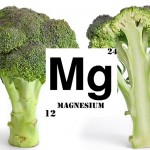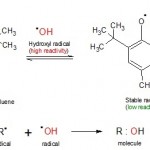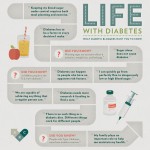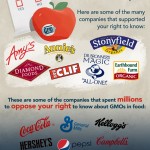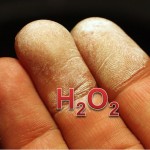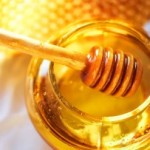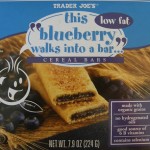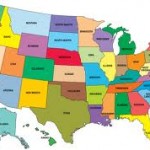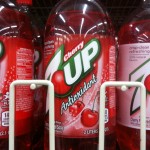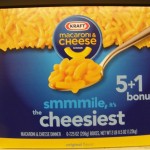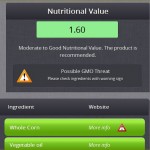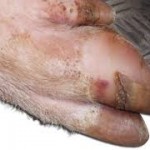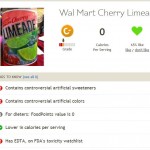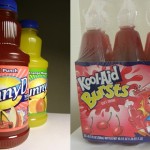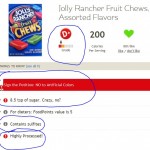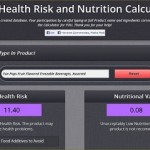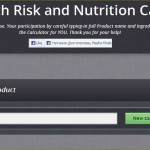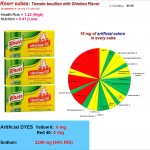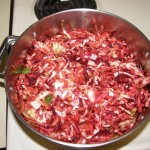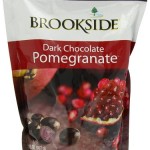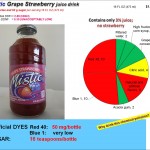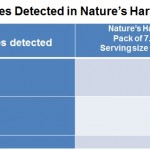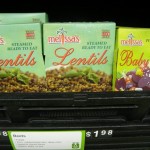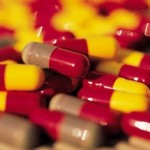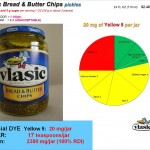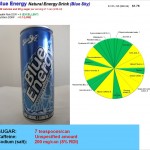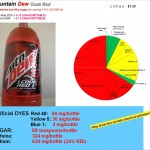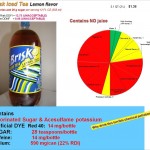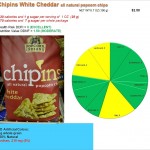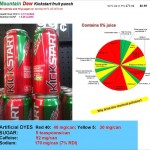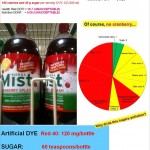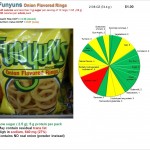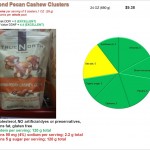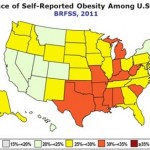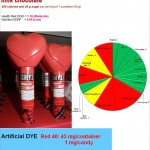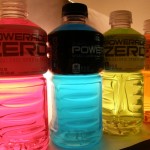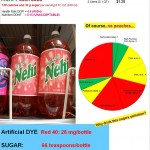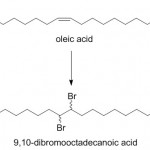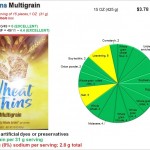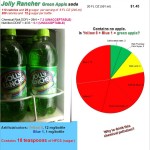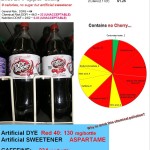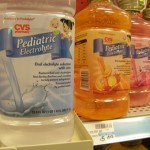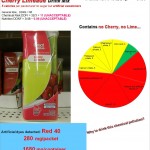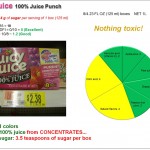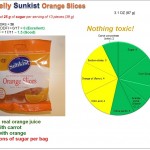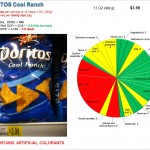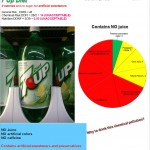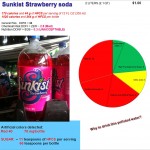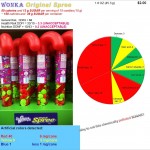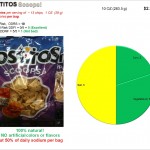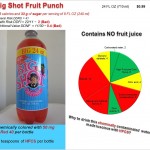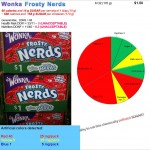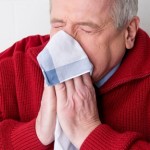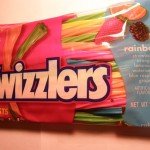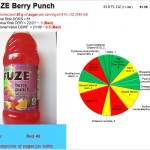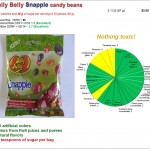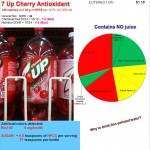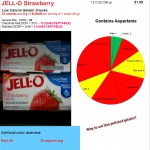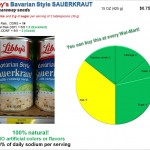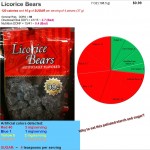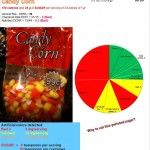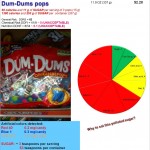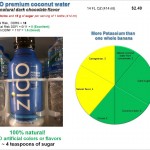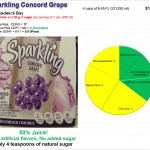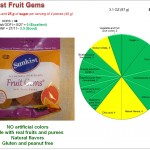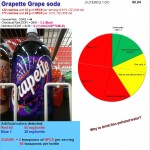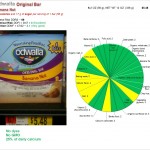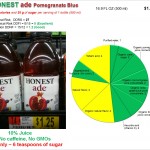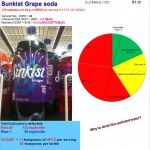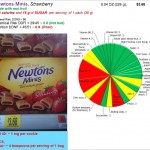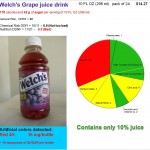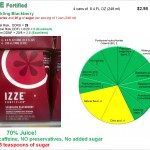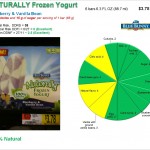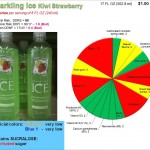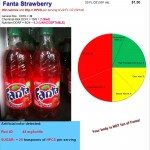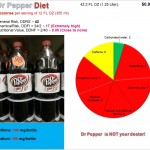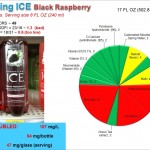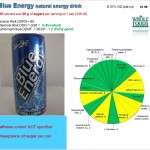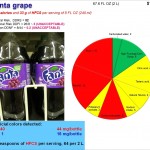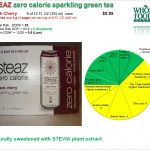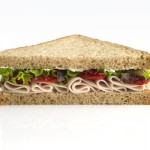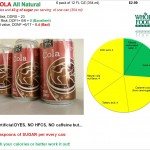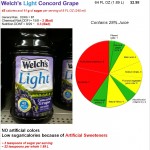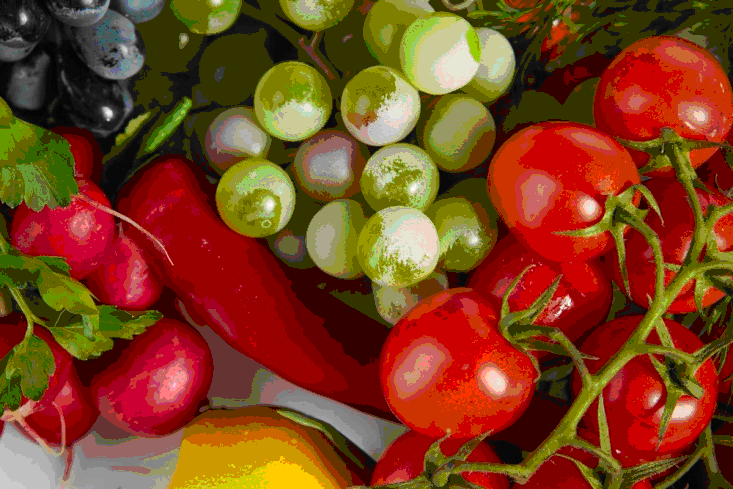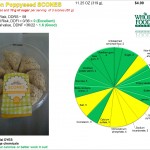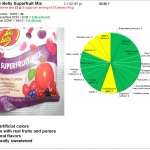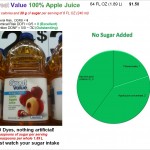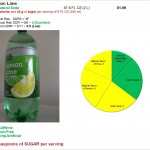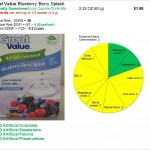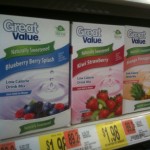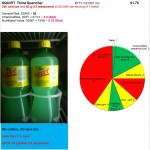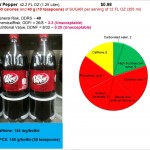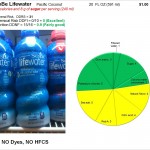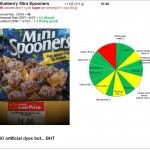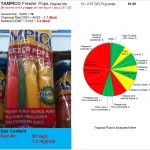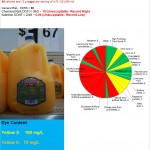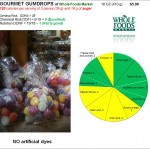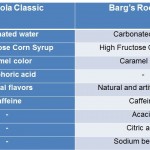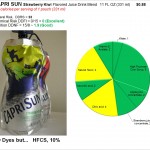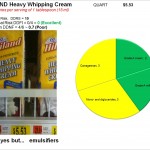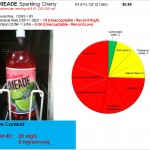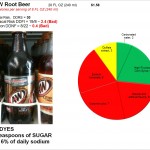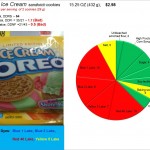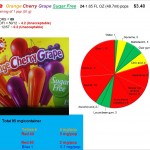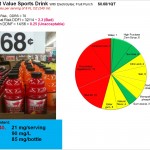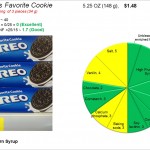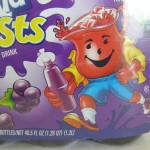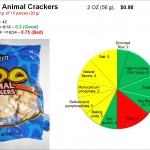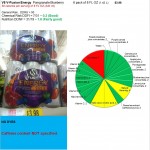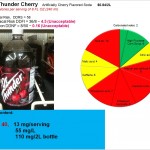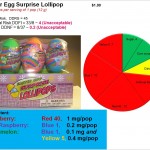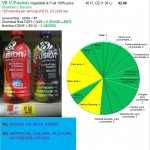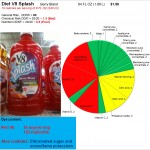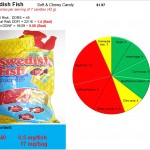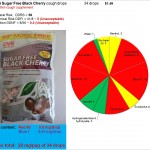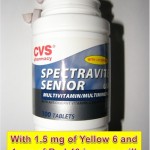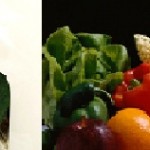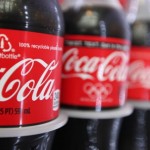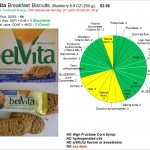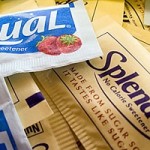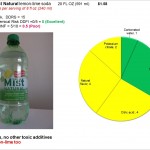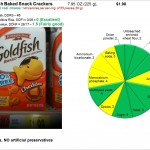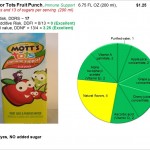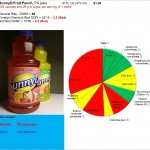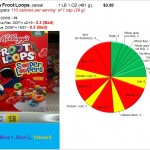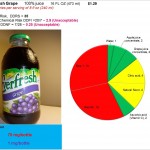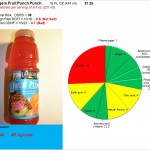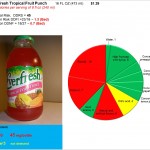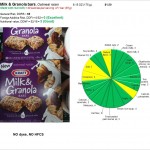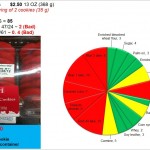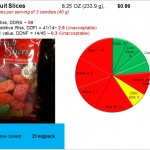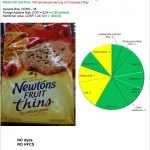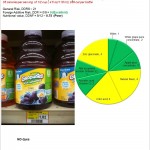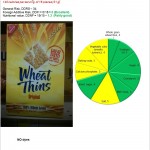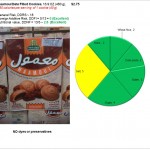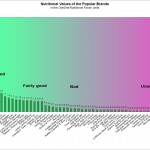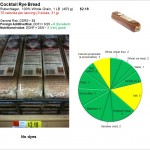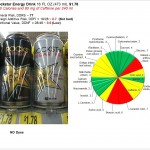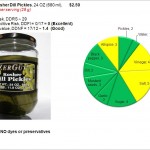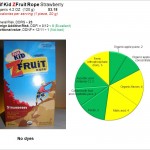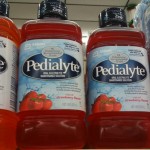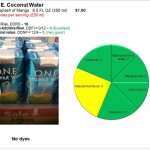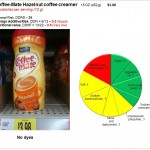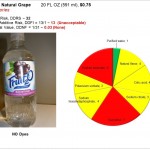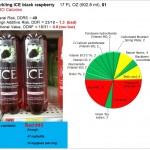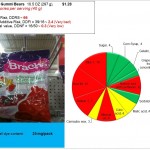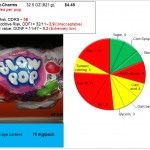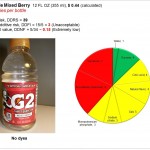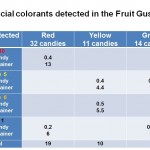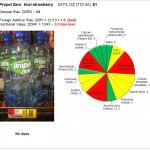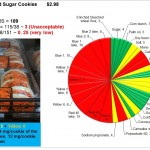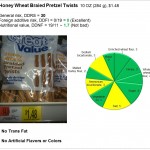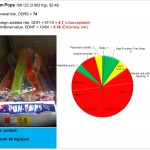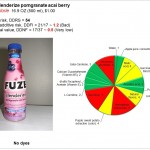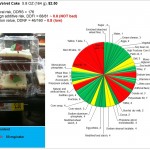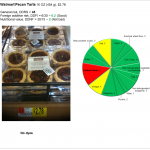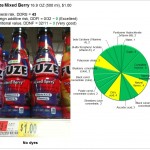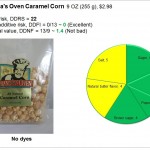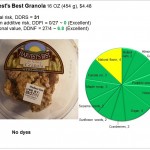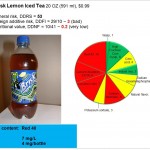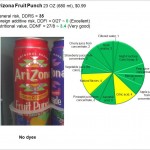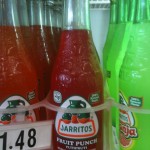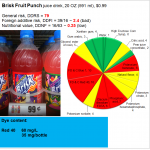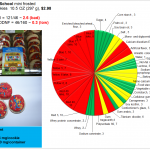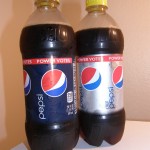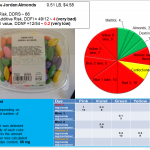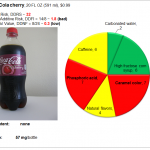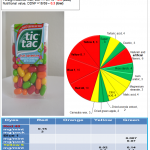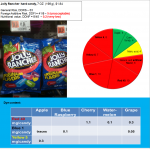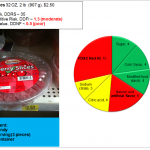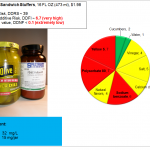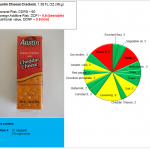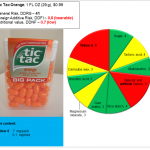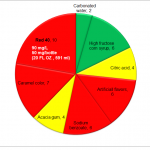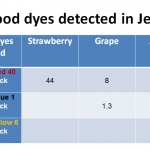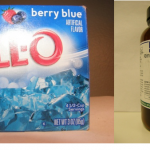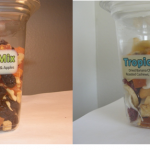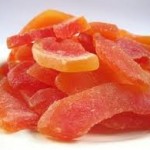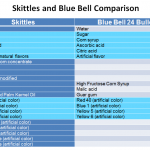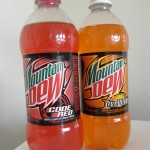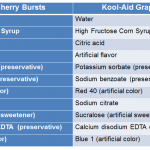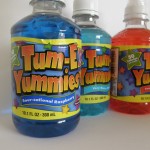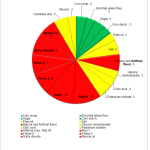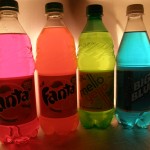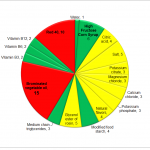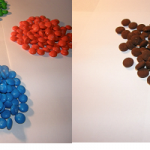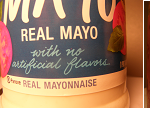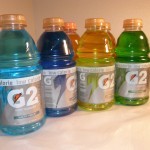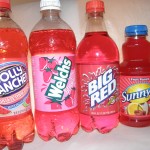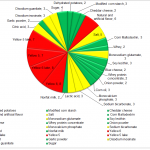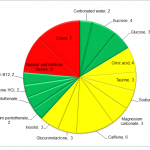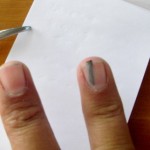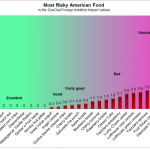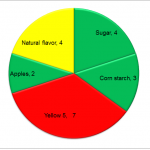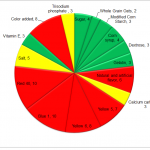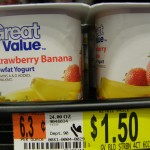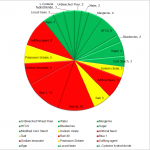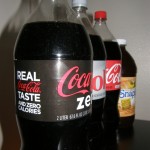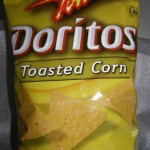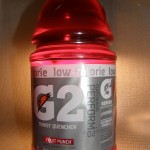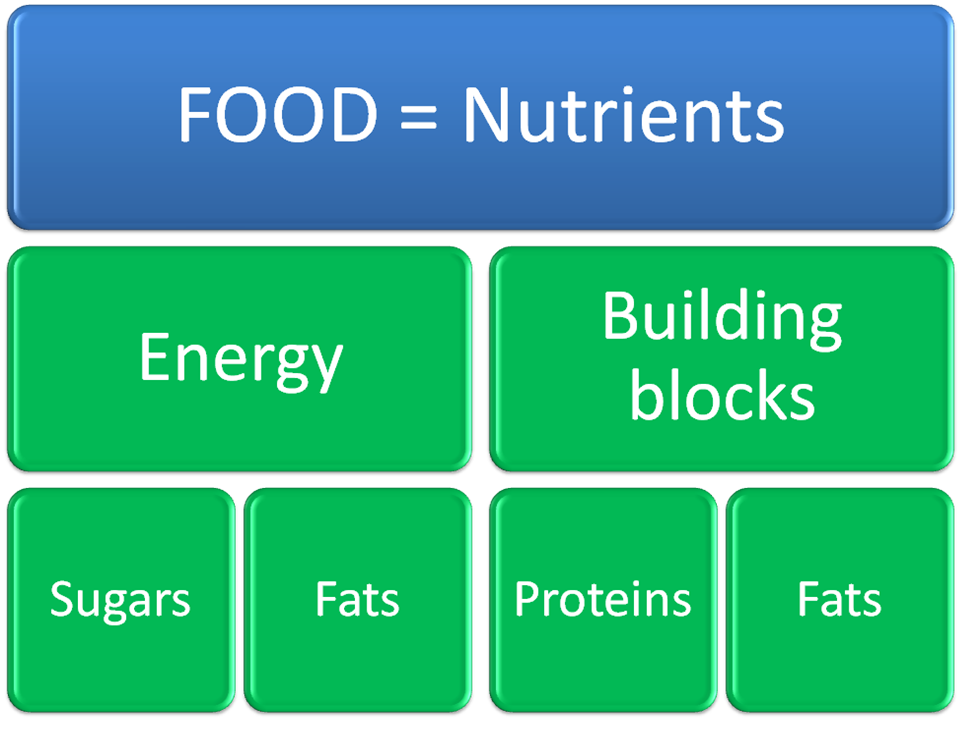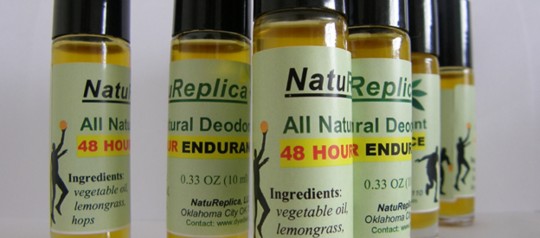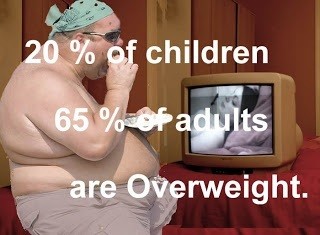The connection between pesticides use and cancer rates in Argentina
REPORT: Eating raw garlic twice a week HALVES the risk of developing lung cancer
By Pat Hagan , August 6, 2013
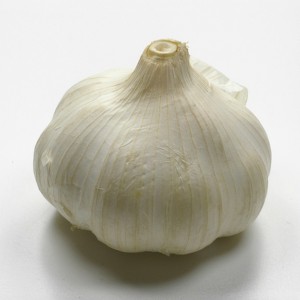 Eating raw garlic just twice a week can almost halve the risk of lung cancer, new research shows. A study carried out in China found adults regularly consuming raw garlic as part of their diet were 44 per cent less likely to suffer the disease. Even when researchers allowed for whether people smoked – the biggest single cause of lung cancer – they found garlic still seemed to reduce the dangers by around 30 per cent. Around 40,000 people a year are diagnosed with lung cancer in England and Wales alone. Smoking is thought to cause at least 80 per cent of cases and fewer than one in ten sufferers are still alive five years after their diagnosis. Previous studies have suggested garlic can protect the lungs against various conditions, as well as ward off other malignancies such as bowel cancer. – Mail Online
Eating raw garlic just twice a week can almost halve the risk of lung cancer, new research shows. A study carried out in China found adults regularly consuming raw garlic as part of their diet were 44 per cent less likely to suffer the disease. Even when researchers allowed for whether people smoked – the biggest single cause of lung cancer – they found garlic still seemed to reduce the dangers by around 30 per cent. Around 40,000 people a year are diagnosed with lung cancer in England and Wales alone. Smoking is thought to cause at least 80 per cent of cases and fewer than one in ten sufferers are still alive five years after their diagnosis. Previous studies have suggested garlic can protect the lungs against various conditions, as well as ward off other malignancies such as bowel cancer. – Mail Online
Failure to Protect Children and Families From Hazardous Pesticide Drift
July 24, 2013
 San Francisco, CA – Today, a coalition of farmworker, public health, and conservation advocates filed a challenge in the Ninth Circuit U.S. Court of Appeals to force the Environmental Protection Agency (EPA) to protect children from unsafe exposures to toxic pesticides. The suit seeks an answer to a petition that the advocates filed with the agency in 2009, urging EPA to set safety standards protecting children who grow up near farms from the harmful effects of pesticide drift. “It is not acceptable that our own government has so little regard for the health of our children,” said Janette Brimmer, an Earthjustice attorney representing the coalition “The government hasn’t even bothered to prepare a response to our requests.” “As a mother, I’m appalled the EPA is failing to protect our children from dangerous pesticides,” said Bonnie Wirtz, a Minnesota mother who endured negative health effects when the pesticide chlorpyrifos drifted into her home as it was sprayed on a nearby alfalfa field. Chlorpyrifos has been implicated in long-term health problems, including learning disabilities and other nervous system harms. – EARTHJUSTICE
San Francisco, CA – Today, a coalition of farmworker, public health, and conservation advocates filed a challenge in the Ninth Circuit U.S. Court of Appeals to force the Environmental Protection Agency (EPA) to protect children from unsafe exposures to toxic pesticides. The suit seeks an answer to a petition that the advocates filed with the agency in 2009, urging EPA to set safety standards protecting children who grow up near farms from the harmful effects of pesticide drift. “It is not acceptable that our own government has so little regard for the health of our children,” said Janette Brimmer, an Earthjustice attorney representing the coalition “The government hasn’t even bothered to prepare a response to our requests.” “As a mother, I’m appalled the EPA is failing to protect our children from dangerous pesticides,” said Bonnie Wirtz, a Minnesota mother who endured negative health effects when the pesticide chlorpyrifos drifted into her home as it was sprayed on a nearby alfalfa field. Chlorpyrifos has been implicated in long-term health problems, including learning disabilities and other nervous system harms. – EARTHJUSTICE
Were 98 million Americans injected with vaccines containing cancer virus?
By Lance Johnson; July 30, 2013
 The Centers for Disease Control recently published valuable information about polio vaccines on their site, but afterwards retracted the information. Why has that information been taken down? Regardless, a Google snapshot of this information as it appeared on July 11, 2013 is cached here: http://webcache.googleusercontent.com The saved CDC information comes right out and admits that more than 98 million Americans during a span of eight years were injected with a cancer-causing polyomavirus called SV40. This fact alone should serve as a testament to anyone: always question medical professionals who say that you or your child needs a certain vaccine or prescription. So much “medicine” today is actually poison. Professionals are often duped into believing in the safety of a vaccine or prescription, when all along it may be laced with cancer-causing, health ravaging virus, heavy metals, fungus, formaldehyde, or neurotoxins. NaturalNews
The Centers for Disease Control recently published valuable information about polio vaccines on their site, but afterwards retracted the information. Why has that information been taken down? Regardless, a Google snapshot of this information as it appeared on July 11, 2013 is cached here: http://webcache.googleusercontent.com The saved CDC information comes right out and admits that more than 98 million Americans during a span of eight years were injected with a cancer-causing polyomavirus called SV40. This fact alone should serve as a testament to anyone: always question medical professionals who say that you or your child needs a certain vaccine or prescription. So much “medicine” today is actually poison. Professionals are often duped into believing in the safety of a vaccine or prescription, when all along it may be laced with cancer-causing, health ravaging virus, heavy metals, fungus, formaldehyde, or neurotoxins. NaturalNews
The Health Risks of Genetically Modified Corn
By Caitlin Shetterly, July 24, 2013
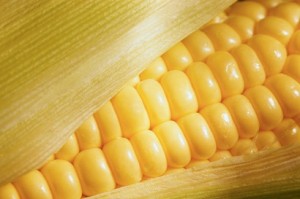 With symptoms including headaches, nausea, rashes, and fatigue, Caitlin Shetterly visited doctor after doctor searching for a cure for what ailed her. What she found, after years of misery and bafflement, was as unlikely as it was utterly common… During that time, when I wasn’t working as a writer and theater director or being a wife and mother, I visited doctors and had tests. I told few friends or members of my extended family how ill I was, because I didn’t have any way to explain what was wrong. I had no diagnosis, just a collection of weird symptoms: tight, achy pain that radiated through my body and caused me to hobble around (my ankles, I’d joke to my husband, Dan, felt like they’d been “Kathy Batesed,” à la the movie Misery); burning rashes that splashed across my cheeks and around my mouth like pizza sauce; exhaustion; headaches; hands that froze into claws while I slept and hurt to uncurl in the morning; a constant head cold; nausea; and, on top of all that, severe insomnia—my body just could not, would not, turn off and rest. I visited every doctor who’d see me and tried everything they threw at me: antidepressants; painkillers; elimination diets (including a long eight months when I went without any of the major allergens, such as gluten, nuts, dairy, soy, and nightshades); herbal supplements; iodine pills; steroid shots; hormone treatments; Chinese teas; acupuncture; energy healing; a meditation class—you name it, I did it. Nothing worked… – Elle
With symptoms including headaches, nausea, rashes, and fatigue, Caitlin Shetterly visited doctor after doctor searching for a cure for what ailed her. What she found, after years of misery and bafflement, was as unlikely as it was utterly common… During that time, when I wasn’t working as a writer and theater director or being a wife and mother, I visited doctors and had tests. I told few friends or members of my extended family how ill I was, because I didn’t have any way to explain what was wrong. I had no diagnosis, just a collection of weird symptoms: tight, achy pain that radiated through my body and caused me to hobble around (my ankles, I’d joke to my husband, Dan, felt like they’d been “Kathy Batesed,” à la the movie Misery); burning rashes that splashed across my cheeks and around my mouth like pizza sauce; exhaustion; headaches; hands that froze into claws while I slept and hurt to uncurl in the morning; a constant head cold; nausea; and, on top of all that, severe insomnia—my body just could not, would not, turn off and rest. I visited every doctor who’d see me and tried everything they threw at me: antidepressants; painkillers; elimination diets (including a long eight months when I went without any of the major allergens, such as gluten, nuts, dairy, soy, and nightshades); herbal supplements; iodine pills; steroid shots; hormone treatments; Chinese teas; acupuncture; energy healing; a meditation class—you name it, I did it. Nothing worked… – Elle
Why is thyroid cancer the fastest rising cancer in women?
By Lisa Collier Cool, July 24, 2013
 Tana Amen, RN was 23 and Charlie Nox was 29 when they were diagnosed with thyroid cancer—now the fastest rising cancer among women. Not only have rates of the disease soared by 240 percent over the past 20 years, but it’s expected to become the third most common cancer in the US by 2019, according to Julie Ann Sosa, MD FACS, chief, section of endocrine surgery and director of health services research, department of surgery, at Duke University School of Medicine. This year, more than 60,000 Americans—including more than 45,000 women—will be diagnosed with the disease, which typically targets people under age 55. Another scary fact: about 2 percent of cases occur in children and teens, the American Cancer Society reports. “Almost all of the increase is papillary thyroid cancer, which used to account for 80 percent of thyroid cancer cases and has recently risen to 90 percent,” reports Dr. Sosa. The disease occurs in the thyroid: a butterfly-shaped gland in the neck just below the Adam’s apple. – Yahoo! Health
Tana Amen, RN was 23 and Charlie Nox was 29 when they were diagnosed with thyroid cancer—now the fastest rising cancer among women. Not only have rates of the disease soared by 240 percent over the past 20 years, but it’s expected to become the third most common cancer in the US by 2019, according to Julie Ann Sosa, MD FACS, chief, section of endocrine surgery and director of health services research, department of surgery, at Duke University School of Medicine. This year, more than 60,000 Americans—including more than 45,000 women—will be diagnosed with the disease, which typically targets people under age 55. Another scary fact: about 2 percent of cases occur in children and teens, the American Cancer Society reports. “Almost all of the increase is papillary thyroid cancer, which used to account for 80 percent of thyroid cancer cases and has recently risen to 90 percent,” reports Dr. Sosa. The disease occurs in the thyroid: a butterfly-shaped gland in the neck just below the Adam’s apple. – Yahoo! Health
REPORT: Cancer is Serious Business, Part II
July 15, 2013
Stanislaw Burzynski, MD, PhD, a Texas-based physician and biochemist, developed (with his own money) a nontoxic gene-targeted cancer therapy called Antineoplastons. This therapy has been shown to help cure some of the most “incurable” forms of terminal cancer. In the 1980s–and again in 2012–the Texas Medical Board (TMB) charged this caring and pioneering doctor with breaking a law that didn’t actually exist, and tried to revoke his medical license. Numerous investigations later—including an appearance before the Texas Supreme Court—found no violation of any law or standard of care. A stunning documentary on Dr. Burzynski’s fight has won numerous awards worldwide. And now, Dr. Burzynski’s story continues in the compelling follow-up film: Burzynski—Cancer Is Serious Business, Part II. This second film details his continued struggles and victories, and explores the current status of Antineoplastons’ clinical testing and the patients it has helped save. – Alliance for Natural Health
Going Gluten-Free May Not Be the Greatest Thing
By Lisa Gibson
 …In our culture, we love to label foods “good” or “bad” because that makes it easier to embrace or refuse them. Gluten has now become one of those “bad” foods, joining trans fats, high-fructose corn syrup, red meat and dairy as an ingredient to avoid. Identifying a food as “bad” and making a conscious effort to avoid it is a major principle of many fad diets. Since gluten really does make some people very sick, it’s become the newest fad diet poster child… Why do people claim to feel better when they eliminate gluten from their diets? It could simply be that when they gave up gluten their diets were laden with mostly refined white flour foods, and eating more fruits and vegetables made them feel better. Or, it could be the placebo effect, since believing you’re doing something healthy can have a profound effect on your mental and physical state… For those following the gluten-free fad, I think it’s time to look at other ways to improve your diet. Grains such as whole wheat, oats and barley provide nutrition essentials such as fiber, B vitamins and vitamin E. Taking away whole grains from your diet—if you don’t need to—does more harm than good. Throw away the donuts, but keep the whole wheat bread. – Take Part
…In our culture, we love to label foods “good” or “bad” because that makes it easier to embrace or refuse them. Gluten has now become one of those “bad” foods, joining trans fats, high-fructose corn syrup, red meat and dairy as an ingredient to avoid. Identifying a food as “bad” and making a conscious effort to avoid it is a major principle of many fad diets. Since gluten really does make some people very sick, it’s become the newest fad diet poster child… Why do people claim to feel better when they eliminate gluten from their diets? It could simply be that when they gave up gluten their diets were laden with mostly refined white flour foods, and eating more fruits and vegetables made them feel better. Or, it could be the placebo effect, since believing you’re doing something healthy can have a profound effect on your mental and physical state… For those following the gluten-free fad, I think it’s time to look at other ways to improve your diet. Grains such as whole wheat, oats and barley provide nutrition essentials such as fiber, B vitamins and vitamin E. Taking away whole grains from your diet—if you don’t need to—does more harm than good. Throw away the donuts, but keep the whole wheat bread. – Take Part
Fish and Prostate Cancer Risk: Fact or Fiction
By William Faloon, Luke Huber, ND, MBA, Kira Schmid, ND, Blake Gossard, Scott Fogle, ND, July 16, 2013
Several scientific studies have found a reduction in prostate cancer associated with increased omega-3 intake.1-11 A recent report purportedly showed the opposite.12 This report was based on a single blood test of plasma fatty acids in a group of 834 men who were followed up to six years to assess prostate cancer risk (low- and high-grade disease). A smaller group of 75 men was followed up to nine years to assess only high-grade prostate cancer risk. The results showed that slightly higher omega-3 plasma percentages from this single blood test were associated with a greater risk of low-grade (44%) and high-grade (71%) prostate cancers over the multi-year follow-up. This report was turned into news stories with headlines blaring “Omega-3 fatty acids may raise prostate cancer risk.” Omitted from the media frenzy was the fact that this study was not about fish oil supplement users. The authors admitted they did not know how the study participants achieved what turned out to be very low omega-3 plasma percentages in all groups. – LifeExtension
Diet soda may do more harm than good
By Danielle Dellorto, July 10, 2013
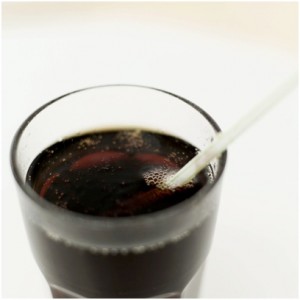 Purdue University researchers reviewed a dozen studies published in past five years that examined the relationship between consuming diet soda and health outcomes. They then published an opinion piece on their findings in the journal Trends in Endocrinology & Metabolism, saying they were “shocked” by the results.”Honestly, I thought that diet soda would be marginally better compared to regular soda in terms of health,” said Susan Swithers, the report’s author and a behavioral neuroscientist and professor of psychological sciences. “But in reality it has a counterintuitive effect.” Artificial sweeteners in diet soda fulfill a person’s craving for a sweet taste, without the calories. But that’s the problem, according to researchers. Think of it like crying wolf. The fake sugar in diet sodas teases your body by pretending to give it real food. But when your body doesn’t get the things it expects to get, it becomes confused on how to respond. While the studies they reviewed only looked at diet soft drinks, the researchers suggest that this could apply to other products that contain artificial sweeteners as well. Diet soda drinkers also tend to pack on more pounds than those who don’t drink it, the report says.
Purdue University researchers reviewed a dozen studies published in past five years that examined the relationship between consuming diet soda and health outcomes. They then published an opinion piece on their findings in the journal Trends in Endocrinology & Metabolism, saying they were “shocked” by the results.”Honestly, I thought that diet soda would be marginally better compared to regular soda in terms of health,” said Susan Swithers, the report’s author and a behavioral neuroscientist and professor of psychological sciences. “But in reality it has a counterintuitive effect.” Artificial sweeteners in diet soda fulfill a person’s craving for a sweet taste, without the calories. But that’s the problem, according to researchers. Think of it like crying wolf. The fake sugar in diet sodas teases your body by pretending to give it real food. But when your body doesn’t get the things it expects to get, it becomes confused on how to respond. While the studies they reviewed only looked at diet soft drinks, the researchers suggest that this could apply to other products that contain artificial sweeteners as well. Diet soda drinkers also tend to pack on more pounds than those who don’t drink it, the report says.
“The taste of sweet does cause the release of insulin, which lowers blood sugar, and if carbohydrates are not consumed, it causes a drop in blood sugar, which triggers hunger and cravings for sugar,” says CNN diet and fitness expert Dr. Melina Jampolis.
The artificial sweeteners also dampen the “reward center” in your brain, which may lead you to indulge in more calorie-rich, sweet-tasting food, according to the report. – CNN Health
STUDY: Diet soda inked to obesity, diabetes and heart disease
By Shari Rudavsky, July 10, 2013
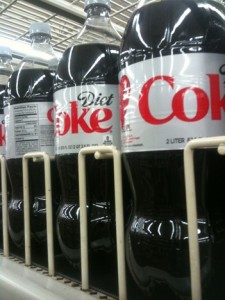 Diet soda, it turns out, may not be the panacea for weight loss that we all thought — and many of us hoped — it was. In fact, a Purdue University study has found that diet sodas may be linked to a number of health problems from obesity to diabetes to heart disease, just like their more sugary counterparts. Susie Swithers, a professor of psychological sciences and a behavioral neuroscientist, reviewed a number of recent studies looking at whether drinking diet soft drinks over the long-term increases the likelihood that a person will overeat, gain weight and then develop other health problems. One large study found that people who drank artificially sweetened soda were more likely to experience weight gain than those who drank non-diet soda. Others found those who drank diet soda had twice the risk of developing metabolic syndrome, often a precursor to cardiovascular disease, than those who abstained. Surprisingly, some of the studies suggested diet soda may be just as bad for our health as non-diet. “Are diet sodas worse for you than regular sodas? I think that’s the wrong question,” said Swithers, who is also a member of Purdue’s Ingestive Behavior Research Center. “It’s, ‘What good are sodas for you in the first place?’ ” The studies included drinks containing aspartame, sucralose and saccharin. About 30 percent of American adults regularly consume these sweeteners. – USA Today
Diet soda, it turns out, may not be the panacea for weight loss that we all thought — and many of us hoped — it was. In fact, a Purdue University study has found that diet sodas may be linked to a number of health problems from obesity to diabetes to heart disease, just like their more sugary counterparts. Susie Swithers, a professor of psychological sciences and a behavioral neuroscientist, reviewed a number of recent studies looking at whether drinking diet soft drinks over the long-term increases the likelihood that a person will overeat, gain weight and then develop other health problems. One large study found that people who drank artificially sweetened soda were more likely to experience weight gain than those who drank non-diet soda. Others found those who drank diet soda had twice the risk of developing metabolic syndrome, often a precursor to cardiovascular disease, than those who abstained. Surprisingly, some of the studies suggested diet soda may be just as bad for our health as non-diet. “Are diet sodas worse for you than regular sodas? I think that’s the wrong question,” said Swithers, who is also a member of Purdue’s Ingestive Behavior Research Center. “It’s, ‘What good are sodas for you in the first place?’ ” The studies included drinks containing aspartame, sucralose and saccharin. About 30 percent of American adults regularly consume these sweeteners. – USA Today
90% of Americans Have a Nutrient Deficiency
By Dr. John Berardi, July 1, 2013
 Ever wonder if you have a nutritional deficiency? Chances are, you do. Sound a little extreme? Well, according to a 2011 report, nine out of 10 Americans fall short of key nutrients in their diets. You hear it all the time. From your mom, from dietitians, from doctors, from coaches. Just eat a “balanced diet,” and you’ll be fine. The problem that I have found is that, just like with Bigfoot, I’ve never really seen a completely balanced diet. And it’s not for a lack of trying. Back when I was a graduate student at the University of Western Ontario, I set out to find the mythical “balanced diet.” I analyzed the intake of nearly 600 fourth-year exercise and nutrition undergraduate students. Less than 10 percent of them met the minimum standards for a complete, balanced diet. The most common deficiencies were zinc, magnesium, vitamin D, omega 3 fatty acids, and protein. – LiveStrong
Ever wonder if you have a nutritional deficiency? Chances are, you do. Sound a little extreme? Well, according to a 2011 report, nine out of 10 Americans fall short of key nutrients in their diets. You hear it all the time. From your mom, from dietitians, from doctors, from coaches. Just eat a “balanced diet,” and you’ll be fine. The problem that I have found is that, just like with Bigfoot, I’ve never really seen a completely balanced diet. And it’s not for a lack of trying. Back when I was a graduate student at the University of Western Ontario, I set out to find the mythical “balanced diet.” I analyzed the intake of nearly 600 fourth-year exercise and nutrition undergraduate students. Less than 10 percent of them met the minimum standards for a complete, balanced diet. The most common deficiencies were zinc, magnesium, vitamin D, omega 3 fatty acids, and protein. – LiveStrong
Glyphosate (Roundup) Carcinogenic In the PARTS PER TRILLION Range
By Sayer Ji, Founder, June 13th 2013
An alarming new study, accepted for publication in the journal Food and Chemical Toxicology last month, indicates that glyphosate, the world’s most widely used herbicide due to its widespread use in genetically engineered agriculture, is capable of driving estrogen receptor mediated breast cancer cell proliferation within the infinitesimal parts per trillion concentration range.[i] The study, titled, “Glyphosate induces human breast cancer cells growth via estrogen receptors,” compared the effect of glyphosate on hormone-dependent and hormone-independent breast cancer cell lines, finding that glyphosate stimulates hormone-dependent cancer cell lines in what the study authors describe as “low and environmentally relevant concentrations.” – GreenMedInfo
How supersized portions cost the earth
By Rachel Smith, July 4, 2013
We’re all familiar with the phrase “waste not, want not,” but how well are we applying these words today? For many of us, we buy more than we need, we spend more than we earn, we eat more than our fill. The consequence of excessive living and waste affect not only us, but also our global neighbors and future generations. Over the past two decades, food waste and obesity have nearly doubled at equal rates. The surface area of the average dinner plate expanded by 36 percent between 1960 and 2007. Parallel to increased portion sizes, between 1987 and 2010, the number of Americans diagnosed with diabetes almost tripled to 20.9 million. While we are responsible for our own choices, the results we are experiencing aren’t merely a matter of choice. We are not genetically programmed to turn down excess calories when they are in front of us. Studies have shown that if our plate contains more food than our body physically needs, we will eat it without conscious consideration. A recent study shows 50 percent of all food produced on the planet goes in the trash. – CNN
Report: GMO Myths and Truths 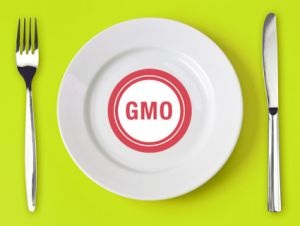
An evidence-based examination of the claims made for the safety and efficacy of genetically modified crops (PDF file)
Pepsi Isn’t Sexy: Watch your cancer risk
By Kathleen Lees, July 3, 2013
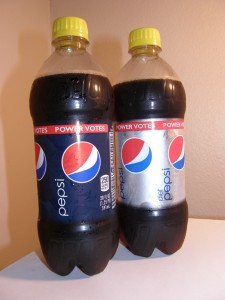 As sleek, sexy and patriotic as a can of Pepsi may appear, turns out, a cancer-causing-ingredient may be lurking inside the container. According to the Center for Environmental Health, the caramel coloring used in Pepsi possibly contains a high level of a carcinogen despite the soda company’s claims that this chemical was removed. In fact, the group even said that Pepsi bought from over 10 different states contained 4-methylimidazole, or 4-Mel (the caramel-coloring ingredient). Though the company alleged that its caramel coloring suppliers are changing their manufacturing process to cut the amount of the chemical found in the product, they did not indicate a timeline. – Science World Report
As sleek, sexy and patriotic as a can of Pepsi may appear, turns out, a cancer-causing-ingredient may be lurking inside the container. According to the Center for Environmental Health, the caramel coloring used in Pepsi possibly contains a high level of a carcinogen despite the soda company’s claims that this chemical was removed. In fact, the group even said that Pepsi bought from over 10 different states contained 4-methylimidazole, or 4-Mel (the caramel-coloring ingredient). Though the company alleged that its caramel coloring suppliers are changing their manufacturing process to cut the amount of the chemical found in the product, they did not indicate a timeline. – Science World Report
See also: Pepsi: Risk and Nutrition
11 Banned Ingredients We Eat in the U.S
By The Daily Meal, July 2, 2013
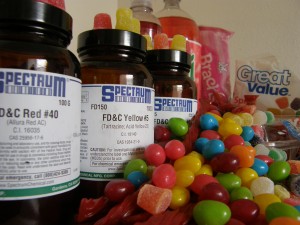 We sure do love unhealthy food in the U.S. Eleven ingredients considered unhealthy and dangerous are banned in countries around the world. But not in the U.S. In fact, those ingredients are found in food and drink that Americans consume regularly, according to ABC News. The banned ingredients include:
We sure do love unhealthy food in the U.S. Eleven ingredients considered unhealthy and dangerous are banned in countries around the world. But not in the U.S. In fact, those ingredients are found in food and drink that Americans consume regularly, according to ABC News. The banned ingredients include:
1. Blue #1 food coloring 2. Blue # 2 food coloring 3. Yellow # 5 food coloring 4. Yellow # 6 food coloring 5. Red #40 food coloring 6. Brominated vegetable oil (found in sodas) 7. Bromated flour (used in baking) 8. Olean (found in potato chips) 9. Preservatives butylated hydroxyanisole (BHA) and butylated hydroxytoluene (BHT) 10. Growth hormones rBGH and rBST (found in dairy products) 11. Arsenic found in chicken feed – Yahoo! Shine
10 things we eat that are banned elsewhere
By Gina Roberts-Gray, June 27, 2013
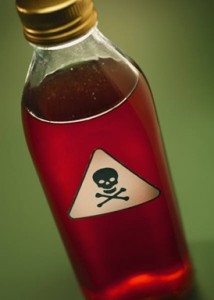 We may live in the “land of the free” and the “home of the brave” but America’s national anthem might need a tweaking to include lyrics like “home of banned foods.” That’s because the shelves and refrigerated sections of our local grocers are stocked with foods that scientists and health officials across the pond and around the world wouldn’t dream of letting cross their residents’ lips. But here in America, going grocery shopping gives new meaning to the term “food poisoning” since several staples in the American diet contain chemicals, additives and ingredients banned by China, Australia, the European Union and other countries. Here’s a look at some of the most notorious foods and food additives available in America but banned elsewhere. – MSN Healthy Living
We may live in the “land of the free” and the “home of the brave” but America’s national anthem might need a tweaking to include lyrics like “home of banned foods.” That’s because the shelves and refrigerated sections of our local grocers are stocked with foods that scientists and health officials across the pond and around the world wouldn’t dream of letting cross their residents’ lips. But here in America, going grocery shopping gives new meaning to the term “food poisoning” since several staples in the American diet contain chemicals, additives and ingredients banned by China, Australia, the European Union and other countries. Here’s a look at some of the most notorious foods and food additives available in America but banned elsewhere. – MSN Healthy Living
Schools, say goodbye to junk food!
By William Hudson and Jacque Wilson, June 27, 2013
 Candy bars, doughnuts and regular potato chips will become scarce in schools under new federal rules released Thursday, replaced by healthier options such as granola bars, trail mix and baked chips. The U.S. Department of Agriculture’s new “Smart Snacks in School” nutrition standards represent the first nutritional overhaul of school snacks in more than 30 years. The regulations set limits for fat, salt and sugar sold in places such as vending machines and snack bars. School foods must contain at least 50% whole grains or have a fruit, vegetable, dairy or protein as the first ingredient. Foods that contain at least ¼ cup of fruit and/or vegetables will also be allowed. Beverages will be under the microscope as well. Sports drinks, which contain relatively high amounts of sugar, are prohibited. Low-fat and fat-free milk, 100% fruit and vegetable juice, and no-calorie flavored waters are permitted. Potable water must be made available to kids for free where meals are served. – CNN Health
Candy bars, doughnuts and regular potato chips will become scarce in schools under new federal rules released Thursday, replaced by healthier options such as granola bars, trail mix and baked chips. The U.S. Department of Agriculture’s new “Smart Snacks in School” nutrition standards represent the first nutritional overhaul of school snacks in more than 30 years. The regulations set limits for fat, salt and sugar sold in places such as vending machines and snack bars. School foods must contain at least 50% whole grains or have a fruit, vegetable, dairy or protein as the first ingredient. Foods that contain at least ¼ cup of fruit and/or vegetables will also be allowed. Beverages will be under the microscope as well. Sports drinks, which contain relatively high amounts of sugar, are prohibited. Low-fat and fat-free milk, 100% fruit and vegetable juice, and no-calorie flavored waters are permitted. Potable water must be made available to kids for free where meals are served. – CNN Health
You Won’t Believe What Pork Producers Do to Pregnant Pigs
By Tom Philpott
 Like a lot of food-obsessed people, I love pork. The chef David Chang, whose Manhattan restaurant Momofuku is practically a porcine temple, once declared the pig a “mystical, magical animal.” In addition to being delicious, pigs are profoundly smart and social creatures that can even be taught to play simple video games with their snouts. Yet despite pigs’ many lovable qualities, of all the billions of beasts confined in our meat factories, the most miserable may be the 5.9 million sows that churn out the piglets that grow into chops, bacon, and ham. Throughout their four-month pregnancies, many of these sows live in cages just large enough to contain their bodies. As the sows grow bigger, the tight confinement means they can lie face down but can’t flop over onto their sides. The floors under these “gestation crates” are slotted so that urine and feces can slip through into vast cesspits. Immobilized above their own waste, the sows are exposed to high levels of ammonia, which causes respiratory problems. Just before they deliver, they’re moved to farrowing crates, in which they have just enough space to nurse. – Mother Jones
Like a lot of food-obsessed people, I love pork. The chef David Chang, whose Manhattan restaurant Momofuku is practically a porcine temple, once declared the pig a “mystical, magical animal.” In addition to being delicious, pigs are profoundly smart and social creatures that can even be taught to play simple video games with their snouts. Yet despite pigs’ many lovable qualities, of all the billions of beasts confined in our meat factories, the most miserable may be the 5.9 million sows that churn out the piglets that grow into chops, bacon, and ham. Throughout their four-month pregnancies, many of these sows live in cages just large enough to contain their bodies. As the sows grow bigger, the tight confinement means they can lie face down but can’t flop over onto their sides. The floors under these “gestation crates” are slotted so that urine and feces can slip through into vast cesspits. Immobilized above their own waste, the sows are exposed to high levels of ammonia, which causes respiratory problems. Just before they deliver, they’re moved to farrowing crates, in which they have just enough space to nurse. – Mother Jones
Disappointing Results for Weight Loss And Diabetes
By JENNIFER CORBETT DOOREN, June 24, 2013
In a frustrating outcome, a long-term weight-loss program aimed at overweight adults with diabetes didn’t cut the rate of heart attacks and strokes, a major study showed. But losing weight did provide at least one major benefit by cutting the development of chronic kidney disease, a leading cause of premature death in people with Type 2 diabetes. It also showed some ancillary benefits like cutting medicine use, depression and hospitalizations. Doctors said the finding shouldn’t discourage people—particularly those with diabetes—from exercising and eating a healthy diet. Several other studies have shown that exercise and a healthy diet can prevent people at risk for Type 2 diabetes, the most common form of the disease, from getting the disease. – The Wall Street Journal
Is Nicotine Really Any Different Than Caffeine?
By Catherine Hollander, June 20, 2013
 For well over 100 years, tobacco companies have had a product people loved, with a toxic catch. Cigarettes don’t just cause cancer (of the lung, throat, mouth, pancreas, bladder, nose, and more); they can also lead to heart attacks, strokes, and autoimmune diseases. Some 443,000 Americans die from smoking each year. But 44 million Americans still smoke because, as the tobacco companies know, cigarettes deliver an addictive, pleasurable drug: nicotine. Now the three biggest tobacco companies have a new, tobacco-free way to deliver nicotine. Enthusiasts say “vaping” an e-cigarette—which relies on battery power to vaporize a liquid nicotine solution that the user inhales—delivers all the biochemical rewards and none of the lethal risks, and that it’s time to regulate nicotine like coffee, another stimulant. But can they convince their opponents? “We’re seeing a radical change in how people sell nicotine to the human brain,” says David Abrams, executive director of the Schroeder Institute for Tobacco Research and Policy Studies at the American Legacy Foundation. …A “poly-caffeine dilettante” is easy to imagine. People shift easily from morning coffees to mid-morning lattes to midday energy drinks to late-afternoon Frappuccinos. E-proponents want you to remember how readily you order another cup of coffee as you think about the health effects of vaping. Both caffeine and nicotine can raise the heart rate, cause nausea, and even kill, but only in extraordinarily high doses that are hard to come by. “Nicotine has similar qualities as caffeine,” says Ray Story, head of the Tobacco Vapor Electronic Cigarette Association, an industry group. “The nicotine itself is not a deadly product.… If this product is sold within the parameters of what we feel is a responsible product, this product is basically harmless.” – National Journal
For well over 100 years, tobacco companies have had a product people loved, with a toxic catch. Cigarettes don’t just cause cancer (of the lung, throat, mouth, pancreas, bladder, nose, and more); they can also lead to heart attacks, strokes, and autoimmune diseases. Some 443,000 Americans die from smoking each year. But 44 million Americans still smoke because, as the tobacco companies know, cigarettes deliver an addictive, pleasurable drug: nicotine. Now the three biggest tobacco companies have a new, tobacco-free way to deliver nicotine. Enthusiasts say “vaping” an e-cigarette—which relies on battery power to vaporize a liquid nicotine solution that the user inhales—delivers all the biochemical rewards and none of the lethal risks, and that it’s time to regulate nicotine like coffee, another stimulant. But can they convince their opponents? “We’re seeing a radical change in how people sell nicotine to the human brain,” says David Abrams, executive director of the Schroeder Institute for Tobacco Research and Policy Studies at the American Legacy Foundation. …A “poly-caffeine dilettante” is easy to imagine. People shift easily from morning coffees to mid-morning lattes to midday energy drinks to late-afternoon Frappuccinos. E-proponents want you to remember how readily you order another cup of coffee as you think about the health effects of vaping. Both caffeine and nicotine can raise the heart rate, cause nausea, and even kill, but only in extraordinarily high doses that are hard to come by. “Nicotine has similar qualities as caffeine,” says Ray Story, head of the Tobacco Vapor Electronic Cigarette Association, an industry group. “The nicotine itself is not a deadly product.… If this product is sold within the parameters of what we feel is a responsible product, this product is basically harmless.” – National Journal
Diet products contain dangerous drugs, FDA warns
06/18/2013
Fat Zero sounds like a safe, natural product, containing bee pollen and other ingredients like green tea and lotus seed. But it also contains sibutramine, a prescription diet drug that was so dangerous it’s been pulled off the U.S. market, the Food and Drug Administration says. The FDA issued warnings about a batch of similar slimming products – all claiming to be natural, and all containing not only sibutramine, but phenolphthalein, a laxative that’s also been pulled out of pills because it might cause cancer. “Fat Zero will give your body the jump start it needs to lose those unwanted pounds,” the maker’s website promises. It sure will, says the FDA. But not because of its so-called natural ingredients. The sibutramine in it can damage the heart. “Sibutramine is a controlled substance that was removed from the market in October 2010 for safety reasons,” FDA says in a notice to consumers. “The product poses a threat to consumers because sibutramine is known to substantially increase blood pressure and/or pulse rate in some patients and may present a significant risk for patients with a history of coronary artery disease, congestive heart failure, arrhythmias, or stroke. This product may also interact, in life-threatening ways, with other medications a consumer may be taking.” Sibutramine affects several brain chemicals, including serotinin and norepinephrine. Scientists don’t quite understand how it causes weight loss – but in some people in can actually increase appetite. – NBC News
Surprise 91-year-old breaks world bench-press record
By Taylor Goldenstein, Jun 14, 2013
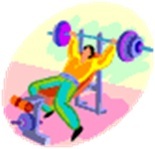 … The 91-year-old weightlifting champ stepped up to the firetruck-red bench at the front of the room. With a light push, Perlis rolled onto his back, reached for the metal bar above his head and hoisted the 187.2-pound weight over his chest. Perlis broke a World Association of Benchers and Deadlifters record in the 90-and-over age division on Saturday at the National Push-Pull Bench Press and Dead Lift Championships, which were held at the Embassy Suites Hotel in north Phoenix. The final lift broke an association record of 135 pounds that had been in place since 2005. At an age when some avoid exercise, Perlis has become an athlete, said association president and event organizer Gus Rethwisch… “It gave me the opportunity to do something to test myself for one thing, and I didn’t have to run around to do it, as you would in some other sports,” Perlis said of his hobby… It is a common misconception that exercise is unsafe for older people, said Chhanda Dutta, chief of the Clinical Gerontology Branch of the National Institute on Aging. Research shows that exercise reduces the likelihood a person will develop a chronic disease. For those who already have such diseases, it can improve symptoms, she added. – Azcentral.com
… The 91-year-old weightlifting champ stepped up to the firetruck-red bench at the front of the room. With a light push, Perlis rolled onto his back, reached for the metal bar above his head and hoisted the 187.2-pound weight over his chest. Perlis broke a World Association of Benchers and Deadlifters record in the 90-and-over age division on Saturday at the National Push-Pull Bench Press and Dead Lift Championships, which were held at the Embassy Suites Hotel in north Phoenix. The final lift broke an association record of 135 pounds that had been in place since 2005. At an age when some avoid exercise, Perlis has become an athlete, said association president and event organizer Gus Rethwisch… “It gave me the opportunity to do something to test myself for one thing, and I didn’t have to run around to do it, as you would in some other sports,” Perlis said of his hobby… It is a common misconception that exercise is unsafe for older people, said Chhanda Dutta, chief of the Clinical Gerontology Branch of the National Institute on Aging. Research shows that exercise reduces the likelihood a person will develop a chronic disease. For those who already have such diseases, it can improve symptoms, she added. – Azcentral.com
Are Quinoa, Chia Seeds, and Other “Superfoods” a Scam?
By Tom Philpott, June 2013
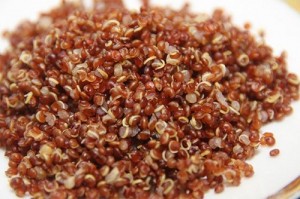 … Some of the super claims are true: Açaí berries, native to the Amazon rainforest, and goji berries, produced mostly in northern China, are indeed loaded with phytochemicals, plant compounds that seem to protect us from heart disease, brain deterioration, and cancer. And quinoa, the seed of a spinachlike plant grown in the Andes, really does offer a complete, high-quality vegetarian protein. Other boasts are, well, less true: Açaí and goji berries are not really miracle cures for everything from obesity to sexual dysfunction. Indeed, in 2006, the Food and Drug Administration reprimanded two different goji product manufacturers for making unsubstantiated health claims in violation of the Federal Food, Drug, and Cosmetic Act. Nor do all superfoods come from the pristine places that their packaging would suggest. One prominent US goji supplier, Navitas, calls its berries a “Himalayan superfruit,” but the company’s website reveals they’re a product of China, grown in the “lush, fertile valleys of the Ningxia Province.” That’s nowhere near Tibet—and, it turns out, most of the world’s goji berries hail from industrial fields in this region. – Mother Jones
… Some of the super claims are true: Açaí berries, native to the Amazon rainforest, and goji berries, produced mostly in northern China, are indeed loaded with phytochemicals, plant compounds that seem to protect us from heart disease, brain deterioration, and cancer. And quinoa, the seed of a spinachlike plant grown in the Andes, really does offer a complete, high-quality vegetarian protein. Other boasts are, well, less true: Açaí and goji berries are not really miracle cures for everything from obesity to sexual dysfunction. Indeed, in 2006, the Food and Drug Administration reprimanded two different goji product manufacturers for making unsubstantiated health claims in violation of the Federal Food, Drug, and Cosmetic Act. Nor do all superfoods come from the pristine places that their packaging would suggest. One prominent US goji supplier, Navitas, calls its berries a “Himalayan superfruit,” but the company’s website reveals they’re a product of China, grown in the “lush, fertile valleys of the Ningxia Province.” That’s nowhere near Tibet—and, it turns out, most of the world’s goji berries hail from industrial fields in this region. – Mother Jones
Google search to highlight nutrition info
By Jacque Wilson, May 31, 2013
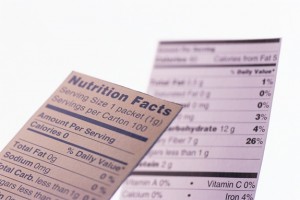 Eating right is no easy task, especially when there’s so much contradicting information online. Google is hoping to make it a little simpler by providing easy-to-see nutrition info for more than 1,000 foods. Similar to the way measurement conversions or flight prices pop up in a box at the top of your search results, Google will display the number of calories, fat grams and other key nutrition facts for everything from bananas to burritos. “You can simply ask, ‘How much protein is in a banana?’ or ‘How many calories are in an avocado?’ and get your answer right away,” Google product manager Ilya Mezheritsky wrote on the site’s blog. “You’ll hear the answer to your specific question, see relevant nutrition information under an expansion, and be able to switch to other related foods or serving sizes.” That’s right, he said “hear.” Using Google’s voice search feature, which the company introduced last month, you can ask your question out loud and get an response ASAP – CNN
Eating right is no easy task, especially when there’s so much contradicting information online. Google is hoping to make it a little simpler by providing easy-to-see nutrition info for more than 1,000 foods. Similar to the way measurement conversions or flight prices pop up in a box at the top of your search results, Google will display the number of calories, fat grams and other key nutrition facts for everything from bananas to burritos. “You can simply ask, ‘How much protein is in a banana?’ or ‘How many calories are in an avocado?’ and get your answer right away,” Google product manager Ilya Mezheritsky wrote on the site’s blog. “You’ll hear the answer to your specific question, see relevant nutrition information under an expansion, and be able to switch to other related foods or serving sizes.” That’s right, he said “hear.” Using Google’s voice search feature, which the company introduced last month, you can ask your question out loud and get an response ASAP – CNN
5 shocking truths about your healthy diet
By Realbuzz.com
 If you think you have a healthy diet you might be surprised by some of these shocking truths. From finding out that lard might be good for you to a study into herbal tea and its effects on your teeth, you’re bound to learn something new about the world of healthy living… If you thought that drinking a warming cup of herbal tea was doing wonders for your health, think again. Although herbal teas can contain antioxidants and are often considered healthier than a cup of tea or coffee, it turns out that some herbal teas can ruin your teeth. Keep reading… – Realbuzz.com
If you think you have a healthy diet you might be surprised by some of these shocking truths. From finding out that lard might be good for you to a study into herbal tea and its effects on your teeth, you’re bound to learn something new about the world of healthy living… If you thought that drinking a warming cup of herbal tea was doing wonders for your health, think again. Although herbal teas can contain antioxidants and are often considered healthier than a cup of tea or coffee, it turns out that some herbal teas can ruin your teeth. Keep reading… – Realbuzz.com
A Lost Soul: Man Describes Life With ‘Walking Corpse Syndrome’
By Katie Moisse, May 31, 2013
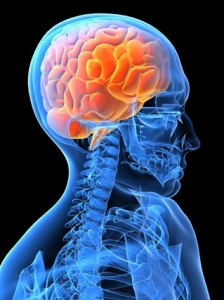 A man’s account of living with Cotard’s syndrome offers a chilling look at a rare condition that has patients convinced they’re zombies. The man, identified only as Graham in an interview with New Scientist, said he awoke from a suicide attempt feeling as though his brain were dead. “I just felt like my brain didn’t exist anymore,” Graham told the magazine, recalling his bizarre state of consciousness after surviving an attempt to electrocute himself in his bathtub. “I kept on telling the doctors that the tablets weren’t going to do me any good, because I didn’t have a brain. I’d fried it in the bath.” Graham was diagnosed with Cotard’s syndrome, a mysterious psychiatric condition marked by “the fixed and unshakable belief that one has lost organs, blood or body parts” or has no soul, according to a definition in a 2003 report in the journal Neurology. – ABC News
A man’s account of living with Cotard’s syndrome offers a chilling look at a rare condition that has patients convinced they’re zombies. The man, identified only as Graham in an interview with New Scientist, said he awoke from a suicide attempt feeling as though his brain were dead. “I just felt like my brain didn’t exist anymore,” Graham told the magazine, recalling his bizarre state of consciousness after surviving an attempt to electrocute himself in his bathtub. “I kept on telling the doctors that the tablets weren’t going to do me any good, because I didn’t have a brain. I’d fried it in the bath.” Graham was diagnosed with Cotard’s syndrome, a mysterious psychiatric condition marked by “the fixed and unshakable belief that one has lost organs, blood or body parts” or has no soul, according to a definition in a 2003 report in the journal Neurology. – ABC News
5 Surprising Truths About Calories
May 30, 2013
If you’ve been trying to lose weight, you’ve probably heard this rule: It’s just a matter of calories in, calories out. That is, simply burn more calories than you consume, and the pounds will melt off. Right? Well, not exactly. If you are trying to lose weight, then you know that it’s not that simple-or that easy. It turns out, some calories count more than others. Sure, there are 100 calories in two tablespoons of chocolate chips, and the very same 100 calories in broccoli. But there’s a huge difference in the way that they affect your appetite, your energy level, and your long-term health. Here are 5 surprising things you didn’t know about calories. Yahoo! Shine
Read more to the topic: Anti-sugar doctor Robert Lustig talks more about what’s wrong with the American diet
Kellogg pays for iffy Mini-Wheats claims
The company was accused of falsely advertising its popular cereal’s nutritional benefits to children.
By Bruce Kennedy , May 29, 2013
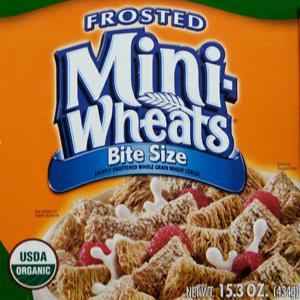 Kellogg will pay $4 million to settle a class-action lawsuit that accused the cereal giant of sugar-coating nutritional claims for its Frosted Mini-Wheats cereal.The lawsuit claimed Kellogg falsely advertised that Frosted Mini-Wheats “improved kids’ attentiveness, memory and other cognitive functions to a degree not supported by competent clinical evidence,” according to the website created for administration of the settlement. Consumers who bought Frosted Mini-Wheats in the U.S. between January 28, 2008 and October 1, 2009 can be reimbursed $5 per box of the cereal for up to three boxes. Any leftover settlement money will be donated to charity. The company denies any wrongdoing, saying that the advertising campaign at the heart of the settlement ran four years ago, according to Food Business News. Both sides originally agreed to a $10.6 million settlement — with Kellogg setting up funds for class action members as well as donating $5.5 million worth of products to charity, paying for legal fees and refraining from certain ad claims for a three-year period. – MSN Money
Kellogg will pay $4 million to settle a class-action lawsuit that accused the cereal giant of sugar-coating nutritional claims for its Frosted Mini-Wheats cereal.The lawsuit claimed Kellogg falsely advertised that Frosted Mini-Wheats “improved kids’ attentiveness, memory and other cognitive functions to a degree not supported by competent clinical evidence,” according to the website created for administration of the settlement. Consumers who bought Frosted Mini-Wheats in the U.S. between January 28, 2008 and October 1, 2009 can be reimbursed $5 per box of the cereal for up to three boxes. Any leftover settlement money will be donated to charity. The company denies any wrongdoing, saying that the advertising campaign at the heart of the settlement ran four years ago, according to Food Business News. Both sides originally agreed to a $10.6 million settlement — with Kellogg setting up funds for class action members as well as donating $5.5 million worth of products to charity, paying for legal fees and refraining from certain ad claims for a three-year period. – MSN Money
Diet soda erodes teeth as much as meth, crack: Case study
By Michelle Castillo, May 29, 2013
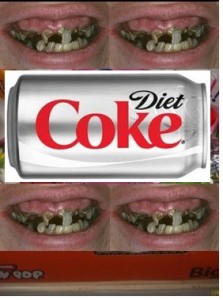 Drinking diet soda for years takes a toll on the teeth that’s comparable to years of smoking crystal meth or crack cocaine, according to a new case report from a dentistry journal. The report, published in General Dentistry on May 28, shows an addiction to soda may do as much major damage to your smile as a drug habit, and sugar isn’t even the culprit. Teeth are eroded when acid wears away tooth enamel, the glossy, protective layer of the tooth. Without this shield, teeth are more likely to develop cavities, become sensitive, develop cracks or become discolored. The case study looked at the damage in three people’s mouths. One subject was a 29-year-old admitted meth user, and the other person was a 51-year-old who abused cocaine for 18 years. The third patient drank an excessive amount of diet soda, about two liters a day for three to five years. All three had poor oral hygiene and did not visit the dentist on a regular basis. Despite three different substance habits, the subjects appeared to have the same types and severity of damage from tooth erosion. – CBS News
Drinking diet soda for years takes a toll on the teeth that’s comparable to years of smoking crystal meth or crack cocaine, according to a new case report from a dentistry journal. The report, published in General Dentistry on May 28, shows an addiction to soda may do as much major damage to your smile as a drug habit, and sugar isn’t even the culprit. Teeth are eroded when acid wears away tooth enamel, the glossy, protective layer of the tooth. Without this shield, teeth are more likely to develop cavities, become sensitive, develop cracks or become discolored. The case study looked at the damage in three people’s mouths. One subject was a 29-year-old admitted meth user, and the other person was a 51-year-old who abused cocaine for 18 years. The third patient drank an excessive amount of diet soda, about two liters a day for three to five years. All three had poor oral hygiene and did not visit the dentist on a regular basis. Despite three different substance habits, the subjects appeared to have the same types and severity of damage from tooth erosion. – CBS News
Diet Soda as bad for your teeth as crack cocaine or meth?
By Douglas Cobb on May 26, 2013
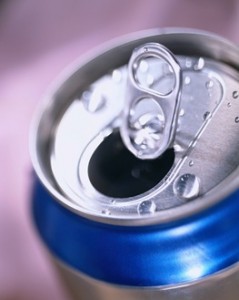 Several sources have reported that diet soda is as bad for your teeth as crack cocaine and meth. While diet soda is certainly not good for your teeth, one of the women that is most mentioned in the news about the adverse effects of diet soda on your teeth did not practice regular dental hygiene. This was almost certainly a factor in the bad condition of her teeth. According to Dr. Mohamed Bassiouny, a professor of restorative dentistry at the Temple University School of Dentistry in Philadelphia, methamphetamine, crack cocaine and soda-sweetened or not-are all highly acidic and can cause similar dental problems. The woman who Bassiouny cited in his study was in her 30′s. She consumed a fairly large amount of diet soda, 2 liters of diet soda daily for three to five years. This was one of the factors, along with her not practicing proper dental hygiene, that led to Bassiouny’s findings. According to US News and World Report, the woman experienced tooth rot and decay that was very similar to that suffered by a 29-year-old methamphetamine addict or a 51-year-old habitual crack cocaine user. Bassiouny mentions in his study that two drug abusers who came to him for dental issues needed all of their teeth extracted. They used methamphetamine and crack, which are known to cause damage to the mouths of users. These illegal drugs reduce the amount of saliva in the mouth, providing a lesser ability for the acids to wash away. They also expose teeth to damaging acid, and cause systemic health problems that affect dental hygiene. The condition that results is commonly known as “meth mouth,” which previous studies have linked with rampant decay. – The Guardian Express
Several sources have reported that diet soda is as bad for your teeth as crack cocaine and meth. While diet soda is certainly not good for your teeth, one of the women that is most mentioned in the news about the adverse effects of diet soda on your teeth did not practice regular dental hygiene. This was almost certainly a factor in the bad condition of her teeth. According to Dr. Mohamed Bassiouny, a professor of restorative dentistry at the Temple University School of Dentistry in Philadelphia, methamphetamine, crack cocaine and soda-sweetened or not-are all highly acidic and can cause similar dental problems. The woman who Bassiouny cited in his study was in her 30′s. She consumed a fairly large amount of diet soda, 2 liters of diet soda daily for three to five years. This was one of the factors, along with her not practicing proper dental hygiene, that led to Bassiouny’s findings. According to US News and World Report, the woman experienced tooth rot and decay that was very similar to that suffered by a 29-year-old methamphetamine addict or a 51-year-old habitual crack cocaine user. Bassiouny mentions in his study that two drug abusers who came to him for dental issues needed all of their teeth extracted. They used methamphetamine and crack, which are known to cause damage to the mouths of users. These illegal drugs reduce the amount of saliva in the mouth, providing a lesser ability for the acids to wash away. They also expose teeth to damaging acid, and cause systemic health problems that affect dental hygiene. The condition that results is commonly known as “meth mouth,” which previous studies have linked with rampant decay. – The Guardian Express
Another Benefit of the Mediterranean Diet: It Keeps You Smart
By Irene Zutell, May 21, 2013
Want to ward off dementia? Eat like a Spaniard or a Greek or an Italian
 Sticking to a Mediterranean diet—a diet rich in whole grains, nuts, fruits and vegetables, legumes, fish and even some red wine—is not just good for your heart, but it may keep you smarter, according to a new study published in the Journal of Neurology, Neurosurgery and Psychiatry. Researchers in Spain followed more than 1,000 people aged 55 to 80 for six and a half years. Participants were considered high risk for cardiovascular disease and were divided into three groups. Two groups was put on a Mediterranean diet and a control group received advice to follow a low-fat diet typically recommended to prevent heart attacks and strokes. After an average of 6.5 years, participants were tested for signs of cognitive decline using a range of mental tests. The people who were on a Mediterranean diet performed better on cognitive tests than did the control group. – Family Goes Strong
Sticking to a Mediterranean diet—a diet rich in whole grains, nuts, fruits and vegetables, legumes, fish and even some red wine—is not just good for your heart, but it may keep you smarter, according to a new study published in the Journal of Neurology, Neurosurgery and Psychiatry. Researchers in Spain followed more than 1,000 people aged 55 to 80 for six and a half years. Participants were considered high risk for cardiovascular disease and were divided into three groups. Two groups was put on a Mediterranean diet and a control group received advice to follow a low-fat diet typically recommended to prevent heart attacks and strokes. After an average of 6.5 years, participants were tested for signs of cognitive decline using a range of mental tests. The people who were on a Mediterranean diet performed better on cognitive tests than did the control group. – Family Goes Strong
Pick Your Poison: Overweight or High Cholesterol
By Brian Orelli, May 18, 2013
 Overweight and have high cholesterol? You may have to pick one to work on at a time, according to data from the lab of John Thyfault, an associate professor of nutrition and exercise physiology at University of Missouri. Statins work really well at lowering bad LDL cholesterol, but they can cause muscle ache in some patients. Thyfault and colleagues decided to see if cholesterol-lowering drugs would affect benefits from exercise in obese and overweight patients. The study, published in the Journal of the American College of Cardiology, used Merck‘s (NYSE: MRK ) Zocor, but it seems safe to assume that other statins — Pfizer‘s (NYSE: PFE ) Lipitor and AstraZeneca‘s (NYSE: AZN ) Crestor — would give similar results given that statins work in the same way. Taking Zocor didn’t affect adherence to the exercise program — both the group taking Zocor and those prescribed exercise alone went to 95% of exercise sessions over 12 weeks — but there were dramatic effects on the outcomes of the exercise. Cardiovascular fitness, defined by the amount of oxygen consumed normalized to body weight, increased by 10% in patients prescribed exercise alone, but only by 1.5% in those who also took a statin. The researchers also found that a marker for activity of mitochondria, which turn oxygen and sugar into energy, decreased by 4.5% in the patients who took Zocor, but increased, as it should, by 13% in the group that wasn’t given the drug. The increased fitness translated into weight loss. Over the 12 weeks, the exercise-only group lost 1.7% of their body weight on average, but the weight of the group that took Zocor increased slightly. – The Motley Fool
Overweight and have high cholesterol? You may have to pick one to work on at a time, according to data from the lab of John Thyfault, an associate professor of nutrition and exercise physiology at University of Missouri. Statins work really well at lowering bad LDL cholesterol, but they can cause muscle ache in some patients. Thyfault and colleagues decided to see if cholesterol-lowering drugs would affect benefits from exercise in obese and overweight patients. The study, published in the Journal of the American College of Cardiology, used Merck‘s (NYSE: MRK ) Zocor, but it seems safe to assume that other statins — Pfizer‘s (NYSE: PFE ) Lipitor and AstraZeneca‘s (NYSE: AZN ) Crestor — would give similar results given that statins work in the same way. Taking Zocor didn’t affect adherence to the exercise program — both the group taking Zocor and those prescribed exercise alone went to 95% of exercise sessions over 12 weeks — but there were dramatic effects on the outcomes of the exercise. Cardiovascular fitness, defined by the amount of oxygen consumed normalized to body weight, increased by 10% in patients prescribed exercise alone, but only by 1.5% in those who also took a statin. The researchers also found that a marker for activity of mitochondria, which turn oxygen and sugar into energy, decreased by 4.5% in the patients who took Zocor, but increased, as it should, by 13% in the group that wasn’t given the drug. The increased fitness translated into weight loss. Over the 12 weeks, the exercise-only group lost 1.7% of their body weight on average, but the weight of the group that took Zocor increased slightly. – The Motley Fool
Fitness at 50 Linked to Less Cancer Risk
By Michael Smith, May 15, 2013
 For middle-age men, good physical fitness reduces the risk of lung and colorectal cancer, a researcher said. And if men who are fit in their 50s do develop those cancers, as well as prostate cancer, the risk of dying appears to be lower, according to Susan Lakoski, MD, of the University of Vermont in Burlington, and colleagues. Fitter men also had — as might be expected — a lower risk of dying from cardiovascular causes, Lakoski told reporters in a telephone press briefing in advance of the 2013 meeting in Chicago of the American Society of Clinical Oncology. But the effects of fitness on cancer risk and mortality are new and have important clinical implications, Lakoski told MedPage Today during an interview earlier. When primary care doctors think about preventing cancer and cardiovascular disease, she said, “they need to think about fitness … because we know it is prognostic of major outcomes.” Lakoski said doctors have to go beyond writing a prescription for exercise to think about actually measuring fitness. “Physical activity and fitness are very different,” she said in the media conference. – MedPage Today
For middle-age men, good physical fitness reduces the risk of lung and colorectal cancer, a researcher said. And if men who are fit in their 50s do develop those cancers, as well as prostate cancer, the risk of dying appears to be lower, according to Susan Lakoski, MD, of the University of Vermont in Burlington, and colleagues. Fitter men also had — as might be expected — a lower risk of dying from cardiovascular causes, Lakoski told reporters in a telephone press briefing in advance of the 2013 meeting in Chicago of the American Society of Clinical Oncology. But the effects of fitness on cancer risk and mortality are new and have important clinical implications, Lakoski told MedPage Today during an interview earlier. When primary care doctors think about preventing cancer and cardiovascular disease, she said, “they need to think about fitness … because we know it is prognostic of major outcomes.” Lakoski said doctors have to go beyond writing a prescription for exercise to think about actually measuring fitness. “Physical activity and fitness are very different,” she said in the media conference. – MedPage Today
Juice Frauds: What’s Really in Your Juice
By The Daily Meal, May 13, 2013
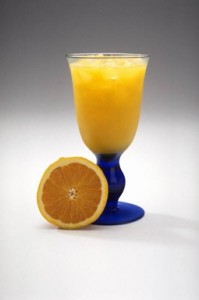 There’s nothing quite like a glass of juice first thing in the morning to kick-start your day. And with so many delicious flavor combinations these days – both to make and to buy – there’s no shortage of delicious juices to enjoy. But unless you have lots of time to spare, tons money to spend on costly juicers, and the means to buy lots of fruits and veggies, you may not always find the time to fresh-squeeze your juice every time you want it… As with any drink or food you might buy, it never hurts to take a close look at the ingredient label before buying. But what should you look for? There are some key words that can tip you off that your juice might not be as great as you think. There are even drawbacks to the supposedly 100 percent fruit juice label; for one, that 100 percent fruit juice can pack a whole lot more sugar and calories in one serving that the fruit its supposedly made from… The term “100 percent fruit juice” sounds innocent and wholesome, right? Sure – but you have to know what you’re looking for. The good news is that 100 percent fruit juice is made purely from the juices of real fruits. And that means you’re getting all the antioxidants and vitamins from fruit in one powerful punch… You might think that your fruity combination juice is a mix of all your favorite juices – but you’re more likely to find apple and grape juices in there. Apple and grape juices are seen as the “fillers” of most juices, because they’re cheap to make. So that blueberry-pomegranate juice may contain 100 percent fruit juice of blueberries and pomegranates, but may also have apple and grape juice in it.- Yahoo! Shine
There’s nothing quite like a glass of juice first thing in the morning to kick-start your day. And with so many delicious flavor combinations these days – both to make and to buy – there’s no shortage of delicious juices to enjoy. But unless you have lots of time to spare, tons money to spend on costly juicers, and the means to buy lots of fruits and veggies, you may not always find the time to fresh-squeeze your juice every time you want it… As with any drink or food you might buy, it never hurts to take a close look at the ingredient label before buying. But what should you look for? There are some key words that can tip you off that your juice might not be as great as you think. There are even drawbacks to the supposedly 100 percent fruit juice label; for one, that 100 percent fruit juice can pack a whole lot more sugar and calories in one serving that the fruit its supposedly made from… The term “100 percent fruit juice” sounds innocent and wholesome, right? Sure – but you have to know what you’re looking for. The good news is that 100 percent fruit juice is made purely from the juices of real fruits. And that means you’re getting all the antioxidants and vitamins from fruit in one powerful punch… You might think that your fruity combination juice is a mix of all your favorite juices – but you’re more likely to find apple and grape juices in there. Apple and grape juices are seen as the “fillers” of most juices, because they’re cheap to make. So that blueberry-pomegranate juice may contain 100 percent fruit juice of blueberries and pomegranates, but may also have apple and grape juice in it.- Yahoo! Shine
FDA studies caffeine’s effects on children, teens
By Wes Venteicher, May 4, 2013
The agency opens the inquiry as the stimulant is being added to waffles, jelly beans, gum and other nontraditional sources.
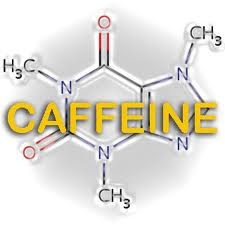 The presence of caffeine in gum, jelly beans, waffles and other foods has prompted the Food and Drug Administration to investigate the stimulant’s potential effects on children and adolescents. The FDA’s announcement comes a few weeks after gum maker Wrigley introduced its Alert Energy Caffeine Gum. Each piece of the gum contains about as much caffeine as a half-cup of coffee, according to a consumer update that the FDA posted on its website Friday. The update provided more information on an investigation the FDA announced earlier this week. “The gum is just one more unfortunate example of the trend to add caffeine to food,” Michael R. Taylor, the FDA’s deputy commissioner for foods and veterinary medicine, said on the site. Other caffeine-containing foods include waffles and maple syrup from Wired Waffles and Jelly Belly’s Extreme Sport Beans and Morning Spark Oatmeal from Energy Fiend. Taylor said the FDA also was concerned about the marketing of highly caffeinated energy drinks to young people. The agency does not have any rules for caffeine in food, but regulates alcoholic beverages that contain caffeine. The only time the agency explicitly approved caffeine in a product was for colas in the 1950s. – Los Angeles Times
The presence of caffeine in gum, jelly beans, waffles and other foods has prompted the Food and Drug Administration to investigate the stimulant’s potential effects on children and adolescents. The FDA’s announcement comes a few weeks after gum maker Wrigley introduced its Alert Energy Caffeine Gum. Each piece of the gum contains about as much caffeine as a half-cup of coffee, according to a consumer update that the FDA posted on its website Friday. The update provided more information on an investigation the FDA announced earlier this week. “The gum is just one more unfortunate example of the trend to add caffeine to food,” Michael R. Taylor, the FDA’s deputy commissioner for foods and veterinary medicine, said on the site. Other caffeine-containing foods include waffles and maple syrup from Wired Waffles and Jelly Belly’s Extreme Sport Beans and Morning Spark Oatmeal from Energy Fiend. Taylor said the FDA also was concerned about the marketing of highly caffeinated energy drinks to young people. The agency does not have any rules for caffeine in food, but regulates alcoholic beverages that contain caffeine. The only time the agency explicitly approved caffeine in a product was for colas in the 1950s. – Los Angeles Times
Light Exercise Still Cuts Kidney Stone Risk
By Charles Bankhead, May 05, 2013
 Women who exercised even minimally had a significantly lower risk of kidney stones, according to an analysis of a large cohort study. Overall, physically active women had about a 30% lower risk of kidney stones compared with women who reported no exercise. The risk reduction ranged as high as 80% in one analysis, reported Mathew Sorensen, MD, of the University of Washington in Seattle, and colleagues at the American Urological Association (AUA) meeting. The benefit for stone disease kicked in with only modest physical activity of just about any intensity, he added. “The intensity of exercises does not matter,” Sorensen said during an AUA press briefing. “There was no difference between women who performed primarily mild, moderate, or strenuous activity. The protective effect of increased activity was similar for all exercisers.” Almost 10% of the adult population in the U.S. will develop a kidney stone at some point. Kidney stone incidence has increased 70% over the past 15 years, and women have accounted for much of the increase, he explained, adding that the increase has been attributed to the rising prevalence of weight gain, obesity, and metabolic syndrome. – MedPage Today
Women who exercised even minimally had a significantly lower risk of kidney stones, according to an analysis of a large cohort study. Overall, physically active women had about a 30% lower risk of kidney stones compared with women who reported no exercise. The risk reduction ranged as high as 80% in one analysis, reported Mathew Sorensen, MD, of the University of Washington in Seattle, and colleagues at the American Urological Association (AUA) meeting. The benefit for stone disease kicked in with only modest physical activity of just about any intensity, he added. “The intensity of exercises does not matter,” Sorensen said during an AUA press briefing. “There was no difference between women who performed primarily mild, moderate, or strenuous activity. The protective effect of increased activity was similar for all exercisers.” Almost 10% of the adult population in the U.S. will develop a kidney stone at some point. Kidney stone incidence has increased 70% over the past 15 years, and women have accounted for much of the increase, he explained, adding that the increase has been attributed to the rising prevalence of weight gain, obesity, and metabolic syndrome. – MedPage Today
Bee-harming pesticides banned in Europe
By Damian Carrington, 29 April 2013
EU member states vote ushers in continent-wide suspension of neonicotinoid pesticides
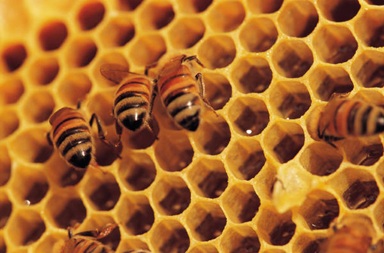 Europe will enforce the world’s first continent-wide ban on widely used insecticides alleged to cause serious harm to bees, after a European commission vote on Monday. The suspension is a landmark victory for millions of environmental campaigners, backed by the European Food Safety Authority (EFSA), concerned about a dramatic decline in the bee population. The vote also represents a serious setback for the chemical producers who make billions each year from the products and also UK ministers, who voted against the ban. Both had argued the ban would harm food production.Although the vote by the 27 EU member states on whether to suspend the insect nerve agents was supported by 15 nations, but did not reach the required majority under voting rules. The hung vote hands the final decision to the European commission, which will implement the ban. Tonio Borg, health and consumer commissioner, said: “Our proposal is based on a number of risks to bee health identified by the EFSA, [so] the European commission will go ahead with its plan in coming weeks.” Friends of the Earth‘s head of campaigns, Andrew Pendleton, said: “This decision is a significant victory for common sense and our beleaguered bee populations. Restricting the use of these pesticides could be an historic milestone on the road to recovery for these crucial pollinators.” – The Guardian
Europe will enforce the world’s first continent-wide ban on widely used insecticides alleged to cause serious harm to bees, after a European commission vote on Monday. The suspension is a landmark victory for millions of environmental campaigners, backed by the European Food Safety Authority (EFSA), concerned about a dramatic decline in the bee population. The vote also represents a serious setback for the chemical producers who make billions each year from the products and also UK ministers, who voted against the ban. Both had argued the ban would harm food production.Although the vote by the 27 EU member states on whether to suspend the insect nerve agents was supported by 15 nations, but did not reach the required majority under voting rules. The hung vote hands the final decision to the European commission, which will implement the ban. Tonio Borg, health and consumer commissioner, said: “Our proposal is based on a number of risks to bee health identified by the EFSA, [so] the European commission will go ahead with its plan in coming weeks.” Friends of the Earth‘s head of campaigns, Andrew Pendleton, said: “This decision is a significant victory for common sense and our beleaguered bee populations. Restricting the use of these pesticides could be an historic milestone on the road to recovery for these crucial pollinators.” – The Guardian
Study: Food, skin allergies increasing in children
Food and skin allergies increase in children, survey shows, but health officials not sure why
By Mike Stobbe, AP Medical Writer, May 2, 2013
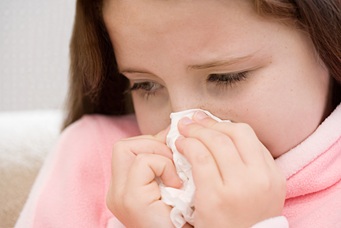 Parents are reporting more skin and food allergies in their children, a big government survey found. Experts aren’t sure what’s behind the increase. Could it be that children are growing up in households so clean that it leaves them more sensitive to things that can trigger allergies? Or are mom and dad paying closer attention to rashes and reactions, and more likely to call it an allergy? “We don’t really have the answer,” said Dr. Lara Akinbami of the Centers for Disease Control and Prevention, the senior author of the new report released Thursday. The CDC survey suggests that about 1 in 20 U.S. children have food allergies. That’s a 50 percent increase from the late 1990s. For eczema and other skin allergies, it’s 1 in 8 children, an increase of 69 percent. It found no increase, however, in hay fever or other respiratory allergies. Already familiar with the trend in food allergies are school nurses, who have grown busier with allergy-related duties, like banishing peanuts at school parties or stocking emergency allergy medicine. – Yahoo! News
Parents are reporting more skin and food allergies in their children, a big government survey found. Experts aren’t sure what’s behind the increase. Could it be that children are growing up in households so clean that it leaves them more sensitive to things that can trigger allergies? Or are mom and dad paying closer attention to rashes and reactions, and more likely to call it an allergy? “We don’t really have the answer,” said Dr. Lara Akinbami of the Centers for Disease Control and Prevention, the senior author of the new report released Thursday. The CDC survey suggests that about 1 in 20 U.S. children have food allergies. That’s a 50 percent increase from the late 1990s. For eczema and other skin allergies, it’s 1 in 8 children, an increase of 69 percent. It found no increase, however, in hay fever or other respiratory allergies. Already familiar with the trend in food allergies are school nurses, who have grown busier with allergy-related duties, like banishing peanuts at school parties or stocking emergency allergy medicine. – Yahoo! News
GMO Labeling Bill Introduced in Congress
April 30, 2013
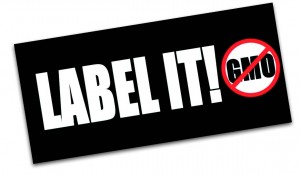 …Both Boxer and DeFazio have previously sponsored GMO labeling bills, but this is the first labeling bill that has both bicameral and bipartisan support (though the latter is decidedly modest: only one cosponsor in each chamber is a Republican, and both are from Alaska). The new labeling requirement does not apply to food used in restaurants, or in hospitals or other medical environments. Nor does it apply to food produced using a GE vaccine or a “processing aid” such as yeast. Food manufacturers are protected so long as they have a statement from the grower that the food contains no GMOs. The bill also protects producers whose food was unintentionally contaminated by GMOs, so long as the contamination did not occur as a result of negligence. Enforcement would be left up to the FDA rather than through civil action.
…Both Boxer and DeFazio have previously sponsored GMO labeling bills, but this is the first labeling bill that has both bicameral and bipartisan support (though the latter is decidedly modest: only one cosponsor in each chamber is a Republican, and both are from Alaska). The new labeling requirement does not apply to food used in restaurants, or in hospitals or other medical environments. Nor does it apply to food produced using a GE vaccine or a “processing aid” such as yeast. Food manufacturers are protected so long as they have a statement from the grower that the food contains no GMOs. The bill also protects producers whose food was unintentionally contaminated by GMOs, so long as the contamination did not occur as a result of negligence. Enforcement would be left up to the FDA rather than through civil action.
…These various GMO labeling initiatives are especially important in light of a recent report that links glyphosate—the pesticide Roundup, for which the genetically engineered Roundup Ready crops were created so that more and more of the pesticide could be used without damaging the plant—to a wide range of health problems and diseases, including Parkinson’s, infertility, and various cancers. There’s a family of fifty different enzymes collectively known as Cytochrome P450, which are the detoxification heavy hitters in the human body. According to the report, glyphosate destroys the CYP450 detoxification pathways. Not only is the expanded use of Roundup increasing our exposure to this toxic herbicide; it’s also reducing the body’s ability to detoxify many xenobiotics. It’s a potentially very dangerous double whammy. When the CYP450 pathways are destroyed, it results in altered gut bacteria and ultimately all the western-related, chronic diseases such as diabetes. If the plants were not genetically altered to withstand such high concentrations of the pesticide, we wouldn’t be exposed to such toxic and health-destroying levels. – Alliance For Natural Health
80 Million Americans Can’t Afford to Go to the Doctor
By Tami Luhby, 4/26/2013
 A growing number of Americans are skipping needed medical care because they can’t afford it. Some 80 million people, around 43% of America’s working-age adults, didn’t go to the doctor or access other medical services last year because of the cost, according to the Commonwealth Fund’s Biennial Health Insurance Survey, released Friday. That’s up from 75 million people two years ago and 63 million in 2003. Not surprisingly, those who were uninsured or had inadequate health insurance were most likely to have trouble affording care. But 28% of working-age adults with good insurance also had to forgo treatment because of the price. Nearly three in 10 adults said they did not visit a doctor or clinic when they had a medical problem, while more than a quarter did not fill a prescription or skipped recommended tests, treatment or follow-up visits. One in five said they did not get needed specialist care. And 28% of those with a chronic condition like hypertension, diabetes, heart disease and asthma who needed medication for it reported they did not fill prescriptions or skipped doses because they couldn’t afford to pay for the drugs. – Yahoo! Finance
A growing number of Americans are skipping needed medical care because they can’t afford it. Some 80 million people, around 43% of America’s working-age adults, didn’t go to the doctor or access other medical services last year because of the cost, according to the Commonwealth Fund’s Biennial Health Insurance Survey, released Friday. That’s up from 75 million people two years ago and 63 million in 2003. Not surprisingly, those who were uninsured or had inadequate health insurance were most likely to have trouble affording care. But 28% of working-age adults with good insurance also had to forgo treatment because of the price. Nearly three in 10 adults said they did not visit a doctor or clinic when they had a medical problem, while more than a quarter did not fill a prescription or skipped recommended tests, treatment or follow-up visits. One in five said they did not get needed specialist care. And 28% of those with a chronic condition like hypertension, diabetes, heart disease and asthma who needed medication for it reported they did not fill prescriptions or skipped doses because they couldn’t afford to pay for the drugs. – Yahoo! Finance
Genetically Engineered Food Right-to-Know Act Introduced by Boxer/DeFazio
By Anne Sewell, Apr 25, 2013
Washington – On April 24, the Genetically Engineered Right-to-Know Act was introduced by Senator Barbara Boxer (D-CA) and Congressman Peter DeFazio (D-OR), to require food manufacturers to inform consumers of genetically engineered ingredients in their products. Katey Parker of “Just Label It“, which has more than 650 partner organizations, hailed this introduction:
“Americans want to know more, not less, about their food.”
“More than 90 percent of Americans want the same rights as consumers in 64 countries around the world. It’s time to trust American consumers with information about genetically engineered ingredients so they can make the best choices for themselves and their families.” At present, the FDA requires labeling of over 3,000 ingredients, additives and processes. However, the agency still resists labels for genetically modified foods. In 1992, the FDA released a policy statement that allows GE foods to be sold without labeling, claiming that these foods are not “materially” different from other foods. They state that they are not different, because the genetic differences could not be recognized by taste, smell or other senses. – Digital Journal
97% of Kids’ Meals Flunk Nutrition
March 28, 2013
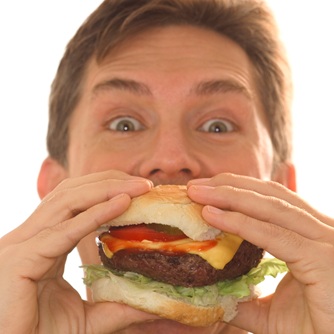 Nearly all of the meal possibilities offered to kids at America’s top chain restaurants are of poor nutritional quality, according to the nonprofit Center for Science in the Public Interest. In a report released today, the group found that fried chicken fingers, burgers, French fries, and sugar drinks continue to dominate the kids’ meal landscape, with 97 percent of the nearly 3,500 meal possibilities not meeting CSPI’s nutrition criteria for four- to eight-year-olds. And if you don’t believe CSPI, ask the National Restaurant Association: 91 percent of kids’ meals at America’s major chains do not even meet the nutritional standards of the industry lobbying group’s Kids LiveWell program. “One out of every three American children is overweight or obese, but it’s as if the chain restaurant industry didn’t get the memo,” said CSPI nutrition policy director Margo G. Wootan. “Most chains seem stuck in a time warp, serving up the same old meals based on burgers, macaroni and cheese, fries, and soda.” – Center for Science in the Public Interest
Nearly all of the meal possibilities offered to kids at America’s top chain restaurants are of poor nutritional quality, according to the nonprofit Center for Science in the Public Interest. In a report released today, the group found that fried chicken fingers, burgers, French fries, and sugar drinks continue to dominate the kids’ meal landscape, with 97 percent of the nearly 3,500 meal possibilities not meeting CSPI’s nutrition criteria for four- to eight-year-olds. And if you don’t believe CSPI, ask the National Restaurant Association: 91 percent of kids’ meals at America’s major chains do not even meet the nutritional standards of the industry lobbying group’s Kids LiveWell program. “One out of every three American children is overweight or obese, but it’s as if the chain restaurant industry didn’t get the memo,” said CSPI nutrition policy director Margo G. Wootan. “Most chains seem stuck in a time warp, serving up the same old meals based on burgers, macaroni and cheese, fries, and soda.” – Center for Science in the Public Interest
Learn About Wild Edible and Medicinal Plants
By Creek Stewart, April 23, 2013
 If given the choice of eating naturally grown veggies or those that have been unnaturally genetically modified to withstand massive doses of pesticides, I think any rationally minded human would go the natural route. The proponents of GMO foods are fighting against GMO labels on food products for that very reason – they know people don’t want to put that crap in their body. I wonder what new disease, condition or allergy will surface this week? As the human body adapts to ingesting and absorbing more chemical products and GMO foods than ever before, cancer continues to skyrocket and new wacky conditions rear their ugly face in the children of a chemical- and GMO-induced generation.
If given the choice of eating naturally grown veggies or those that have been unnaturally genetically modified to withstand massive doses of pesticides, I think any rationally minded human would go the natural route. The proponents of GMO foods are fighting against GMO labels on food products for that very reason – they know people don’t want to put that crap in their body. I wonder what new disease, condition or allergy will surface this week? As the human body adapts to ingesting and absorbing more chemical products and GMO foods than ever before, cancer continues to skyrocket and new wacky conditions rear their ugly face in the children of a chemical- and GMO-induced generation.
So where is a good place to look for chemical-free and GMO-free fresh veggies this time of year? Your back yard! …Below are five very common wild edible plants that are easy to identify and easy to gather. And, they won’t wage war against your body. – WND
Weight-Loss Advice so Good People Pay Millions for It
By Betsy Stephens, REDBOOK, April 22, 2013
Big-budget movie studios have celebrity trainer Ramona Braganza on speed dial. Why? Because she’s the pro at getting A-listers in amazing shape for filming. But right now, she’s focused on you. Here are her best celebrity weight loss tips.
 Tell people you’re trying to lose weight. “Many people think that trying to slim down is something they should keep private, so they rely on their willpower alone to stick to a program-and willpower only gets them so far! Jessica Alba, a client of mine who has taken on several roles that required her to be in skimpy clothing, sticks to a daily training schedule with the help of family members and friends, often including them in her workouts or healthy eating plan. But you don’t need to get cast in a movie: Declare your goal by posting in an online community, where you can connect with other women who are dealing with the same temptations-like couch time or cake-and staying on track.” Give yourself weeks, not days, to see results. “Fact: It’s always better to train moderately than try to do it all in a hurry, which is a recipe for burning out and giving up… –Yahoo! Shine
Tell people you’re trying to lose weight. “Many people think that trying to slim down is something they should keep private, so they rely on their willpower alone to stick to a program-and willpower only gets them so far! Jessica Alba, a client of mine who has taken on several roles that required her to be in skimpy clothing, sticks to a daily training schedule with the help of family members and friends, often including them in her workouts or healthy eating plan. But you don’t need to get cast in a movie: Declare your goal by posting in an online community, where you can connect with other women who are dealing with the same temptations-like couch time or cake-and staying on track.” Give yourself weeks, not days, to see results. “Fact: It’s always better to train moderately than try to do it all in a hurry, which is a recipe for burning out and giving up… –Yahoo! Shine
Shocking rates of antibiotic-resistant bacteria in supermarket meats
By Laura Sesana, April 18, 2013
 A recent study by the National Antimicrobial Resistance Monitoring System (NARMS) reveals shocking rates of antibiotic-resistant bacteria in U.S. supermarket meats: an alarming 81% of ground turkey and well over half of ground beef and pork chops tested contained some form of these “superbugs.” Established in 1996 to track antibiotic resistance in foodborne bacteria, NARMS is a joint public health surveillance project of the Food and Drug Administration (FDA), the Centers for Disease Control and Prevention (CDC), and the U.S. Department of Agriculture (USDA). …The study found antibiotic-resistant bacteria in 55% of ground beef, 81% of ground turkey, 69% of pork chops, and 39% of chicken breast, wings or thighs. Perhaps just as disturbing, the study also found that 87% of all the meat collected by federal scientists was contaminated with both normal and antibiotic-resistant Enterococcus bacteria, “evidence that most of this meat likely came in contact with fecal matter at some point.” – The Washington Times
A recent study by the National Antimicrobial Resistance Monitoring System (NARMS) reveals shocking rates of antibiotic-resistant bacteria in U.S. supermarket meats: an alarming 81% of ground turkey and well over half of ground beef and pork chops tested contained some form of these “superbugs.” Established in 1996 to track antibiotic resistance in foodborne bacteria, NARMS is a joint public health surveillance project of the Food and Drug Administration (FDA), the Centers for Disease Control and Prevention (CDC), and the U.S. Department of Agriculture (USDA). …The study found antibiotic-resistant bacteria in 55% of ground beef, 81% of ground turkey, 69% of pork chops, and 39% of chicken breast, wings or thighs. Perhaps just as disturbing, the study also found that 87% of all the meat collected by federal scientists was contaminated with both normal and antibiotic-resistant Enterococcus bacteria, “evidence that most of this meat likely came in contact with fecal matter at some point.” – The Washington Times
Is Carrageenan Okay to Eat?
While this ingredient is found in healthy foods, some experts say it’s not healthy
Q: My friend told me to stop eating my favorite yogurt because it has carrageenan in it. Is she right?
A: Carrageenan is a compound extracted from red seaweed that is added to improve the texture and mouth feel of foods. Its widespread use as an additive in foods began in the 1930s, initially in chocolate milk, and now it is found in yogurt, ice cream, soy milk, almond milk, deli meats, and meal replacement shakes. For decades different groups and scientists have been trying to get the FDA to ban carrageenan as a food additive due to potential damage that it can cause to the digestive tract. More recently, this argument has been reignited with a consumer report and petition by the advocacy and food policy research group Cornucopia entitled, “How a Natural Food Additive Is Making Us Sick.” – Shape
What is ‘Clean Eating’? And Should You Try It?
By Katie Golde, Apr 16, 2013
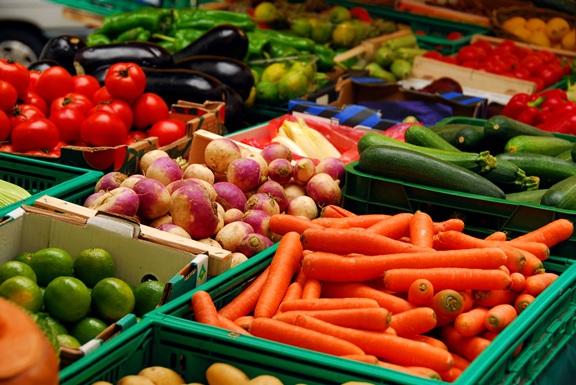 …While there’s no hard and fast definition, clean eating is all about consuming only whole foods (think: fruits, vegetables, and whole grains), while avoiding processed and fast foods at all costs. The idea is to promote health and encourage individuals to become aware of what they are eating (not to mention the benefits of lowering sugar, sodium, and artificial ingredient intake). So what’s the fuss all about, and should you try it, too? Due to the lack of super-strict rules attached to this lifestyle, its popularity may lie in its ability to encourage healthier eating by allowing people to pick the foods they like and reap healthy rewards. While the term “clean eating” is relatively new, the concept originates from the 1960s and its (hippy-dippy) health-focused condemnation of diets containing high amounts of processed foods. (Keep in mind not all processed foods are equal: They span a spectrum ranging from minimally processed items like the bag of spinach you get at the grocery, to heavily processed foods like the frozen fish/chicken nuggets in the back of the freezer.) The closer your foods are to the minimally-processed side, the closer you are to eating clean. – Yahoo Health
…While there’s no hard and fast definition, clean eating is all about consuming only whole foods (think: fruits, vegetables, and whole grains), while avoiding processed and fast foods at all costs. The idea is to promote health and encourage individuals to become aware of what they are eating (not to mention the benefits of lowering sugar, sodium, and artificial ingredient intake). So what’s the fuss all about, and should you try it, too? Due to the lack of super-strict rules attached to this lifestyle, its popularity may lie in its ability to encourage healthier eating by allowing people to pick the foods they like and reap healthy rewards. While the term “clean eating” is relatively new, the concept originates from the 1960s and its (hippy-dippy) health-focused condemnation of diets containing high amounts of processed foods. (Keep in mind not all processed foods are equal: They span a spectrum ranging from minimally processed items like the bag of spinach you get at the grocery, to heavily processed foods like the frozen fish/chicken nuggets in the back of the freezer.) The closer your foods are to the minimally-processed side, the closer you are to eating clean. – Yahoo Health
The Western diet really IS a killer: People who eat white bread, butter and red meat are most likely to die young
By Anna Hodgekiss, 16 April 2013
Those who ate fried and unhealthy food had doubled risk of early death
Key culprits include red meat, white bread, butter, cream and sweet foods
Findings ‘help explain’ why heart disease is still the UK’s biggest killer
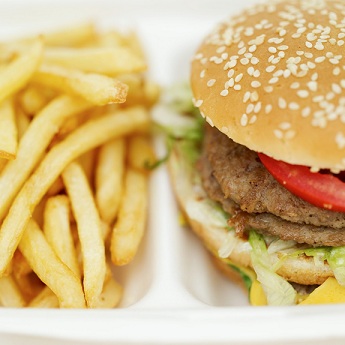 The typical Western diet, high in fat and sugar, really does lead to an early grave, new research suggests. A study of more than 5,000 civil servants found those who ate the most fried and sweet food, processed and red meat, white bread and butter and cream doubled their risk of premature death or ill health in old age. It adds to evidence that ‘Western style food’ is the reason why heart disease claims about 94,000 lives a year in the UK – more than any other illness. The findings published in The American Journal of Medicine are based on a survey of British adults and suggest adherence to the diet increases the risk of premature death and disability later in life. – Mail One Health
The typical Western diet, high in fat and sugar, really does lead to an early grave, new research suggests. A study of more than 5,000 civil servants found those who ate the most fried and sweet food, processed and red meat, white bread and butter and cream doubled their risk of premature death or ill health in old age. It adds to evidence that ‘Western style food’ is the reason why heart disease claims about 94,000 lives a year in the UK – more than any other illness. The findings published in The American Journal of Medicine are based on a survey of British adults and suggest adherence to the diet increases the risk of premature death and disability later in life. – Mail One Health
Will Monsanto Ties Influence Nutritionists’ Stance on GMOs?
By Tom Philpott, Apr. 13, 2013
 The GMO seed giant Monsanto recently flexed its muscles in Congress, working with a senator to sneak a friendly rider into an unrelated funding bill. Now it appears to be having its way with the Academy of Nutrition and Dietetics. As the New York Times reports, a dietician who’d been working on crafting the group’s GMO policy claims she was pushed aside for pointing out her colleagues’ links to Monsanto… As part of the process of generating a position paper, the group appointed seven members to what it called the Advanced Technologies in Food Production working group. That’s when things got hairy. Two of the members, it turned out, had ties to Monsanto. One was a “dietitian who operates a farm in Maryland, [who] won a $5,000 prize from Monsanto and is a test farmer for the company,” the Times reports. The other serves as senior vice president of the International Food Information Council, a group whose funders read like a roster of Big Ag and junk-food corporations, ranging from Monsanto, Bayer Cropscience, and Cargill to Coca Cola, Red Bull, Pepsi, and Dr. Pepper Snapple Group. Several of the International Food Information Council’s donor companies also contributed heavily to the $45.6 million effort to defeat California’s GMO ballot initiative. – Mother Jones
The GMO seed giant Monsanto recently flexed its muscles in Congress, working with a senator to sneak a friendly rider into an unrelated funding bill. Now it appears to be having its way with the Academy of Nutrition and Dietetics. As the New York Times reports, a dietician who’d been working on crafting the group’s GMO policy claims she was pushed aside for pointing out her colleagues’ links to Monsanto… As part of the process of generating a position paper, the group appointed seven members to what it called the Advanced Technologies in Food Production working group. That’s when things got hairy. Two of the members, it turned out, had ties to Monsanto. One was a “dietitian who operates a farm in Maryland, [who] won a $5,000 prize from Monsanto and is a test farmer for the company,” the Times reports. The other serves as senior vice president of the International Food Information Council, a group whose funders read like a roster of Big Ag and junk-food corporations, ranging from Monsanto, Bayer Cropscience, and Cargill to Coca Cola, Red Bull, Pepsi, and Dr. Pepper Snapple Group. Several of the International Food Information Council’s donor companies also contributed heavily to the $45.6 million effort to defeat California’s GMO ballot initiative. – Mother Jones
Autism: What we know right now
By Kelley King Heyworth, April 16, 2013
The “A” word is enough to rattle any parent: Nearly two-thirds of young moms and dads are concerned their child will be diagnosed with ASD, according to a recent survey by the Florida Institute of Technology. It’s no wonder, given the runaway rates. Whereas 1 in 150 kids was diagnosed with some form of autism five years ago, 1 in 50 kids is on the spectrum today. These rising rates inspired Bob Wright, co-founder of Autism Speaks, to say, “We have an epidemic on our hands…. It is imperative that the U.S. government steps up its commitment to helping people living with autism today.” Last November, the first congressional hearing on autism in 10 years was held to determine what the federal response should be. (It didn’t exactly make front-page news: It aired on CSPAN-3.) – CNN Health
Understanding the Rise in ADHD Diagnoses: 11% of U.S. Children Are Affected
By Alice Park, April 4, 2013
 The rates of U.S. children affected by attention deficit-hyperactivity disorder (ADHD) are skyrocketing, according to a recent report, but experts caution that the latest numbers require a bit of decoding. That information shows that 11% of children aged four to 17 were diagnosed with ADHD, a 16% increase since 2007, the last time that researchers at Centers for Disease Control (CDC) did a comprehensive survey for the prevalence of the neurobehavior disorder. The rise was especially dramatic among boys, with an estimated one in five boys in high school diagnosed with ADHD. What’s more, about two-thirds of the children diagnosed were treated with stimulant medications that can improve attention but also come with side effects. Are rates truly climbing at such an alarming rate? Possibly. But many experts believe that’s unlikely. The data was collected by the CDC and analyzed and reported by the New York Times; the CDC plans to publish its own report on the data in the coming months. – Yahoo News
The rates of U.S. children affected by attention deficit-hyperactivity disorder (ADHD) are skyrocketing, according to a recent report, but experts caution that the latest numbers require a bit of decoding. That information shows that 11% of children aged four to 17 were diagnosed with ADHD, a 16% increase since 2007, the last time that researchers at Centers for Disease Control (CDC) did a comprehensive survey for the prevalence of the neurobehavior disorder. The rise was especially dramatic among boys, with an estimated one in five boys in high school diagnosed with ADHD. What’s more, about two-thirds of the children diagnosed were treated with stimulant medications that can improve attention but also come with side effects. Are rates truly climbing at such an alarming rate? Possibly. But many experts believe that’s unlikely. The data was collected by the CDC and analyzed and reported by the New York Times; the CDC plans to publish its own report on the data in the coming months. – Yahoo News
Another personal story: The truth about food dyes
By PATTI JURIC, March 23, 2013
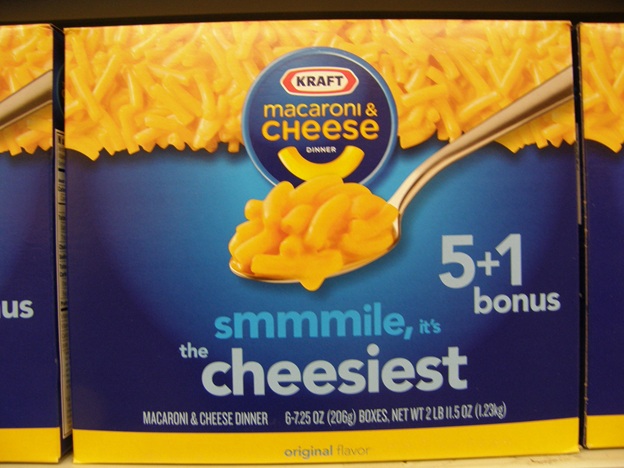 A lot has been written lately about food dyes and the health risks they pose to humans, especially children. Like many people out there, I used to think this issue was no big deal as long as you ate these foods in moderation. That is, until my family discovered food dye sensitivity was the root cause of stomach issues in our younger son, Colby. When barely a year-old, Colby would burst into tears for no reason, often screaming for an hour or more, and eventually cry himself to sleep. Realizing this was an issue, my husband and I consulted our son’s pediatrician, who suggested that if I was breastfeeding him I should eliminate dairy from my diet and have him tested to ensure that nothing was physically wrong. When the results came back normal we assumed it had to be something dietary, so on doctor’s advice, we started keeping a food journal, hoping something would jump out at us. Unfortunately, months of food journaling turned up nothing very significant, except for one product, a well-known commercial brand of macaroni and cheese that seemed to induce violent vomiting attacks in our son. – Orange County Register
A lot has been written lately about food dyes and the health risks they pose to humans, especially children. Like many people out there, I used to think this issue was no big deal as long as you ate these foods in moderation. That is, until my family discovered food dye sensitivity was the root cause of stomach issues in our younger son, Colby. When barely a year-old, Colby would burst into tears for no reason, often screaming for an hour or more, and eventually cry himself to sleep. Realizing this was an issue, my husband and I consulted our son’s pediatrician, who suggested that if I was breastfeeding him I should eliminate dairy from my diet and have him tested to ensure that nothing was physically wrong. When the results came back normal we assumed it had to be something dietary, so on doctor’s advice, we started keeping a food journal, hoping something would jump out at us. Unfortunately, months of food journaling turned up nothing very significant, except for one product, a well-known commercial brand of macaroni and cheese that seemed to induce violent vomiting attacks in our son. – Orange County Register
Toddler meals swimming in salt
By Caitlin Hagan, March 21st, 2013
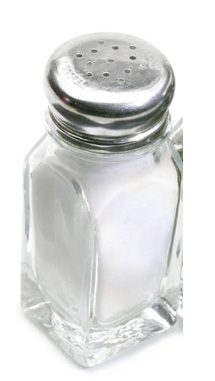 Most packaged meals and snacks marketed to toddlers have more than the recommended amount of sodium per serving, meaning children as young as one are most likely eating far too much salt early in life, according to one of several studies on sodium presented this week. The studies were presented at the American Heart Association‘s Epidemiology and Prevention/Nutrition, Physical Activity and Metabolism 2013 Scientific Sessions in New Orleans. The findings were alarming to researchers since there is evidence a child’s sodium intake is related to the likelihood that he or she will develop hypertension as an adult. Hypertension is a major risk factor of cardiovascular disease and the number-one killer of men and women in the United States. “The good news is that commercial foods for babies, when they start complimentary feeding from 4 to 12 months … are relatively low in sodium,” explains Joyce Maalouf, the study’s lead author and a fellow at the National Center for Chronic Disease Prevention and Health Promotion at the Centers for Disease Control and Prevention.”But the products marketed to toddlers were significantly higher in sodium: more than 75% of the toddler meals and snacks had high sodium content.” – CNN Health
Most packaged meals and snacks marketed to toddlers have more than the recommended amount of sodium per serving, meaning children as young as one are most likely eating far too much salt early in life, according to one of several studies on sodium presented this week. The studies were presented at the American Heart Association‘s Epidemiology and Prevention/Nutrition, Physical Activity and Metabolism 2013 Scientific Sessions in New Orleans. The findings were alarming to researchers since there is evidence a child’s sodium intake is related to the likelihood that he or she will develop hypertension as an adult. Hypertension is a major risk factor of cardiovascular disease and the number-one killer of men and women in the United States. “The good news is that commercial foods for babies, when they start complimentary feeding from 4 to 12 months … are relatively low in sodium,” explains Joyce Maalouf, the study’s lead author and a fellow at the National Center for Chronic Disease Prevention and Health Promotion at the Centers for Disease Control and Prevention.”But the products marketed to toddlers were significantly higher in sodium: more than 75% of the toddler meals and snacks had high sodium content.” – CNN Health
CDC: Higher number of children with autism
By Miriam Falco, March 20th, 2013
 The number of children with autism is “significantly” higher than previously thought, according to a new report released by the Centers for Disease Control and Prevention. School-aged boys were four times more likely to have an autism spectrum disorder (ASD) diagnosis than girls, according to the new data. The CDC released a report a year ago estimating 1 in 88 American children has a form of autism spectrum disorder – neurodevelopmental disorders that lead to impaired language, communication and social skills. The report looked at medical and educational records of all 8-year-olds living in 14 areas of the United States during 2008. This new report is drawn from answers given by parents of children between the ages of 6 and 17 in a telephone survey. Based on the answers provided by parents who chose to answer questions, the survey suggests that 1 in 50 school-aged children have autism. – CNN Health
The number of children with autism is “significantly” higher than previously thought, according to a new report released by the Centers for Disease Control and Prevention. School-aged boys were four times more likely to have an autism spectrum disorder (ASD) diagnosis than girls, according to the new data. The CDC released a report a year ago estimating 1 in 88 American children has a form of autism spectrum disorder – neurodevelopmental disorders that lead to impaired language, communication and social skills. The report looked at medical and educational records of all 8-year-olds living in 14 areas of the United States during 2008. This new report is drawn from answers given by parents of children between the ages of 6 and 17 in a telephone survey. Based on the answers provided by parents who chose to answer questions, the survey suggests that 1 in 50 school-aged children have autism. – CNN Health
What’s Behind Whole Foods’ Decision to Label GMOs in their Stores?
By Jon Rappoport, March 11, 2013
So what will happen, up the road, as Whole Foods customers move beyond their initial excitement at being able to tell whether they’re buying GMOs? Will they continue to care? Or will the labels evoke about as much interest as fat and carb content do now? If Whole Foods’ buying public falls into apathy on the GMO issue, presumably the stores will continue to offer GMO products in profusion, because the cash registers keep ringing. As Whole Foods bosses calculate their strategies, there is another obvious point that must be hammered home. Again. GMO food is nutritionally polluted, deficient, and, in the case of the Roundup Ready crops, drenched with far more toxic chemicals than would ordinarily be present. Farmers across America, who have locked themselves into contracts with Monsanto, are now facing disaster, because superweeds that don’t fold up and die under assault from the Roundup herbicide are taking over their growing fields. So the farmers are doing what are called burndowns. Not once, but several times a year, they’re saturating their land with chemicals stronger than Roundup, like Paraquat, which has been banned in 32 countries. The burndowns are undertaken to kill the march of the superweeds. This means more toxicity in the soil and in the food crops. To present customers with the choice of buying GMO or non-GMO food in stores isn’t like making a distinction between red tomatoes and orange tomatoes. It’s not even an assertion that GMOs are unhealthy. It’s: “let the customer decide.” By this logic, selling food containing, say, high levels of mercury, is acceptable because “people want it.” The trouble, of course, begins with Monsanto and its government-agency allies, who insist, based on nothing, that GMOs are safe and non-toxic. From there, it appears that consumer choice is sane policy. But it isn’t sane. That’s an illusion. – Infowars
Three years later: Buying Local and Organic? You’re Still Eating Plastic Chemicals
By Tom Philpott, March 4, 2013
Bisphenol A (BPA) and phthalates are what’s known as “endocrine disruptors”—that is, at very small doses they interfere with our hormonal systems, giving rise to all manner of health trouble. In peer-reviewed research, BPA has been linked to asthma, anxiety, obesity, kidney and heart disease, and more. The rap sheet for phthalates, meanwhile, includes lower hormones in men, brain development problems, diabetes, asthma, obesity, and, possibly, breast cancer. So, ingesting these industrial chemicals is a bad idea, especially if you’re a kid or a pregnant woman. But avoiding them is very difficult, since they’re widely used in plastics, and are ubiquitous in the food supply. The federal government has not seen fit to ban them generally—although the FDA did outlaw BPA from baby bottles last year (only after the industry had voluntarily removed them) and Congress pushed phthalates out of kids’ toys back in 2008. Otherwise, consumers are on their own to figure out how to avoid ingesting them. Unfortunately, that’s a really hard task—and eating fresh, local, and organic might not be sufficient, as new research (abstract), published in the peer-reviewed Journal of Exposure Science and Environmental Epidemiology, shows. – Mother Jones
Three years ago: FDA Issues Warning About BPA Exposure
January 18, 2010
The Food and Drug Administration is encouraging families to limit their children’s exposure to a chemical found in thousands of household products. CBS News correspondent Kelly Wallace reports that, for years, concerned mothers, environmental groups and some scientists have been warning that Bisphenol A, commonly known as BPA, is unsafe, and can lead to cancers, diabetes and other diseases. Now, in a shift in the agency’s position, the FDA is saying the chemical is of “some concern.” However, as CBS News found out, limiting your exposure to it isn’t easy. The FDA announced, on the basis of new studies that can test for “subtle effects” that, while BPA is still considered safe, it now has “some concern” about the potential effects of the chemical – especially on the “brain behavior and prostate glands in fetuses, infants and young children.” The American Chemistry Council, a product advocacy group, says BPA is safe. – CBS News
Scary Facts About Microwave Popcorn
Leah Zerbe, March 2, 2013
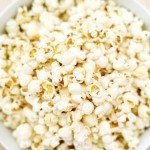 The only thing more terrifying than the horror movies you’re watching is the contents of that popcorn bowl sitting in your lap. In its truest form, popcorn really is a smart, healthy snack–even a superfood. Its purity went up in flames, though, once food manufacturers got hold of the beloved snack and created convenient, microwavable popcorn bags. Americans woof down a whopping 52 quarts of popcorn a year, and much of that is from microwavable versions. But before you nuke one more bag, you need to know the health risks involved.
- Yahoo! Health
The only thing more terrifying than the horror movies you’re watching is the contents of that popcorn bowl sitting in your lap. In its truest form, popcorn really is a smart, healthy snack–even a superfood. Its purity went up in flames, though, once food manufacturers got hold of the beloved snack and created convenient, microwavable popcorn bags. Americans woof down a whopping 52 quarts of popcorn a year, and much of that is from microwavable versions. But before you nuke one more bag, you need to know the health risks involved.
- Yahoo! Health
Iowa on verge of legalizing raw milk; resistance to food tyranny is rising
By Mike Adams, March 01, 2013
(NaturalNews) Iowa is on the verge of legalizing raw milk sales from dairy farms, and legislation has been introduced for that purpose. Raw milk is currently illegal to sell across most of the United States of America, the “land of the free” where freedom has been systematically crushed by oppressive government. Cuba doesn’t outlaw raw milk. China doesn’t outlaw raw milk. Even North Korea doesn’t outlaw raw milk. Raw milk is legal to buy, sell and drink in Peru, Ecuador, Panama and most Central and South American countries. But in America, the FDA mandates that all milk be pasteurized, and this obscenely ignorant rule has resulted in a pandemic of milk allergies, digestive disorders, milk-caused autoimmune disorders and also the criminalization of raw dairy farmers. “The reason this bill is important is we have a growing constituency in Iowa who wants access to this product,” Rep. Jason Schultz, R-Schleswig said in the Daily Iowan. The paper goes on to report:
Schultz, the committee chairman, said he supports the bill because if consumers can buy raw meat and raw eggs, there is no reason they shouldn’t be able to buy raw milk.
The story goes on to discuss the opposition to the raw milk idea, but all such opposition is based on a foolish argument: That the world must be made sanitary in order to be safe. – Natural News
Artificial Sweeteners in Milk?
By Lisa Collier Cool, Feb 28, 2013
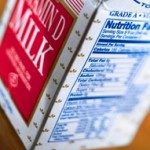 Got diet milk? In a highly controversial move, the dairy industry wants to market artificially sweetened milk—without any special label to alert consumers. In a petition filed with the FDA, the International Dairy Foods Association (IDFA) and the National Milk Producers Federation (NMPF) seek to change the definition of “milk” so that chemical sweeteners like aspartame and sucralose can be used as optional ingredients not listed on the product label. If the petition—originally filed in 2009 and now under consideration by the FDA—is successful, these hidden additives could also be included in 17 other dairy products—including whipping cream, low-fat and non-fat yogurt, eggnog, sweetened condensed milk, sour cream, and half-and-half—without requiring any special labeling. The dairy industry contends that using artificial sweeteners like aspartame as optional ingredients in milk and other dairy foods without any special labeling would “promote more healthy eating” and boost kid appeal. Currently, milk consumption is dropping among both children and adults. – Yahoo Health
Got diet milk? In a highly controversial move, the dairy industry wants to market artificially sweetened milk—without any special label to alert consumers. In a petition filed with the FDA, the International Dairy Foods Association (IDFA) and the National Milk Producers Federation (NMPF) seek to change the definition of “milk” so that chemical sweeteners like aspartame and sucralose can be used as optional ingredients not listed on the product label. If the petition—originally filed in 2009 and now under consideration by the FDA—is successful, these hidden additives could also be included in 17 other dairy products—including whipping cream, low-fat and non-fat yogurt, eggnog, sweetened condensed milk, sour cream, and half-and-half—without requiring any special labeling. The dairy industry contends that using artificial sweeteners like aspartame as optional ingredients in milk and other dairy foods without any special labeling would “promote more healthy eating” and boost kid appeal. Currently, milk consumption is dropping among both children and adults. – Yahoo Health
Quantity of Sugar in Food Supply Linked to Diabetes Rates
By Juliana Bunim on February 27, 2013
 Does eating too much sugar cause diabetes? For years, scientists have said “not exactly.” Eating too much of any food, including sugar, can cause you to gain weight; it’s the resulting obesity that predisposes people to diabetes, according to the prevailing theory. But now the results of a large epidemiological study conducted at UC San Francisco suggest that sugar may also have a direct, independent link to diabetes. Researchers examined data on global sugar availability and diabetes rates from 175 countries over the past decade. After accounting for obesity and a large array of other factors, the researchers found that increased sugar in a population’s food supply was linked to higher diabetes rates, independent of obesity rates. Their study was published Feb. 27 in PLOS ONE. The study provides the first large-scale, population-based evidence for the idea that not all calories are equal from a diabetes-risk standpoint. “It was quite a surprise,” said Sanjay Basu, MD, PhD, an assistant professor of medicine at the Stanford Prevention Research Center and the study’s lead author. The research was conducted while Basu was a medical resident at UCSF and working with Robert Lustig, MD, a pediatric endocrinologist at UCSF Benioff Children’s Hospital and the paper’s senior author. “We’re not diminishing the importance of obesity at all, but these data suggest that at a population level there are additional factors that contribute to diabetes risk besides obesity and total calorie intake, and that sugar appears to play a prominent role.” – UCSF
Does eating too much sugar cause diabetes? For years, scientists have said “not exactly.” Eating too much of any food, including sugar, can cause you to gain weight; it’s the resulting obesity that predisposes people to diabetes, according to the prevailing theory. But now the results of a large epidemiological study conducted at UC San Francisco suggest that sugar may also have a direct, independent link to diabetes. Researchers examined data on global sugar availability and diabetes rates from 175 countries over the past decade. After accounting for obesity and a large array of other factors, the researchers found that increased sugar in a population’s food supply was linked to higher diabetes rates, independent of obesity rates. Their study was published Feb. 27 in PLOS ONE. The study provides the first large-scale, population-based evidence for the idea that not all calories are equal from a diabetes-risk standpoint. “It was quite a surprise,” said Sanjay Basu, MD, PhD, an assistant professor of medicine at the Stanford Prevention Research Center and the study’s lead author. The research was conducted while Basu was a medical resident at UCSF and working with Robert Lustig, MD, a pediatric endocrinologist at UCSF Benioff Children’s Hospital and the paper’s senior author. “We’re not diminishing the importance of obesity at all, but these data suggest that at a population level there are additional factors that contribute to diabetes risk besides obesity and total calorie intake, and that sugar appears to play a prominent role.” – UCSF
9 Surprising Facts About Junk Food
Feb. 27, 2013
http://www.motherjones.com/tom-philpott/2013/02/food-industry-michael-moss-junk
Riffing on his new book Salt Sugar Fat: How the Food Industry Hooked Us, ace New York Times investigative reporter Michael Moss is suddenly everywhere—he’s out with a blockbuster article in the Times Magazine and just appeared on Fresh Air. I haven’t had a chance to read the book yet, but I’ve skimmed it, and it looks excellent. Here are nine quick takeaways… – Mother Jones
Who Has the Guts for Gluten?
By MOISES VELASQUEZ-MANOFF, February 23, 2013
WE know that the proteins called gluten, found in wheat and other grains, provoke celiac disease. And we know how to treat the illness: a gluten-free diet. But the rapidly increasing prevalence of celiac disease, which has quadrupled in the United States in just 50 years, is still mystifying. Scientists are pursuing some intriguing possibilities. One is that breast-feeding may protect against the disease. Another is that we have neglected the teeming ecosystem of microbes in the gut — bacteria that may determine whether the immune system treats gluten as food or as a deadly invader. …Yet the more scientists study celiac disease, the more some crucial component appears in need of identification. Roughly 30 percent of people with European ancestry carry predisposing genes, for example. Yet more than 95 percent of the carriers tolerate gluten just fine. So while these genes (plus gluten) are necessary to produce the disease, they’re evidently insufficient to cause it. …A recent study, which analyzed blood serum from more than 3,500 Americans who were followed since 1974, suggested that such a trigger could strike adults at any time. By 1989, the prevalence of celiac disease in this cohort had doubled. “You’re talking about an autoimmune disease in which we thought we had all the dots connected,” says Alessio Fasano, head of the Center for Celiac Research and Treatment at the Massachusetts General Hospital for Children in Boston, and the senior author of the study. “Then we start to accumulate evidence that there was something else.” – The New York Times
Interview with Bruce Bradley: A Former Big Food Executive Talks
By Jason Leake, November 20th, 2012
Most of us have heard at one time or another about how the food industry is the devil. But is it really? Or are all these kale-loving real food bloggers (like us) just overreacting? Today I am talking with Bruce Bradley, a former Big Food exec turned food advocate, blogger, and author, to find out the real deal. To my knowledge, Bruce is the only former Big Food marketer actively speaking out about concerns over the food we eat, and he has just published a novel called Fat Profits which exposes the industry… Q: What do you think every mom should know about Big Food? A: The most important thing to remember is that Big Food companies are run for profit, and not the long-term health of consumers. Let’s face it, Big Food first and foremost answers to Wall Street, and in most cases the concepts of good nutrition and food safety fall by the wayside. We also need to realize that Big Food is smart, stealthy, and wants to create an emotional relationship with us. After all, food is powerfully linked to our feelings, friendships, and family traditions. Big Food companies use this to their advantage. My guess is that many of the moms reading 100 Days of Real Food are already clued in to this. They realize that something is very wrong. Unfortunately, the vast majority of parents think everything is fine. They trust Big Food and haven’t discovered a lot of information is being hidden from them. That’s got to change, and that’s one of the reasons I’m speaking out… – 100 Days of Real Food
Are Junk Food Makers Worse than Tobacco Industry Giants?
By Beth Greenfield, Feb 20, 2013
 It’s far from an accident that you’re addicted to chips—or soda or pre-made lunch packs or probably any other processed-food you can think of, explains a very un-sugar-coated New York Times Magazine investigative piece set to hit stands this weekend. In “The Extraordinary Science of Addictive Junk Food,” previewed online now and adapted from his forthcoming book “Salt Sugar Fat: How the Food Giants Hooked Us,” Pulitzer Prize winning reporter Michael Moss delves deep into the long history of how snack food and beverage makers scheme with a mix of science, willful ignorance, and masterful marketing to sell mountains of their salty, sugary products. – Shine
It’s far from an accident that you’re addicted to chips—or soda or pre-made lunch packs or probably any other processed-food you can think of, explains a very un-sugar-coated New York Times Magazine investigative piece set to hit stands this weekend. In “The Extraordinary Science of Addictive Junk Food,” previewed online now and adapted from his forthcoming book “Salt Sugar Fat: How the Food Giants Hooked Us,” Pulitzer Prize winning reporter Michael Moss delves deep into the long history of how snack food and beverage makers scheme with a mix of science, willful ignorance, and masterful marketing to sell mountains of their salty, sugary products. – Shine
Is Wheat Gluten Really Bad for Everyone?
By Kiera Butler, Thu Feb. 7, 2013
Gluten intolerance has been quite the hot topic this week—for more on the subject, see this New York Times piece on the uptick in cases of gluten sensitivity, or this other one, which mentions gluten as a possible trigger for inflammation that worsened a little boy’s arthritis. A few months ago, I visited a well-meaning but ineffective chiropractor. I was seeking relief for pain in my hip, but she seemed much more interested in my mental health. “Do you ever feel stressed?” she asked. “Uh, yeah,” I said. “Doesn’t everyone?” “Well, I think you should try a gluten-free diet for that,” she said. She then pulled out a prescription pad and wrote down the names of a few specialty food manufacturers. I nodded agreeably, quietly resolving to chuck her note into the nearest recycling bin. As gluten-free breads, pastas, and cereals have proliferated over the past few years, I had begun to suspect that so-called gluten sensitivity was not so much a medical condition as a nutritional fad. – Mother Jones
FDA Urged to Determine Safe Limits on High-Fructose Corn Syrup and Other Sugars in Soft Drinks
February 13, 2013
Unsafe levels of high-fructose corn syrup or sugar in soda and other sugar drinks cause obesity, diabetes, heart disease, and other health problems, the Center for Science in the Public Interest said today. Along with leading scientists and other health-advocacy organizations, the group is urging the Food and Drug Administration to determine a safe level of added sugars for beverages as part of a comprehensive strategy to reduce Americans’ dangerously high sugar consumption. Public health departments in Baltimore, Boston, Los Angeles, Philadelphia, Seattle, Portland, OR, and other jurisdictions are also supporting the proposal. A typical 20-ounce bottle of soda contains about 16 teaspoons of sugars from high-fructose corn syrup. That’s twice the daily limit recommended by the American Heart Association, which advises consuming no more than 6 teaspoons of added sugars per day for women and no more than 9 teaspoons for men. CSPI and the scientists supporting the petition say that despite the concerns over artificial sweeteners, diet sodas are safer than today’s full-calorie sodas. A gradual change to safer drinks will be made easier by the use of new high-potency sweeteners like rebiana, which is made from the stevia plant, and “sweetness enhancers” being developed by major manufacturers. – CSPI
Food Babe Investigates: How Food Companies Exploit Americans With Ingredients Banned in Other Countries
By Food Babe, February 11, 2013
Thoughts of outrage, unfairness, disbelief, and ultimately grief consumed me while I was doing this investigation. A list of ingredients that are banned across the globe but still allowed for use here in the American food supply recently made news. While I have written about some of those ingredients before, this list inspired me to look a little deeper and find out how pervasive this issue is for us. Could these banned ingredients be contributing to the higher mortality and disease rates here in the U.S.? The health of Americans is downright grim according to a report just released by the Institute of Medicine and the National Research Council . It declares that “Americans are sicker and die younger than other people in wealthy nations.” The United States spends 2.5 times more on health care than any other nation, however, when compared with 16 other nations we come on dead last in terms of health and life expectancy for men and near the bottom for women. …Recently, I spent some time down in Mississippi volunteering in the most obese county in the nation. I found that while social and economic factors do play a part in this epidemic, the main culprit was the lack of nutrition education. The victims of obesity are likely the same victims of systematic brainwashing from Big Food marketers, relying on diet soda or low fat products or looking only at calories on product labels. Basically they are doing what the food industry has been teaching them about losing weight versus finding out the truth about real food. – 100 Days of Real Food
Everyday foods that endanger your health
By Leah Zerbe and Emily Main
What’s the one food you refuse to eat? Peas, tofu, liver and onions? Whatever it is, it’s probably because you don’t like the way it tastes, not necessarily because it contains ingredients suspected of causing cancer or because it was picked by farmers wearing Hazmat suits. Yet, there are still a lot of those foods on store shelves, and food-industry insiders, who know what goes on behind the scenes, refuse to eat them. We polled some of those insiders—people who know the business and work daily to evict pesticides, genetically modified organisms, animal cruelty, social injustice, and unhealthy foods from the food supply—to find out what they know about the dark side of “convenience” foods and what they will eat. Take note so you, too, can avoid the worst of what grocery stores have to offer. – MSN
Coca-Cola drinking ‘linked to New Zealander’s death’
12 February 2013
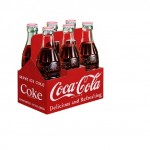 Natasha Harris, who died three years ago after a cardiac arrest, drank up to 10 litres of the fizzy drink each day. This is twice the recommended safe limit of caffeine and more than 11 times the recommended sugar intake. Coca-Cola had argued that it could not be proved its product had contributed to Ms Harris’ death. The coroner’s verdict came on the day Coca-Cola Sales said sales in Europe and China fell in the last quarter of 2012, and warned of a “volatile” year to come. Natasha Harris, a mother of eight from the southern New Zealand city of Invercargill, suffered from ill health for years before her death. Her family said she had developed an addiction to Coca-Cola and would get withdrawal symptoms, including “the shakes”, if she went without her favourite drink. “(She would) go crazy if she ran out… she would get the shakes, withdrawal symptoms, be angry, on edge and snappy,” her mother-in-law Vivien Hodgkinson told the coroner’s inquest last year. Ms Harris drank Coke throughout her waking hours and her teeth had been removed because of decay. Coroner David Crerar said her Coca-Cola consumption had given rise to cardiac arrhythmia, a condition when the heart beats too fast or too slow. “I find that when all the available evidence is considered, were it not for the consumption of very large quantities of Coke by Natasha Harris, it is unlikely that she would have died when she died and how she died,” Mr Crerar’s finding said. The coroner calculated that drinking 10 litres (17.5 pints) of Coke amounted to more than 1kg (2.2lb) of sugar and 970mg of caffeine, Television New Zealand (TVNZ) reports. – BBC
Natasha Harris, who died three years ago after a cardiac arrest, drank up to 10 litres of the fizzy drink each day. This is twice the recommended safe limit of caffeine and more than 11 times the recommended sugar intake. Coca-Cola had argued that it could not be proved its product had contributed to Ms Harris’ death. The coroner’s verdict came on the day Coca-Cola Sales said sales in Europe and China fell in the last quarter of 2012, and warned of a “volatile” year to come. Natasha Harris, a mother of eight from the southern New Zealand city of Invercargill, suffered from ill health for years before her death. Her family said she had developed an addiction to Coca-Cola and would get withdrawal symptoms, including “the shakes”, if she went without her favourite drink. “(She would) go crazy if she ran out… she would get the shakes, withdrawal symptoms, be angry, on edge and snappy,” her mother-in-law Vivien Hodgkinson told the coroner’s inquest last year. Ms Harris drank Coke throughout her waking hours and her teeth had been removed because of decay. Coroner David Crerar said her Coca-Cola consumption had given rise to cardiac arrhythmia, a condition when the heart beats too fast or too slow. “I find that when all the available evidence is considered, were it not for the consumption of very large quantities of Coke by Natasha Harris, it is unlikely that she would have died when she died and how she died,” Mr Crerar’s finding said. The coroner calculated that drinking 10 litres (17.5 pints) of Coke amounted to more than 1kg (2.2lb) of sugar and 970mg of caffeine, Television New Zealand (TVNZ) reports. – BBC
Five Things Your Doctor Should Tell You, But Won’t
By Kiera Butler, Feb. 11, 2013
As a lifelong hypochondriac, I’ve always been comforted by the Hippocratic oath. What an excellent idea, having doctors pledge to put patients first. So I was less than thrilled to learn that doctors are under increasing pressure—from state legislatures, industry, and other groups—to break that oath by withholding key pieces of information from their patients. “We are very concerned about special interests attempting to influence our practices,” says Valerie Arkoosh, president of the National Physicians Alliance (NPA). “We’ve seen state legislatures overreaching a lot with regard to doctor-patient relationship.” Here are five things that—depending on where you live—your doctor could be keeping from you… – Mother Jones
Coke: Wait, People Thought Vitaminwater Was Good for You?
By Tom Philpott Jan. 18, 2013
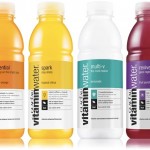 Coca-Cola’s marketing encourages the healthy image. According vitaminwater’s website, the Power -C flavor of vitaminwater delivers “zinc and vitamin C to power your immune system”; while the XXX offers “antioxidant vitamins to help fight free radicals and help support your body.” And so on. But not everyone’s convinced that vitaminwater does a body good. Back in 2009, the Center for Science in the Public Interest sued Coca-Cola for making “deceptive and unsubstantiated” health claims about the products. In 2010, a US federal district court judge rejected Coca-Cola’s motion to dismiss the suit (document here), noting that Coke’s lawyers had made a remarkable argument: “At oral argument defendants suggested that no consumer could reasonably be misled into thinking vitaminwater was a healthy beverage.” In other words, no one actually believes our flashy marketing—it’s obviously nonsense. The vitaminwater suit still hasn’t been resolved, a CSPI spokesperson informed me. And hilarity over Coca-Cola’s cynical defense strategy is ongoing, too. Stephen Colbert spoofed it just this week: And I think Coke’s obesity campaign should be read in the same light: No consumer should be misled into thinking that the sugary-beverage giant (its heavily marketed array of “diet” products nothwithstanding) has been transformed into an obesity-fighting machine. Or, as New York University dietician Marion Nestle put it on her Food Politcs blog, “Coca-Cola fights obesity? Oh, please.” – Mother Jones
Coca-Cola’s marketing encourages the healthy image. According vitaminwater’s website, the Power -C flavor of vitaminwater delivers “zinc and vitamin C to power your immune system”; while the XXX offers “antioxidant vitamins to help fight free radicals and help support your body.” And so on. But not everyone’s convinced that vitaminwater does a body good. Back in 2009, the Center for Science in the Public Interest sued Coca-Cola for making “deceptive and unsubstantiated” health claims about the products. In 2010, a US federal district court judge rejected Coca-Cola’s motion to dismiss the suit (document here), noting that Coke’s lawyers had made a remarkable argument: “At oral argument defendants suggested that no consumer could reasonably be misled into thinking vitaminwater was a healthy beverage.” In other words, no one actually believes our flashy marketing—it’s obviously nonsense. The vitaminwater suit still hasn’t been resolved, a CSPI spokesperson informed me. And hilarity over Coca-Cola’s cynical defense strategy is ongoing, too. Stephen Colbert spoofed it just this week: And I think Coke’s obesity campaign should be read in the same light: No consumer should be misled into thinking that the sugary-beverage giant (its heavily marketed array of “diet” products nothwithstanding) has been transformed into an obesity-fighting machine. Or, as New York University dietician Marion Nestle put it on her Food Politcs blog, “Coca-Cola fights obesity? Oh, please.” – Mother Jones
Lighter Menus Appeal to Diners and Owners
By STEPHANIE STROM, February 6, 2013
Driven by pressures like consumer demand and looming federal regulations that will require them to post calorie counts on menus, restaurant chains around the country are adding more nutritious choices and shrinking portion sizes. The smaller portions, which are not necessarily cheaper, are the first step toward reversing the practice of piling more food on a plate than anyone needs in a single meal, a trend that began nearly three decades ago. Besides making a contribution to customers’ health, restaurant owners are finding that the move is paying off financially… One gauge — the number of restaurants with vetted healthy options listed on the site — has increased more than 2,000 percent, and many have been added just in the last couple of years, Ms. Jones-Mueller said. “Customers really want these items, so restaurants are working to make them more appealing,” she said. – The New York Times
What’s in your energy drink?
By Alexandra Sifferlin, February 6, 2013
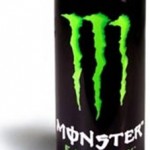 As concerns over the safety of energy drinks continue to grow, a study outlines the recent evidence regarding the content, benefits, and risks of the beverages that are popular with adolescents. The study, published in the journal Pediatrics, reports that more teens are downing energy drinks; in 2003, 16% regularly consumed the drinks, while in 2008, that percentage jumped to 35%. One study of college student consumption found 50% of students drank at least one to four a month. This year, research documented a jump in energy drink-related emergency room visits and politicians and consumers called upon the Food and Drug Administration (FDA) to look into deaths associated with the drinks. What do the beverages contain that could pose a health hazard? Currently, the amount of caffeine added to energy drinks is not regulated by the FDA, so often the amounts listed (if they’re listed) are inaccurate. Studies also don’t support all of the claims made by the manufacturers on some of the other ingredients’ ability to maintain energy. The study authors broke down the most common ingredients found in energy drinks: caffeine, guarana, taurine, ginseng, sugars and B vitamins and why they might be problematic. – CNN Health
As concerns over the safety of energy drinks continue to grow, a study outlines the recent evidence regarding the content, benefits, and risks of the beverages that are popular with adolescents. The study, published in the journal Pediatrics, reports that more teens are downing energy drinks; in 2003, 16% regularly consumed the drinks, while in 2008, that percentage jumped to 35%. One study of college student consumption found 50% of students drank at least one to four a month. This year, research documented a jump in energy drink-related emergency room visits and politicians and consumers called upon the Food and Drug Administration (FDA) to look into deaths associated with the drinks. What do the beverages contain that could pose a health hazard? Currently, the amount of caffeine added to energy drinks is not regulated by the FDA, so often the amounts listed (if they’re listed) are inaccurate. Studies also don’t support all of the claims made by the manufacturers on some of the other ingredients’ ability to maintain energy. The study authors broke down the most common ingredients found in energy drinks: caffeine, guarana, taurine, ginseng, sugars and B vitamins and why they might be problematic. – CNN Health
The 11 Scariest Things in Your Food
By Bill Phillips, Feb 04, 2013
I always tell my daughters they can make a difference in the world, even at their tender ages of 10 and 7. To them, I probably sound like the teacher from Peanuts—they’re more interested in soccer and American Girl right now—but I hope the lesson eventually sinks in. My latest example of a kid heroics for them: 15-year-old Sarah Kavanagh from Hattiesburg, Mississippi, who gathered more than 200,000 signatures in her online petition asking Gatorade to remove a controversial flame-retardant chemical. Last week, Gatorade announced that they would be removing the ingredient, brominated vegetable oil (BVO), within the next couple of months. That’s great news—especially for me personally, because I love the stuff! Actually, so do my daughters. While Gatorade spokeswoman Molly Carter said the decision wasn’t in response to Sarah’s petition, the teen is claiming victory. Either way, we all win. Truth is, chemicals that are used as weed killer, flame retardant, and sunscreen are startlingly common in your supermarket. But you won’t find “carcinogens,” “paint chemicals,” or “beaver anal gland juice” on the back panel. They’ll be hidden under names like “Butylated HydroxyAnisole” or “natural flavoring.” Break through the science experiment to find out what you’re really eating. Here are the 11 scariest ingredients in your food… – Yahoo Health
Goodbye, high-fat chips: New rules for school snacks
Nanci Hellmich, February 1, 2013
New government proposals would set limits on calories, fat and sugar in some school foods.
Out with the candy bars, high-fat chips, full-calorie sodas and sugary pastries sold in school a la carte lines, vending machines and snack bars during the school day. Today, the government released its proposed standards for “competitive foods,” the name given to foods that are not part of the regular school meals. The standards set limits for calories, fat, sugar and sodium. The proposed rules do not apply to foods sold at after-school fundraisers, bake sales or concession stands at sporting events and other after-school activities. They also don’t affect the foods kids bring in their lunches or what’s served at birthday parties, holidays and other celebrations at school. “Good nutrition lays the groundwork for good health and academic success,” Agriculture Secretary Tom Vilsack said in a statement. Updated nutrition guidelines for school lunch and breakfast went into effect this school year. The latest proposals, which are now open for public comment, say snack items sold in schools must have no more than 200 calories per portion. – USA TODAY
Gatorade to remove controversial ingredient
http://www.usatoday.com/story/news/nation/2013/01/25/gatorade-controversial-ingredient/1865155/
Candice Choi, Associated Press, January, 25, 2013
 PepsiCo Inc. is removing a controversial ingredient, brominated vegetable oil, from its Gatorade sports drink in response to customer complaints. A spokeswoman for the company, Molly Carter, said Friday that the move was in the works for the past year after the company began “hearing rumblings” from consumers about the ingredient. She said it wasn’t a response to a recent petition on Change.org by a Mississippi teenager. The ingredient is also listed in other drinks, including some flavors of Powerade, made by rival Coca-Cola Co. The Atlanta-based company did not say whether it would remove the ingredient from Powerade as well but noted that it takes customers’ concerns into account when looking for ways to improve its drinks. Ingredients in food and drinks have come under greater scrutiny in recent years, helped by the ability of consumers to mobilize online. The petition on Change.org noted that brominated vegetable oil has been patented as a flame retardant and is banned in Japan and the European Union. It had more than 200,000 supporters Friday. For Gatorade, Carter said the ingredient is used as an “emulsifier,” meaning it distributes flavoring evenly so that it doesn’t collect at the surface. She said it was used only in select flavors including such as orange and citrus. Brominated vegetable oil, or BVO, is still used in other drinks, including Coca-Cola’s Fanta and PepsiCo’s Mountain Dew. – USA Today
PepsiCo Inc. is removing a controversial ingredient, brominated vegetable oil, from its Gatorade sports drink in response to customer complaints. A spokeswoman for the company, Molly Carter, said Friday that the move was in the works for the past year after the company began “hearing rumblings” from consumers about the ingredient. She said it wasn’t a response to a recent petition on Change.org by a Mississippi teenager. The ingredient is also listed in other drinks, including some flavors of Powerade, made by rival Coca-Cola Co. The Atlanta-based company did not say whether it would remove the ingredient from Powerade as well but noted that it takes customers’ concerns into account when looking for ways to improve its drinks. Ingredients in food and drinks have come under greater scrutiny in recent years, helped by the ability of consumers to mobilize online. The petition on Change.org noted that brominated vegetable oil has been patented as a flame retardant and is banned in Japan and the European Union. It had more than 200,000 supporters Friday. For Gatorade, Carter said the ingredient is used as an “emulsifier,” meaning it distributes flavoring evenly so that it doesn’t collect at the surface. She said it was used only in select flavors including such as orange and citrus. Brominated vegetable oil, or BVO, is still used in other drinks, including Coca-Cola’s Fanta and PepsiCo’s Mountain Dew. – USA Today
Food fraud on the rise
http://eatocracy.cnn.com/2013/01/23/faux-pas-food-fraud-on-the-rise/?hpt=he_c2
January 23rd, 2013
If you are what you eat, you might be having an identity crisis. A new study on food fraud was released Wednesday morning by U.S. Pharmacopeial Convention (USP), a scientific nonprofit organization that helps set standards for the “quality, safety and benefit” of foods and medicines. The group runs a searchable online database of food fraud reports at foodfraud.org and nearly 800 new records were added as part of the study – a 60% increase from last year. Food fraud, as defined by the U.S. Food and Drug Administration (FDA), is the adulteration, dilution or mislabeling of goods. USP further defines food fraud in the study as “the fraudulent addition of nonauthentic substances or removal or replacement of authentic substances without the purchaser’s knowledge for economic gain to the seller.” The new records show that the most commonly fraudulent products are olive oil, milk, saffron, honey and coffee. Tea, fish, clouding agents (used in fruit juices, like lemon, to make products look freshly squeezed), maple syrup and spices (turmeric, black pepper and chili pepper) were also top imposters. CNN Eatocracy
Evidence grows for narcolepsy link to GSK swine flu shot
http://www.reuters.com/article/2013/01/22/us-narcolepsy-vaccine-pandemrix-idUSBRE90L07H20130122
By Kate Kelland, January 22, 2013
Emelie Olsson is plagued by hallucinations and nightmares. When she wakes up, she’s often paralyzed, unable to breathe properly or call for help. During the day she can barely stay awake, and often misses school or having fun with friends. She is only 14, but at times she has wondered if her life is worth living. Emelie is one of around 800 children in Sweden and elsewhere in Europe who developed narcolepsy, an incurable sleep disorder, after being immunized with the Pandemrix H1N1 swine flu vaccine made by British drugmaker GlaxoSmithKline in 2009. Finland, Norway, Ireland and France have seen spikes in narcolepsy cases, too, and people familiar with the results of a soon-to-be-published study in Britain have told Reuters it will show a similar pattern in children there. Their fate, coping with an illness that all but destroys normal life, is developing into what the health official who coordinated Sweden’s vaccination campaign calls a “medical tragedy” that will demand rising scientific and medical attention. – Reuters Health
ADHD rates creeping up in California
By Genevra Pittman, January 21, 2013
http://www.reuters.com/article/2013/01/21/us-adhd-california-idUSBRE90K0V920130121
More children are being diagnosed with attention deficit hyperactivity disorder (ADHD) now than were a decade ago, according to new research from a large California health plan. It’s not clear what’s behind that trend, researchers noted. Possible explanations include better awareness of the condition among parents and doctors or improved access to health care for kids with symptoms, according to Dr. Darios Getahun, the study’s lead author. …In an analysis of Kaiser Permanente medical records, researchers found the proportion of five- to 11-year-olds diagnosed with ADHD increased from 2.5 percent in 2001 to 3.1 percent in 2010. …Common medications used to treat ADHD include stimulants such as Vyvanse, Ritalin and Concerta. …Parental reports suggest that closer to one in ten kids and teens has been diagnosed with ADHD, according to the Centers for Disease Control and Prevention, and rates vary by state – from 5.6 percent of kids in Nevada to 15.6 percent of North Carolina youth. – Reuters Health
Anti-sugar doctor Robert Lustig talks more about what’s wrong with the American diet
By Monica Eng, January 17, 2013
The Chicago Tribune’s Good Eating section this week features an interview with Dr. Robert Lustig who gained fame for his anti-sugar lecture on YouTube and now his new book called “Fat Chance.” He posits that the nation’s increased consumption of sweetened food and drink (supported by industry and the government) is behind our obesity. “…Of the 600,000 food items currently in the American grocery store, 80 percent of them have added sugar. In many convenience stores you can’t find food that hasn’t been adulterated and processed. And processed food is high sugar, low fiber. High sugar for palatability and low fiber for shelf life. So you’ve already been told what to eat but you didn’t know it. Most of your food has been chosen for you. So the real question here is who do you want in your kitchen? The government, who will take your wallet and freedom? Or the food industry who’ve already taken your wallet, your freedom and your health? What we really need is a dialogue at the highest levels of government but about what needs to happen. The problem is there is no reason for them to have this discussion because they say we don’t have the science on it. The fact is we do [have the science] and it’s all in the book with footnotes and references.” – Chicago Tribune
Flu vaccine attitudes abroad differ from U.S.
By Jen Christensen, January 17, 2013
http://www.cnn.com/2013/01/17/health/flu-vaccine-policy/index.html?hpt=hp_bn12
Only the U.S. and Canada actually encourage everyone older than 6 months to get the flu vaccine. Apparently, not a single country in Europe asks the general population to seek that same kind of protection, according to Robb Butler, the World Health Organization technical officer in vaccine preventable diseases and immunizations in the organization’s Europe office in the Netherlands. That’s because global health experts say the data aren’t there yet to support this kind of blanket vaccination policy, nor is there enough money. In fact, some scientists say the enthusiasm for mass vaccination in the United States may hurt efforts to create a better vaccine. This year, a year in which the vaccine is supposed to be a good match to the virus, the Centers for Disease Control and Prevention estimates the vaccine is only 62% effective. And in the segments of the population that are most susceptible to the extreme effects of the flu — like the elderly, who make up the majority of the cases of flu-related deaths — the vaccinations are even less effective. So is why is everyone urged to get vaccinated? – CNN Health
Read related: Secret government documents reveal vaccines to be a total hoax.
20K ER Visits Linked to Energy Drinks
By Lisa Stark, Jan 16, 2013
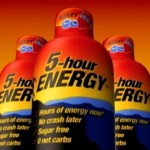 A new government study is calling popular energy drinks “a rising public health problem” that is sending more and more people to the emergency rooms. The study, from a survey of U.S. hospitals by the Substance Abuse and Mental Health Services Administration, said that the number of emergency-room visits linked to energy drinks had doubled in four years – from 10,000 in 2007 to 20,000 in 2011. And of those 20,000 ER visits in 2011, 42 percent had mixed the energy drink with another stimulant such as Adderal or Ritalin or with alcohol. Fifty-eight percent had consumed just the drink. – Yahoo News
A new government study is calling popular energy drinks “a rising public health problem” that is sending more and more people to the emergency rooms. The study, from a survey of U.S. hospitals by the Substance Abuse and Mental Health Services Administration, said that the number of emergency-room visits linked to energy drinks had doubled in four years – from 10,000 in 2007 to 20,000 in 2011. And of those 20,000 ER visits in 2011, 42 percent had mixed the energy drink with another stimulant such as Adderal or Ritalin or with alcohol. Fifty-eight percent had consumed just the drink. – Yahoo News
Foods You Should Cut From Your Diet
Leah Zerbe And Emily Main, Rodale, January 15, 2013
http://health.yahoo.net/articles/nutrition/photos/14-foods-you-should-cut-your-diet#0
What’s the one food you refuse to eat? Peas, tofu, liver and onions? Whatever it is, it’s probably because you don’t like the way it tastes, not necessarily because it contains ingredients suspected of causing cancer or because it was picked by farmers wearing Hazmat suits. Yet, there are still a lot of those foods on store shelves, and food-industry insiders, who know what goes on behind the scenes, refuse to eat them. We polled some of those insiders–people who know the business and work daily to evict pesticides, genetically modified organisms, animal cruelty, social injustice, and unhealthy foods from the food supply–to find out what they know about the dark side of “convenience” foods and what they will eat. Take note so you, too, can avoid the worst of what grocery stores have to offer. … Ironically, there’s a lot of evidence that suggest using artificial sweeteners, which have zero calories, is just as bad for your waistline as using regular, high-calorie sugar. For instance, research from the University of Texas has found that mice fed the artificial sweetener aspartame had higher blood sugar levels (which can cause you to overeat) than mice on an aspartame-free diet. Not only are they bad for your health, scientists have detected artificial sweeteners in treated wastewater, posing unknown risks to fish and other marine life. Plus, as Rodale says, “They’re unnatural, nonorganic, taste horrible, and lead to all sorts of bad health consequences, false expectations, and short-term strategic thinking.” – Yahoo Health
Fast Food Linked to Asthma, Eczema in Kids
http://shine.yahoo.com/healthy-living/fast-food-linked-asthma-eczema-kids-144300118.html
By Lylah M. Alphonse , January 15, 2013
We’ve all heard plenty of warnings about the dangers of fast food and how it’s at least partly to blame for our childhood obesity epidemic. But a new international study shows that kids who eat fast food three or more times per week are at risk for more than just a little extra weight: Those chicken nuggets and cheeseburgers have now been linked to higher rates of asthma and eczema in kids. The study, published Monday in the medical journal Thorax, used data from more than 319,000 13- and 14-year-olds in 51 countries, along with 181,000 6- to 7-year-olds from 31 countries. All of the participants were also involved in the International Study of Asthma and Allergies in Childhood, a collaborative research project made up of nearly 2 million children from 100 countries. The researchers found that, out of the 15 food types in the questionnaire, only fast food showed an association with asthma and eczema in both age groups regardless of gender and socio-economic status. Three or more servings a week was linked to a 39 percent increase in severe asthma among teens and a 27 percent increased risk among younger children. “A consistent pattern for the adolescent group was found for the relationship between symptoms and fast foods,” the researchers wrote in the study. “As adolescents are generally known to be high consumers of fast food, these results that show a significant increased risk of developing each or all three conditions may be a genuine finding.” … A 2011 study published in Nutrition Research and Practice suggested that additives in processed foods could also trigger an allergic reaction in some kids, but Williams and his team say that fat intake, not food allergies or additives, is probably the main culprit. – Shine from Yahoo!
Global report: Obesity bigger health crisis than hunger
http://www.cnn.com/2012/12/13/health/global-burden-report/index.html
By Danielle Dellorto, December 14, 2012
Obesity is a bigger health crisis globally than hunger, and the leading cause of disabilities around the world, according to a new report published Thursday in the British medical journal The Lancet. Nearly 500 researchers from 50 countries compared health data from 1990 through 2010 for the Global Burden of Disease report, revealing what they call a massive shift in global health trends. “We discovered that there’s been a huge shift in mortality. Kids who used to die from infectious disease are now doing extremely well with immunization,” said Ali Mokdad, co-author of the study and professor of global health at the Institute for Health Metrics and Evaluation at the University of Washington, which led the collaborative project. “However, the world is now obese and we’re seeing the impact of that.” People are living longer than projected in 1990 — on average, 10.7 more years for men, and 12.6 more years for women. But for many of them, the quality of life during those years is not good. On average, people are plagued by illness or pain during the last 14 years of life, according to the study. Researchers credit advances in medical technology for longer lives. “We’ve figured out how to keep the person who suffered a stroke alive, but then they’re living disabled for years afterward. That’s not the quality of life that person expected, ” Mokdad said. – CNN Health
Why Americans are dying earlier than their international peers
http://www.cnn.com/2013/01/09/health/international-health-report/index.html?hpt=hp_bn12
By Jacque Wilson, CNN, January 9, 2013
Despite spending more per person on health care than any other country, Americans are getting sicker and dying younger than our international peers — a problem persisting across all ages and both genders, according to a new report. In 2011, the National Research Council found life expectancy in the United States was increasing at a slower rate than in other high-income democracies. Shortly after, the NRC and Institute Of Medicine convened a panel of experts to investigate why. The panel was given 18 months to review recent health studies from 16 “peer countries”: Australia, Austria, Canada, Denmark, Finland, France, Germany, Italy, Japan, Norway, Portugal, Spain, Sweden, Switzerland, the Netherlands and the United Kingdom. The panel released its report, titled “U.S. Health in International Perspective: Shorter Lives, Poorer Health,” on Wednesday. “Our panel was unprepared for the gravity of the finding we uncovered,” chair Steven Woolf wrote in the report’s preface. “We hope that others will take notice.” This is not a new problem, Woolf noted on a conference call about the report. “It’s been going on since 1980 and it’s getting progressively worse.” …Waiting for more research isn’t the answer, Woolf said. Individuals can make changes now, listening to advice about healthy diets and exercise, or making sure to wear their seat belts. As for policy, the panel hopes this report will open a broader discussion about what we value as a nation. –CNN Health
Coca-Cola weighs in on obesity fight
By Ben Tinker January 14, 2013
http://www.cnn.com/2013/01/14/health/coke-obesity/index.html?hpt=hp_bn12
It’s a statistic we’ve been hearing far too often — and for far too long. Two-thirds of American adults are either overweight or obese — and the problem is only getting worse. Even Coca-Cola, the world’s largest beverage company, is now calling obesity “the issue of this generation.” The world’s most valuable brand took the last seat at a crowded table Monday, when it launched an ad campaign aimed at “reinforcing its efforts to work together with American communities, business and government leaders to find meaningful solutions to the complex challenge of obesity.” The first commercial of the campaign, a two-minute video called “Coming Together,” begins with a voice-over: “For over 125 years, we’ve been bringing people together. Today, we’d like people to come together on something that concerns all of us: obesity.” The spots are scheduled to run on television, including CNN, beginning this week. Coca-Cola points out in the video it offers 180 low- and no-calorie beverages out of more than 650 beverage products. Coke has come under increased fire over the past year as a predominant target of an anti-obesity crusade, led in large part by the Center for Science in the Public Interest, also known as the CSPI. Appearing on CNN’s “Sanjay Gupta MD” in October, Michael Jacobson, executive director of the CSPI, conceded that sugar and soda consumption are, in fact, on the decline. “But,” he said, “the scientific community has … reached a consensus that soft drinks are the one food or beverage that’s been demonstrated to cause weight gain and obesity. And if we’re going to deal with this obesity epidemic, that’s the place to start.” – CNN Health
A fast-food, sugar fiasco
http://www.cnn.com/2013/01/11/health/lustig-western-diet/index.html?hpt=he_c2
By Dr. Robert H. Lustig, Special to CNN, January 11, 2013
The food industry continues its juggernaut of revenues and profits. Despite a sales dip at McDonald’s, domestic fast food industry revenues have exhibited a 20% rise, adjusted for inflation, over the past decade, according to Statista, a website that aggregates statistics from more than 18,000 sources. That’s despite a U.S. population that grew by only 8.4% over the same interval. Fast food was worth $184 billion a year in 2010, up from $165 billion in 2009, and is projected to reach $210 billion in 2016, according to Statista. That pales in comparison to the total revenue of the entire food industry: $1 trillion. The U.S. government has hitched its wagon to the food industry. Our food is the cheapest in the world, made possible in part by federal subsidies to farmers. Yet the United States is the fattest country in the world. OK, then what about obesity and its associated diseases? Shouldn’t that get Washington’s attention? After all, we annually waste $44 billion on disability, $73 billion in decreased work productivity and $190 billion in health care because of obesity. Add to that a $2,741 increase in personal annual health insurance premiums to cover these costs, even for normal-weight adults. Medicare will be broke by the year 2024. Until we get a handle on obesity, all the Obamacare in the world can’t stop the ravages of metabolic syndrome or the resultant health care expenditures. – CNN Health
STUDY: Sweet Sodas and Soft Drinks May Raise Your Risk of Depression
By Lylah M. Alphonse, January 9, 2013
We know that sugary sodas aren’t good for our bodies; now it turns out that they may not be good for our minds, either. A new study of more than 260,000 people has found a link between sweetened soft-drinks and depression — and diet sodas may be making matters worse. Americans drink far more soda than people in other countries — as much as 170 liters per person per year (no wonder New York City Mayor Michael Bloomberg banned super-sized servings of the stuff). But the impact of this study isn’t limited to the United States. “Sweetened beverages, coffee and tea are commonly consumed worldwide and have important physical-and may have important mental-health consequences,” study author Dr. Honglei Chen, an investigator at the National Institute of Environmental Health Sciences, said in a statement. The study, which was released on Tuesday and will be presented at the American Academy of Neurology‘s annual meeting in March, involved 263,925 people between the ages of 50 and 71. Researchers tracked their consumption of beverages like soda, tea, coffee, and other soft drinks from 1995 to 1996 and then, 10 years later, asked them if they had been diagnosed with depression since the year 2000. More than 11,300 of them had.
Participants who drank more than four servings of soda per day were 30 percent more likely to develop depression than participants who did not drink soda at all. People who stuck with fruit punch had a 38 percent higher risk than people who didn’t drink sweetened drinks. – Yahoo! Shine
The dangers of energy drinks
By Dr. Manny Alvarez, January 02, 2013
Energy drinks have been getting a lot of press these days – and with their growing popularity in children and teenagers, parents are questioning the safety of these beverages. We received this question from a viewer:
Q: My 14-year-old son thinks he needs an energy drink like Monster or Red Bull to workout. Are these harmful for him? And if they are, do you know a good substitute?
A: Energy drinks have caffeine in them, which is a diuretic – so if your son is taking them to work out, he needs to be careful that he does not get dehydrated. These drinks have about the same amount of caffeine per serving as a cup of coffee. And – what your son may not realize is that many of these drinks actually contain about 2 or 3 servings, he said. For more info on the topic, I talked to my good friend, Dr. Robert Tozzi, chief of pediatric cardiology at Hackensack University Medical Center in New Jersey.
“Energy drinks are not safe, and do not improve performance,” Tozzi said. “Water is your best fluid in addition to a well-balanced diet. The well-balanced diet should be high in dark, green vegetables, because that’s your best source of magnesium, which is a muscle relaxant, so it will decrease muscle spasm and cramping.” – FOX News
Diet Pepsi changes its sweetener to compete with Coke
By Candice Choi, December 17, 2012
Diet Pepsi used to be sweetened with aspartame; now, it lists a mix of artificial sweeteners. The Diet Pepsi sweetener change is part of a major rebranding effort for the soft drink, which has lost some of its market share to Coca-Cola in recent years. …The change comes as PepsiCo Inc. looks to reinvigorate its namesake brands after losing market share to Coca-Cola Co. in recent years. Cans of Diet Pepsi around the country now list a mix of two artificial sweeteners, a pairing that is commonly found in newer diet sodas. Previously, Diet Pepsi used only aspartame, which is sensitive to heat and breaks down more easily. …For now, Diet Pepsi remains the No. 7 carbonated soft drink with 4.9 percent of the market, according to Beverage Digest. That’s down from 5.3 percent in 2000. Meanwhile, Diet Coke’s share has increased in that time from 8.7 percent to 9.6 percent. Diet Coke, which still only uses aspartame, overtook regular Pepsi to become the No. 2 soda brand in 2010. Coke remains No. 1 and Pepsi is No. 3. Still, Diet Pepsi rakes in roughly $5 billion in a year in revenue and remains one of PepsiCo’s biggest moneymakers. The company, based in Purchase, N.Y., also makes Frito-Lay snacks, Tropicana juices and Quaker oatmeal. It’s not the first time a soda company is tweaking the sweeteners in its drinks; PepsiCo made a similar move with Diet Mountain Dew in 2006, while Coca-Cola did the same with Diet Sprite in 2000. – The Christian Science Monitor
STUDY: Inherited colon cancer risk tied to certain foods
http://www.reuters.com/article/2012/12/17/us-inherited-colon-cancer-idUSBRE8BG10F20121217
By Kerry Grens, Dec 17, 2012
Among people who have a genetic susceptibility to colon cancer, those whose diets are heavy in junk food have an even higher risk, according to a new study. “These patients have this very high risk because of this (genetic) mutation they have, but it might be that they could reduce the number of (tumors) by having a more healthy lifestyle,” said Akke Botma, the lead author of the study. Botma’s study is just the first to find a link between certain foods and a higher colon cancer risk in this group, and it can’t prove that the diet is to blame. – Reuters
GATORADE: Drink Ingredient Gets a Look
http://finance.yahoo.com/news/drink-ingredient-gets-look-032224835.html
Sarah Kavanagh and her little brother were looking forward to the bottles of Gatorade they had put in the refrigerator after playing outdoors one hot, humid afternoon last month in Hattiesburg, Miss. But before she took a sip, Sarah, a dedicated vegetarian, did what she often does and checked the label to make sure no animal products were in the drink. One ingredient, brominated vegetable oil, caught her eye. “I knew it probably wasn’t from an animal because it had vegetable in the name, but I still wanted to know what it was, so I Googled it,” Ms. Kavanagh said. “A page popped up with a long list of possible side effects, including neurological disorders and altered thyroid hormones. I didn’t expect that.” She threw the product away and started a petition on Change.org, a nonprofit Web site, that has almost 200,000 signatures. Ms. Kavanagh, 15, hopes her campaign will persuade PepsiCo, Gatorade’s maker, to consider changing the drink’s formulation. – Yahoo
Nearly 70 Percent of Pork Contaminated with Dangerous Pathogens
http://articles.mercola.com/sites/articles/archive/2012/12/12/eating-pork.aspx
December 12, 2012
According to a surprising new investigation by Consumer Reports1, 69 percent of all raw pork samples tested — nearly 200 samples in total — were contaminated with the dangerous bacteria Yersinia enterocolitica, which causes fever and gastrointestinal illness with diarrhea, vomiting, and stomach cramps. Ground pork was more likely than pork chops to be contaminated. The pork also tested positive for other contaminants, including the controversial drug ractopamine, which is banned in many parts of the world, including China and Europe. The drug, which was found in more than 20 percent of the samples, is used to boost growth in the animal while leaving the meat lean. Worst of all, many of the bacteria found in the pork were resistant to multiple antibiotics, making treatment, should you fall ill, all the more problematic and potentially lethal… Nearly all pigs raised in the U.S. come from Concentrated Animal Feeding Operations, or CAFO’s. These inhumane environments are typically toxic breeding grounds for pathogens… – Mercola.com
Surprising Ways to Sweeten Without Sugar
http://health.yahoo.net/articles/nutrition/photos/ways-sweeten-without-sugar#0
Joy Manning, Saturday, December 8, 2012
Since birth, most of us have been eating and drink sweeter and sweeter food products every year. So even if you’ve weaned yourself off that heaping teaspoon in your morning cup of coffee, sugar and corn syrup have wormed their way into every corner of your refrigerator and pantry. This is bad news for your heart and your waistline. The good news? We found 10 surprising alternatives to the white stuff that come with added health benefits to boot. – Yahoo Health
Nickelodeon Knocked For Pitching Junk Food to Kids
http://cspinet.org/new/201212031.html
December 3, 2012
Should Dora the Explorer and SpongeBob SquarePants really be hawking junk food to young children? That’s the question raised by more than 55 health groups and 30 prominent nutritionists, physicians, and other experts, who today called on Nickelodeon and parent company Viacom to implement strong nutrition standards for the foods marketed to kids on Viacom’s various channels and that bear images of its characters. The company has taken some small steps in the right direction, including a vague policy to limit the licensing of Nick characters to healthier food products. However, SpongeBob SquarePants and Dora the Explorer are still used to promote unhealthy foods like imitation fruit snacks, Popsicles, PEZ candy, Cheese Nips crackers, and Kraft Macaroni & Cheese. Nickelodeon, NickToons, and Nick Jr. recently have advertised unhealthy foods like Cocoa Puffs, Air Heads candies, Chuck E. Cheese’s, and Fruit Roll-Ups. Nickelodeon lags behind the Walt Disney Company, which earlier this year announced new nutrition standards that it is expected to apply to all its marketing. – CSPI
Let’s end the prescription drug death epidemic
http://www.cnn.com/2012/11/14/health/gupta-accidental-overdose/index.html?hpt=he_t2
By Dr. Sanjay Gupta, November 15, 2012
It’s the biggest man-made epidemic in the United States. That’s how a doctor in Washington state described it to me as we sat outside the state Capitol in Olympia. The most common scenario, he said, involves a man in his 40s or 50s who visits a doctor with a backache and walks out with a pain pill prescription. About three years later, typically, the man dies in his sleep from taking too many pills, or mixing them with alcohol. They don’t intend to die, but more than 20,000 times a year — every 19 minutes, on average — that is exactly what happens. Accidental overdoses are now the No. 1 cause of accidental deaths in the United States, surpassing car crashes. The number of pain prescriptions increased 600% from 1997-2007, according to the U.S. Centers for Disease Control and Prevention. In the United States, we now prescribe enough pain pills to give every man, woman and child one every four hours, around the clock, for three weeks. We often pay close attention if a celebrity dies of an overdose, but truth is, it’s our friends, neighbors and yes, our own family members who are dying. – CNN Health
7 Ways to Cancer-Proof Your Home
By Melanie Haiken, October 26, 2012
http://health.yahoo.net/articles/cancer/photos/7-ways-cancer-proof-your-home#0
You wouldn’t feed your family a food that you knew caused cancer. But what if you’re spraying a cancer-causing chemical every time you clean your sink? In the past few years, consumer health groups have studied many household products and warned that they contain carcinogens, or ingredients known to cause cancer. Here are the prime products to send packing, along with safer replacements to substitute. If it’s hard for you to avoid these products, don’t panic. In most cases, the likelihood that using them will tip you from no cancer to cancer is actually pretty small. Still, little risks can add up, and who wouldn’t want to eliminate potential hazards from the home if it’s not too onerous to do so? – Yahoo Health
F.D.A. Receives Death Reports Citing Popular Energy Drink
October 22, 2012
 Five people may have died over the past three years after drinking Monster Energy, a popular energy drink that is high in caffeine, according to incident reports recently released by the Food and Drug Administration. The reports, like similar filings made with the F.D.A. in cases connected with drugs or medical devices, do not prove a link between Monster Energy and the deaths or health problems. The records were recently obtained under the Freedom of Information Act by the mother of a 14-year-old Maryland girl who died in December from a heart arrhythmia after drinking large cans of Monster Energy on two consecutive days. Last week, Wendy Crossland, the mother of that teenager, filed a lawsuit against Monster Beverage, a publicly traded company in Corona, Calif., that used to be known as Hansen Natural. The lawsuit charges that Monster failed to warn about the risks of its energy drinks; a spokeswoman for the company said last week that its products were safe and not the cause of the teenager’s death. – The New York Times
Five people may have died over the past three years after drinking Monster Energy, a popular energy drink that is high in caffeine, according to incident reports recently released by the Food and Drug Administration. The reports, like similar filings made with the F.D.A. in cases connected with drugs or medical devices, do not prove a link between Monster Energy and the deaths or health problems. The records were recently obtained under the Freedom of Information Act by the mother of a 14-year-old Maryland girl who died in December from a heart arrhythmia after drinking large cans of Monster Energy on two consecutive days. Last week, Wendy Crossland, the mother of that teenager, filed a lawsuit against Monster Beverage, a publicly traded company in Corona, Calif., that used to be known as Hansen Natural. The lawsuit charges that Monster failed to warn about the risks of its energy drinks; a spokeswoman for the company said last week that its products were safe and not the cause of the teenager’s death. – The New York Times
Amputation, Impotence, Painful Dentistry: Soda Equals Sadness
http://www.huffingtonpost.com/michael-f-jacobson/the-real-bears-big-soda_b_1943559.html
By Michael Jacobson, 10/19, 2012
When it comes to making people feel good about a brand, no one does it more skillfully than Coca-Cola. Picture a perfectly multicultural, sun-dappled chorus wanting to teach the world to sing. Or “Mean Joe Green” tossing his jersey to a young boy who offered him a Coke. The company circulates videos of its vending machines “dispensing happiness” in the form of balloon animals and free pizza in one instance and by soliciting hugs in another. The message is that Coke equals happiness. That’s pretty close to Pepsi’s message, too. Soda might have been a source of happiness when it was served occasionally in 6.5- or 10-ounce bottles. But in its current form — the default, everyday drink at dinner, lunch and, increasingly, breakfast for so many people and in 20-ounce bottles or 32- or 64-ounce vats — soda is actually a powerful promoter of obesity, tooth decay, diabetes, heart disease, and other problems. Some of the complications associated with diabetes, including amputation of infected limbs and erectile dysfunction, are downright depressing. In other words, despite the industry’s sunny and manipulative messages, soda is causing more than its fair share of sadness. The Real Bears is an animated short film we produced in order to tell the truth about Big Soda. For this we turned to Alex Bogusky, formerly of Crispin Porter + Bogusky, who has actually done a little Coke advertising himself, but who also developed the trail-blazing anti-tobacco Truth campaign. Jason Mraz was kind enough to write and record an original song just for this project. We may not have the big budgets that Coke and Pepsi have, but we do have the truth. – HuffPost
‘Alarming’ low testosterone levels found in obese teenage boys
October 12th, 2012
 Obese teenage boys are at risk for more than diabetes and heart disease, a new study has found. They also have alarmingly low levels of testosterone – between 40 to 50% less than males of the same age with a normal body mass index. The study, published this week in the journal Clinical Endocrinology, investigated the effect of obesity on testosterone levels in young males. It has its origins in earlier research, which showed that type II diabetes and obesity in older men are linked to a high rate (25-33%) of hypogonadism, or low testosterone levels. According to the new study, the rate of hypogonadism in type II diabetic men ages 18-35 is greater than 50%. In addition, concentrations of free testosterone — testosterone that isn’t chemically bound and thus available to the body — were shown to be negatively related to BMI: The higher the body mass, the lower the concentration… Obesity can lead to diabetes and heart disease. What’s more, low testosterone can slow or stop sexual maturation — and there’s nothing more hurtful than “a male not having his maleness,” Dandona said. “It’s alarming, because these guys could grow up to be inadequate in sexual performance and also in terms of fertility,” he said. CNN Health
Obese teenage boys are at risk for more than diabetes and heart disease, a new study has found. They also have alarmingly low levels of testosterone – between 40 to 50% less than males of the same age with a normal body mass index. The study, published this week in the journal Clinical Endocrinology, investigated the effect of obesity on testosterone levels in young males. It has its origins in earlier research, which showed that type II diabetes and obesity in older men are linked to a high rate (25-33%) of hypogonadism, or low testosterone levels. According to the new study, the rate of hypogonadism in type II diabetic men ages 18-35 is greater than 50%. In addition, concentrations of free testosterone — testosterone that isn’t chemically bound and thus available to the body — were shown to be negatively related to BMI: The higher the body mass, the lower the concentration… Obesity can lead to diabetes and heart disease. What’s more, low testosterone can slow or stop sexual maturation — and there’s nothing more hurtful than “a male not having his maleness,” Dandona said. “It’s alarming, because these guys could grow up to be inadequate in sexual performance and also in terms of fertility,” he said. CNN Health
French Bees Produce Blue Honey
By JuJu Kim October 5, 2012
http://newsfeed.time.com/2012/10/05/french-bees-produce-blue-honey/
Mars Incorporated has proclaimed that “Chocolate is better in color” with its M&Ms. But French beekeepers may beg to differ on that. Since August, beekeepers near the town of Ribeauville, in the northeastern region of Alsace, have been reporting their bees are producing blue and green honey, according to Reuters. And they’ve traced the cause back to a biogas plant that processes waste from an M&Ms factory. Bees are apparently picking up vibrantly colored, sugary waste from the plant, operated by the company Agrivalor some 2.5 miles away from their apiaries. A statement from Agrivalor that appeared in the French newspaper Le Monde said the company would clean its containers and store waste in airtight containers to prevent bees from reaching it. – Time NewsFeed
Food Gimmicks in Your Supermarket
The Editors of Rodale, October 4, 2012
http://health.yahoo.net/articles/nutrition/photos/15-most-pointless-foods-your-supermarket#0
You have to hand it to food-industry execs. They seem to have an unparalleled ability to turn the healthiest foods into the absolute worst junk or convince you that you can only get nutrition from water additives or cookies pumped full of vitamins. Here are some of the most absurd examples of their efforts so far, and how you can truly eat healthy—no fake health claims required… Water is the healthiest beverage on earth, but according to Kraft Foods, it’s “like a yawn in a glass.” Enter their new product Mio, brightly colored, artificially flavored concentrate that “enhances” your perfectly healthy glass of H20. In addition to petroleum-based food dyes linked to ADHD and allergies, the third ingredient is propylene glycol, another petroleum-based ingredient used, among other things, to make plastics and keep paint from drying out. And sure, it’s “calorie free,” thanks to sucralose, an artificial sweetener created by processing sugar with chlorine gas. – Yahoo Health
Clinics rush to warn patients of tainted steroid
http://news.yahoo.com/clinics-rush-warn-patients-tainted-steroid-082915687.html
By MIKE STOBBE/Associated Press, October 5, 2012
NEW YORK (AP) — Health providers are scrambling to notify patients in nearly two dozen states that the routine steroid injections they received for back pain in recent months may have been contaminated with a deadly fungal meningitis. It became apparent Thursday that hundreds, and perhaps thousands, of people who got the shots between July and September could be at risk after officials revealed that a tainted steroid suspected to have caused a meningitis outbreak in the South had made its way to 75 clinics in 23 states. The Food and Drug Administration urged physicians not to use any products at all from the Massachusetts pharmacy that supplied the preservative-free methylprednisolone acetate. So far, 35 people in six states — Tennessee, Virginia, Maryland, Florida, North Carolina and Indiana — have contracted fungal meningitis, and five of them have died, according to the Centers for Disease Control and Prevention. All had received steroid shots for back pain, a highly common treatment. – Yahoo News
10 Reasons You’re Always Hungry
By Hollis Templeton
http://fitbie.msn.com/lose-weight/tips/10-reasons-you-re-always-hungry
From the fast food ads we confront during our daily commutes to the decadent dessert recipes that pop up in our Facebook feeds, our environments are filled with food cues. On top of that, science suggests that elements of a typical Western lifestyle, like drinking alcohol regularly, skimping on sleep, and watching hours of TV, drive us to take in more calories than our bodies need. Before stress-eating your way through another afternoon snack, read on to discover some of the all-too-common behaviors that could be turning us into bottomless pits… The can says “diet,” but your favorite zero-calorie beverage may actually help you pack on pounds. Blame sugar substitutes, which mess with the brain’s ability to control how much you need to eat, according to a recent Physiology & Behavior study. The brain uses a learned relationship between sweetened foods or beverages and the calories that they provide to help regulate food intake, according to researchers at University of California—San Diego and San Diego State University. Routinely drinking diet soda throws off the brain’s sweet sensors, as you’re consuming something sweet, but your body’s not getting the calories it expects. Once confused, the brain stops associating sweets with having calories and your control around sweet-tasting foods starts to weaken. – Fitbie
Regular Consumption of Sugary Beverages Linked to Increased Genetic Risk of Obesity
September 21, 2012
Researchers from Harvard School of Public Health have found that greater consumption of sugar-sweetened beverages (SSBs) is linked with a greater genetic susceptibility to high body mass index (BMI) and increased risk of obesity. The study reinforces the view that environmental and genetic factors may act together to shape obesity risk. The study appears September 21, 2012 in an advance online edition of the New England Journal of Medicine. “Our study for the first time provides reproducible evidence from three prospective cohorts to show genetic and dietary factors—sugar-sweetened beverages—may mutually influence their effects on body weight and obesity risk. The findings may motivate further research on interactions between genomic variation and environmental factors regarding human health,” said Lu Qi, assistant professor in the Department of Nutrition at HSPH, an epidemiologist at the Channing Division of Network Medicine at Brigham and Women’s Hospital (BWH), and senior author of the study. In the past three decades, consumption of SSBs has increased dramatically worldwide. Although widespread evidence supports a link between SSBs, obesity and chronic diseases such as diabetes, there has been little research on whether environmental factors, such as drinking sugary beverages, influence genetic predisposition to obesity. – Harvard School of Public Health
Replacing Juice with Water, Fruits, and Vegetables in Afterschool Programs Cuts Calories
http://www.hsph.harvard.edu/news/features/features/water-afterschool-programs.html
September 17, 2012
One in three U.S. children are overweight or obese, and growing evidence points to the empty calories they consume from sugary beverages as a substantial part of the problem. A new study by Harvard School of Public Health (HSPH) researchers finds that efforts to serve children in afterschool programs plain water and replace juice with whole fruits and vegetables dropped the calories they were consuming in liquid form by nearly 70 per day. “Millions of children spend a good portion of their day in afterschool programs, but previous studies in this setting have been limited in scope,” said Katie Giles, project manager at the Harvard School of Public Health Prevention Research Center and the study’s lead author. “This is the first randomized control trial we know of in afterschool settings looking at water specifically.” The study was published in a September 2012 supplement to the American Journal of Preventive Medicine. The issue also included another study on ways to increase access to safe, free drinking water for all students, led by HSPH researcher Angie Craddock, and a commentary co-authored by Steven Gortmaker, HSPH professor of the practice of health sociology, on effective policy-based strategies for reducing obesity in the U.S. – Harvard School of Public Health
Weirdest (and Most Poisonous) Food Colorings from Antiquity
By Esther Inglis-Arkell
The next time you see a Ghostbusters wedding cake, stop and wonder just how they got the radioactive green coloring for the ectoplasmic slime. It’s worth asking — because history is full of really icky substances being used for food colorings. You probably know already about the beetle that is still crushed to make red food dye. But you might not know about some of the food colorings the ancient world used, that were even grosser. And sometimes, actually poisonous…. Over time, certain versions of those dyes proved to not be as harmless as previously expected. In 1955, when several children got sick after eating candy dyed with Orange #1, Orange #2, and Red #32, the dyes were sent into labs for testing and shown to cause severe health problems in animals. They were taken off the market, but this revelation began to revitalize the public’s interest in all-natural foods… – io9.com
Restricting calories may not prolong your life
http://thechart.blogs.cnn.com/2012/08/29/restricting-calories-may-not-prolong-your-life/?hpt=he_bn5
August 29th, 2012
Researchers at the National Institute of Aging have been studying the effects of calorie restriction in rhesus monkeys for more than 20 years in hopes of eventually applying the results to humans. Male and female monkeys of all ages are enrolled in the study. The experimental group eats approximately 25% fewer calories than the control group. Any animal that dies during the study undergoes a necropsy (an autopsy performed on an animal) to find the probable cause of death. Older monkeys who began the calorie-restricted diet weighed significantly less than monkeys in the control group. They had lower levels of triglycerides (fatty acids) and cholesterol. Yet the calorie-restricted older monkeys did not live any longer than their counterparts. There were also no apparent differences in the causes of death between the two. Twenty percent of the young monkeys in the calorie-restricted group have died of age-related causes, compared to 24% of the control group. The calorie-restricted younger monkeys weigh less, but do not have significantly lower levels of fasting glucose or triglycerides. Cancer rates were improved in the calorie-restricted group, but diabetes and cardiovascular disease were detected in both. – CNN Health
Does Sugar Cause Dementia?
By Lisa Collier Cool, Sep 06, 2012
http://health.yahoo.net/experts/dayinhealth/does-sugar-cause-dementia
More than 150 million Americans have blood sugar levels that may boost the threat of dementia, new research suggests. People whose blood sugar levels are at the high end of “normal” are more likely to have brain shrinkage in areas involved with memory and cognitive skills, reports a new study published in Neurology. The study adds to growing scientific evidence that dementia—irreversible memory loss that occurs with disorders like Alzheimer’s disease—may be triggered by “brain diabetes,” excessive sugar circulating in the brain’s blood vessels. The researchers were the first to discover that key brain areas show shrinkage tied to aging and dementia even before blood sugar hits the levels currently classified as diabetic or pre-diabetic. – Yahoo Health
Living in Color: The Potential Dangers of Artificial Dyes
By Rachel Hennessey, August 27, 2012
Try going a day without exposure to artificial colors. Kool-aid and Jell-O may be among the most obviously artificially colored products, but they’re far from being the only ones that Americans use on a regular basis. Adding colors to food can make them look a lot more appealing – a tactic the food industry has been capitalizing on for decades. Would your children rather eat muted brown cereal or the rainbow-colored brand? Are you more tempted to purchase a bright green pickle, or a grayish one? Many popular candies, drinks, popsicles, puddings, yogurts, gums, boxed mac n’ cheeses, baking mixes, pickles, meats, fruits, sauces and chips contain ingredients such as Yellow #5, Blue #1, and Red #40 – three of the most popular FDA-permitted ones. As if that’s not enough, the dye in our day isn’t limited to food. Chances are, if you take vitamins, use cough syrup, brush your teeth, wash your hands, shampoo your hair, launder your clothing and moisturize your lips on a daily basis — you come into contact with artificial dyes quite frequently. The safety of products containing artificial colors has been a point of debate for decades – adversaries claiming that they are toxic, carcinogens and contributors to ADHD. Still, seven dyes remain on the FDA’s approved list for use in the United States. Whether or not external exposure to artificial colors is hazardous to our health is even less evident. Because personal care products that contain artificial colors almost always contain numerous other unnatural chemicals, (sodium lauryl sulfate, parabens, etc.) if a consumer experiences skin irritation or a reaction, determining the culpable ingredient can be tricky. – Forbes
40% of U.S. food wasted, report says
August 22, 2012
http://news.blogs.cnn.com/2012/08/22/40-of-u-s-food-wasted-report-says/
Forty percent of food in the United States is never eaten, amounting to $165 billion a year in waste, taking a toll on the country’s water resources and significantly increasing greenhouse gas emissions, according to a report from the Natural Resources Defense Council released this week. The group says more than 20 pounds of food is wasted each month for each of 311 million Americans, amounting to $1,350 to $2,275 annually in waste for a family of four. Think of it as dumping 80 quarter-pound hamburger patties in the garbage each month, or chucking two dozen boxes of breakfast cereal into the trash bin rather than putting them in your pantry. The report points out waste in all areas of the U.S. food supply chain, from field to plate, from farms to warehouses, from buffets to school cafeterias. “American families throw out approximately 25% of the food and beverages they buy,” the report says. It cites several reasons, including that food has been so cheap and plentiful in the United States that Americans don’t value it properly. – CNN
How to buy healthy food on a tight budget
By Jacque Wilson, August 21, 2012
http://thechart.blogs.cnn.com/2012/08/21/how-to-buy-healthy-food-on-a-tight-budget/
It’s hard to argue with a $1 double cheeseburger. Perhaps that’s why so many believe that eating healthy is expensive. The myth has become so pervasive that everyone from the U.S. Department of Agriculture to health care providers is attempting to dispel it. Now the Environmental Working Group is joining in. The EWG has combined forces with anti-hunger group Share Our Strength to create a healthy shopping guide for low-income households: “Good Food on a Tight Budget. ”The guide contains lists of “best buys” – those that pack the most nutrition for the lowest cost – in each food group, cooking/shopping tips, recipes, a meal planner and a price tracker. Best buys include bananas, watermelons, broccoli, raisins, romaine lettuce, barley, tuna, lentils/beans, eggs, turkey and cottage cheese. – CNN Health
Banning “Healthy Food” From Our Diet
By Marcus Samuelsson, 08/22/2012
Here’s a thought: what if we ban the word “healthy food” from our culinary vocabulary? I’m not talking about banning foods that are considered healthy. I’m talking about changing the way we think about food overall. Our country is in the midst of a cataclysmic health crisis, much of it caused by how we eat. More than one-third of American adults are currently obese (another one-third are overweight), and the next generation is looking worse. According to the CDC, the prevalence of obesity among children and adolescents has almost tripled since 1980. It becomes an even more alarming number when you read that obesity is already responsible for $150 billion annually in medical costs. – HuffPost Food
8 Ingredients You Never Want to See on Your Nutrition Label
By David Zinczenko with Matt Goulding, Aug 23, 2012
http://health.yahoo.net/experts/eatthis/8-ingredients-you-never-want-see-nutrition-label
The year was 1950, and The Magic 8-Ball had just arrived in stores. It looked like a toy, but it wasn’t. It was a future-telling device, powered by the unknown superpowers that lived inside its cheap plastic shell. Despite a bit of an attitude—”Don’t count on it,” “My reply is no”—it was a huge success. Americans, apparently, want to see their futures. A few decades later, Congress passed the Nutrition Labeling and Education Act that, among other things, turned the 45,000 food products in the average supermarket into fortune-telling devices. Americans inexplicably yawned. I’m trying to change that. Why? The nutrition label can predict the future size of your pants and health care bills. Unfortunately, these labels aren’t as clear and direct as the Magic 8-Ball. Consider the list of ingredients: The Food and Drug Administration has approved more than 3,000 additives, most of which you’ve never heard of. But the truth is, you don’t have to know them all. You just need to be able to parse out the bad stuff. Do that and you’ll have a pretty good idea how your future will shape up—whether you’ll end up overweight and unhealthy or turn out to be fit, happy, and energized. – Yahoo Health
The Human Cost of Animal Suffering
By MARK BITTMAN, March 13, 2012
http://opinionator.blogs.nytimes.com/2012/03/13/the-human-cost-of-animal-suffering/
Until a couple of years ago I believed that the primary reasons to eat less meat were environment- and health-related, and there’s no question that those are valid reasons. But animal welfare has since become a large part of my thinking as well. And I say this as someone not known to his friends as an animal-lover. If we want a not-too-damaged planet to live on, and we want to live here in a way that’s also not too damaged, we’re better off eating less meat. But if we also want a not-too-damaged psyche, we have to look at how we treat animals and begin to change it. …The most publicized stories about industrial agriculture represent the exceptions that prove the rule: the uncommon torture of animals by perverse individuals in rogue operations. But torture is inherent in the routine treatment of animals as widgets, and the system itself is perverse. What makes “Every Twelve Seconds” different from (for example) a Mercy for Animals exposé is, says Pachirat, “that the day-in and day-out experience produces invisibility. Industrialized agriculture perpetuates concealment at every level of the process, and rather than focusing on the shocking examples we should be focusing on the system itself.” – The New York Times
Not yet a vegetarian? Watch this shocking video: The Truth Behind Meat Production
Central Valley Meat Co. Shut Down After Undercover Video Surfaces From Within Slaughterhouse
By Tracie Cone, 08/21/2012
FRESNO, Calif. — Federal regulators who shut down a Central California slaughterhouse after receiving an animal welfare video were investigating Tuesday whether beef from sick cows reached the human food supply. The video appears to show workers bungling the slaughter of cows struggling to walk and even stand. Under federal regulations, sick animals cannot be slaughtered for human consumption. The investigation will determine whether sick cows were slaughtered and whether meat products from the company should be recalled, a spokesman for the USDA Food Safety Inspection Service said. The agency suspended operations Monday at Central Valley Meat Co. in Hanford after receiving the video Friday from the animal welfare group Compassion Over Killing. The footage shows animals bleeding and thrashing after being repeatedly shot in the head with a pneumatic gun in unsuccessful efforts to render them unconscious for slaughter. – HuffPost Food
Child eating disorders on the rise
By Cindy Harb, August 22, 2012
http://www.cnn.com/2012/08/22/health/child-eating-disorders/index.html?hpt=hp_bn12
A study conducted by the Agency for Healthcare Research and Quality showed that hospitalizations for eating disorders in children under 12 increased by 119% between 1999 and 2006. More recent numbers are unavailable, but experts say the problem isn’t getting any better. Children will come in to her office already showing signs of malnutrition, dietician Page Love says. They often have low energy levels and low iron counts and are reporting hair loss because of their extreme weight loss. Dina Zeckhausen is a psychologist and founder of the Eating Disorder Information Network. She sees kids in third and fourth grade who are already worried about being fat. “There is so much emphasis on obesity,” Zeckhausen said, “that there’s a danger that we are going to produce a lot of anxieties in kids around weight.” – CNN Health
The Great Organic Deceivers
http://www.anh-usa.org/the-great-organic-deceivers/
August 21, 2012
Which organic brands really believe in organic—and which are working behind the scenes to betray natural health consumers? It’s time for a boycott. Action Alert! Many natural and organic brands are actually owned by huge conglomerates that don’t support sustainable, organic, non-GMO, non-toxic agriculture. In fact, their product labels are often designed to mislead consumers just so they can grab a share of the lucrative health-conscious consumer market. Even worse, many of the conglomerate companies that produce so-called natural foods—and even some labeled “organic”—are allied with the biotech industry fighting by any means to defeat “Label GMO,” a.k.a. Prop 37, the California Right to Know 2012 Ballot Initiative. Why are they doing such a thing? Because they sell more food that has GMO ingredients than organic food, and don’t want consumers to have a choice about the GMO. They especially don’t want consumers to know what is actually in their so-called “natural” products. – Alliance For Natural Health
CSPI Whacks Welch’s Over Deceptive Health Claims
August 14, 2012
http://www.cspinet.org/new/201208141.html
Welch’s shouldn’t be slapping a heart-health icon on its grape juice and other products, according to the nonprofit Center for Science in the Public Interest. In fact, says the group, not only does Welch’s juice not improve heart health, it may, on balance, do harm by contributing to insulin resistance and obesity. CSPI notified Welch Foods, Inc., that it will face a lawsuit unless it stops making heart-health claims on its juices, spreads, fruit juice cocktails, and fruit snacks. – CSPI
“Splenda Essentials” Target of Lawsuit
August 9, 2012
http://www.cspinet.org/new/201208091.html
Splenda Essentials is a higher-priced line of the no-calorie artificial sweetener sucralose that is fortified either with B vitamins, antioxidants, or fiber. Those additions are designed to give the impression that Splenda Essentials will help one lose weight, avoid disease, or confer other health benefits. But that impression is false according to a lawsuit filed today in federal court, which alleges that Splenda Essentials provides no health benefits whatsoever and short-changes consumers. “Make everything you sweeten a little bit better for you with Splenda Essentials Sweetener Products!” is how the product line is described on the Splenda Essentials web site, which goes on to tout the sweeteners’ “small boost of healthy nutrients–B vitamins, antioxidants, or fiber.” Splenda Essentials with B Vitamins’ label states that the product “helps support a healthy metabolism,” and the Splenda web site describes how the vitamins support the metabolism of fats, carbohydrates, and proteins. That kind of language implies the burning of additional calories and the prospect of weight loss, the plaintiffs allege. But not only are most Americans not deficient in B vitamins, no reliable studies show that supplementation with B vitamins promotes weight loss or weight management, according to the complaint. – CSPI
6 Drinks That Fight Heart Disease
http://health.yahoo.net/articles/heart/photos/6-drinks-fight-heart-disease#0
By Nikki Jong, August 9, 2012
Heart disease may be partly genetic, but it’s also largely preventable. We’ve all heard the same sage advice: To keep your heart healthy, you should eat well and exercise regularly. But those aren’t the only lifestyle tweaks you can make. What you drink makes a difference, too. Here’s a short list of sipping suggestions that’ll help keep your heart health on track. – Yahoo Health
Chronic ‘Butter Flavoring’ Exposure Linked to Harmful Brain Process
http://news.yahoo.com/chronic-butter-flavoring-exposure-linked-harmful-brain-process-160609953.html
Aug 7, 2012
MONDAY, Aug. 6 (HealthDay News) — Chronic exposure to an artificial butter flavoring ingredient, known as diacetyl, may worsen the harmful effects of a protein in the brain linked to Alzheimer’s disease, according to a new study. The findings should serve as a red flag for factory workers with significant exposure to the food-flavoring ingredient, researchers from the University of Minnesota said in the report published in a recent issue of the journal Chemical Research in Toxicology. Diacetyl is used to give a buttery taste and aroma to common food items such as margarines, snack foods, candy, baked goods, pet foods and other products. The investigators pointed out that previous studies have already linked diacetyl to respiratory and other health problems among workers at microwave popcorn and food-flavoring plants. Although diacetyl forms naturally in fermented beverages, such as beer and wine, its chemical structure is similar to a substance that makes beta-amyloid proteins clump together in the brain. This clumping, the study authors noted, is a hallmark of Alzheimer’s disease. – Yahoo News
Cancer group asks U.S. to study sugary drinks, obesity
http://www.reuters.com/article/2012/07/03/us-usa-obesity-soda-cancer-idUSBRE86218C20120703
By Susan Heavey, Tue Jul 3, 2012
A leading U.S. cancer lobby group is urging the Surgeon General to conduct a sweeping study of the impact of sugar-sweetened beverages on consumer health, saying such drinks play major role in the nation’s obesity crisis and require a U.S. action plan. In a letter to U.S. Health Secretary Kathleen Sebelius, the American Cancer Society’s advocacy affiliate on Tuesday called for a comprehensive review along the lines of the U.S. top doctor’s landmark report on the dangers of smoking in 1964. “An unbiased and comprehensive report on the impact of sugar-sweetened beverages could have a major impact on the public’s consciousness and perhaps begin to change the direction of public behavior in their choices of food and drinks,” American Cancer Society Cancer Action Network wrote… Dick Woodruff, vice President of federal affairs for the cancer society’s advocacy arm, said the group was not trying to demonize the beverage industry but rather seek an unbiased review of all available science. “There is an obesity epidemic … and one in three cancer deaths are due to nutrition and physical activities, including overweight and obesity,” he told Reuters. Another advocacy group has also cited a more direct link between sodas and cancer. – Reuters
17 Ways to Add Years to Your Life
http://healthyliving.msn.com/health-wellness/men/ways-to-add-years-to-your-life?31060#7
We’ve been told that the only sure things are death and taxes. But just as creative accountants have helped many men triumph over their 1040s, we can help you outrun the reaper. Maybe it’s a game you can’t ultimately win. But by following these tips, you can send it into overtime. Scientists at Loma Linda University found that men who drank this amount of H2O were 54 percent less likely to suffer a fatal heart attack than those who drank two glasses or less daily. In a review of 53 studies, Australian researchers found that regularly eating cereal made from refined grains raises insulin and C-reactive protein, and lowers good cholesterol — all factors that boost your odds of developing heart disease. A better choice for your morning bowl: Post Shredded Wheat cereal, which is made from 100 percent whole grains and contains no sugar… – MSN
3 Diet Tricks of People Who Live Longer
http://healthyliving.msn.com/health-wellness/slideshow?cp-documentid=250013491#1
Good genes have a lot to do with how long you’ll live. So does chance. But more and more, research shows that healthy habits can keep you living longer and better. What good eating habits seem to predict a long life? According to research, there are a few things you can do diet-wise to add years to your life. – MSN
5 False Food Label Claims
http://fitbie.msn.com/tips/false-foods
By Paige Greenfield
What looks like a healthy choice on the outside isn’t always all it’s wrapped up to be on the inside. Be warned: A study in the Journal of Marketing reports that those who pay the most attention to food labels are more likely to be duped by false claims. (Search: nutrition label regulations) To make the healthiest choices, scrutinize the nutrition facts and ingredient panels, says Joy Dubost, PhD, a spokesperson for the Academy of Nutrition and Dietetics. Here’s how. – Fitbie
5 Fatty Foods that Make You Skinny
By David Zinczenko with Matt Goulding, Jul 16, 2012
http://health.yahoo.net/experts/eatthis/5-high-fat-foods-make-you-skinny
You are NOT what you eat. If we were what we ate, then people who ate lots of hot dogs and pork chops would be solid walls of muscle. People who ate lots of pasta would be stringy and fat-free. People who ate lots of pecan pie would be Zooey Deschanel (sweet, but nutty and flaky). And people who ate a lot of fat would be fat. What’s that, you say? That last sentence is true? People who eat fat are fat? Well, no, not necessarily. Science shows that eating fat won’t make you fat any more than eating money will make you rich. Now, eating foods that are packed with the wrong kinds of fat will make you fat. Trans fats found in pie crusts and other baked goods, and saturated fats found in processed and grain-fed meats, add hefty calories while doing mostly harm to your body’s nutritional bottom line. But healthy fats will do the opposite: They can quell your appetite, cutting the number of calories you eat in a day, while improving your heart health and stoking your metabolism. Delicious, fatty foods that help you lose weight? Where can you sign up? Right here! – Yahoo Health
Artificial sweeteners no silver bullet for losing weight
July 9th, 2012
You’ve got a sugar craving but don’t want to put on more pounds, so you turn to alternative sweeteners. Is that a good move? A joint scientific statement from the American Heart Association and the American Diabetes Association reveals that while non-nutritive sweeteners can be useful for limiting carbohydrates and limiting added sugars in the diet, the existing scientific evidence is inconclusive about whether this strategy works well in the long run for cutting calories, reducing dietary sugar and losing weight. “Smart use of non-nutritive sweeteners can be a tool for consumers, reducing calories, added sugars in the diet, and helping consumers maintain or reach a healthy weight that fights the risk factors for heart disease and diabetes,” but Gardner added that determining the benefits of non-nutritive sweeteners is a complex issue. For example, “if you choose a beverage sweetened with non-nutritive sweetener, replacing the 150 calories of a sugar sweetened drink, and then indulge in a 300 calorie cookie later in the day, you’re going to end up eating more calories than you subtracted.” – CNN
10 Worst and Best Foods; At least one will surprise you…
http://www.cspinet.org/nah/10foods_bad.html
Judging by the label, Marie Callender’s (16.5 oz) Chicken Pot Pie has “only” 520 calories, 11 grams of saturated fat, and 800 mg of sodium. But look again. Those numbers are for only half a pie. Eat the entire pie, as most people probably do, and you’re talking 1,040 calories, 22 grams of saturated fat (more than a day’s worth), and 1,600 mg of sodium (an entire day’s worth). – CSPI
Risky rise of good-grade pills
By ALAN SCHWARZ, 6/9/2012
http://www.msnbc.msn.com/id/47751459/ns/health-the_new_york_times/
Strained students increasingly take stimulants to study, take tests to get into top schools. At high schools across the United States, pressure over grades and competition for college admissions are encouraging students to abuse prescription stimulants, according to interviews with students, parents and doctors. Pills that have been a staple in some college and graduate school circles are going from rare to routine in many academically competitive high schools, where teenagers say they get them from friends, buy them from student dealers or fake symptoms to their parents and doctors to get prescriptions. Of the more than 200 students, school officials, parents and others contacted for this article, about 40 agreed to share their experiences. Most students spoke on the condition that they be identified by only a first or middle name, or not at all, out of concern for their college prospects or their school systems’ reputations — and their own. – MSNBC
Why Do You Think Diet Drinks Are Better Than HFCS?
June 5, 2012
http://www.anh-usa.org/mr-mayor-why-do-you-think-diet-drinks-are-better/
A proposed ban on large-sized sugary sodas may drive consumers to sodas filled with formaldehyde. Action Alert! On June 12, in an attempt to combat the obesity epidemic, New York City Mayor Michael Bloomberg will ask the Board of Health to ban the sale of sugary drinks larger than 16 ounces by movie theaters, restaurants, mobile food carts, and delis, though not grocery stores or convenience stores—so 7-Eleven’s 44-ounce Super Big Gulp is safe. The proposal would exempt diet drinks—not to mention fruit-based drinks, dairy-based drinks, and alcoholic beverages, no matter how many calories they contain. There will then be a three-month comment period before the Board votes on the proposal. If the Board agrees, the ban could be in effect as soon as next March.
Aspartame and Neotame (Equal and NutraSweet), which are used in more than 6,000 diet products, beverages, and pharmaceuticals, have carcinogenic effects at a dose level within range of human daily intake—effects that are magnified when exposure begins during fetal life. One packet of Equal contains 33 mg. of aspartame; one can of Diet Coke (355 ml.) contains 131 mg. of aspartame; and one-half cup of Jello Light contains 40 mg. of aspartame. A 44-pound child would only have to consume 400 mg., about the equivalent of three Diet Cokes per day, to reach the carcinogenic 20 mg./kg. bodyweight dose. Even the artificial coloring in diet soda is carcinogenic!
Sucralose (Splenda), which is increasingly used to sweeten diet drinks, alters the microflora in the intestine and “exerts numerous adverse effects,” according to one Duke University study, including an increase in body weight (not quite what a “diet aid” is supposed to do!), and an elevation of liver enzymes, which negatively affects the bioavailability of nutrients. Sucralose is an organochloride—just like insecticides, herbicides, and pesticides. In an article entitled “The Lethal Science of Splenda, a Poisonous Chlorocarbon,” Dr. James Bowen warns that “any chlorocarbons not directly excreted from the body intact can cause immense damage to the processes of human metabolism and, eventually, our internal organs. The liver is a detoxification organ which deals with ingested poisons. Chlorocarbons damage the hepatocytes, the liver’s metabolic cells, and destroy them.” – Alliance For Natural Health USA
Can Sugar Make You Stupid?
By Charles Q. Choi, May 22, 2012
We all know sugary diets can sabotage a waistline. Now it turns out they might make brains flabby too. Sweet drinks scrambled the memories and stunted learning in lab rats in a new study—leading to “high concern” over what sugary diets may do to people, according to neuroscientist Fernando Gomez-Pinilla. (Read more about memory from National Geographic magazine.) For the study, Gomez-Pinilla’s team first trained rats to successfully navigate a maze, giving them only water and standard rat chow for five days. During the following six weeks, the rats’ water was replaced with syrups that were 15 percent fructose. “Most sodas people consume are about 12 percent sugar, so imagine if you drank soda with sugar added instead of water,” said Gomez-Pinilla, of the University of California, Los Angeles. During the six-week period, half the rodents were also given flaxseed oil and fish oil—both rich in omega-3 fatty acids. These antioxidants may protect against damage to chemical connections in the brain called synapses, past research suggests. After six weeks of the fructose syrup, all the rats were slower at running the maze. However, those that had received omega-3s were slightly faster than their counterparts. – National Geographic
Organic food is NOT always best for kids
http://shine.yahoo.com/moments-of-motherhood/child-eat-organic-222200813.html
By Woman’s Day May 4, 2012
Feeding a family is never easy. Putting the right foods i front of your brood takes time, money and thoughtfulness. But what exactly does right mean? It’s tough to know, given all the competing information about organic vs. nonorganic foods. “Buy most things organic if money’s no object; but for most people, this isn’t the case,” says Bridget Swinney MS, RD, LD, author of Eating Expectantly, Baby Bites and Healthy Food for Healthy Kids. “I suggest families look at what their children eat on a regular basis and then look online to see how those foods rank in number of pesticides.” Then, buy organic versions of the favorite foods that are high in pesticides and standard items for the rest. Or take a look at this cheat sheet from nutrition experts on which kid picks are worth buying organic-and which aren’t. – Shine
Another reason to eat right: Erectile Dysfunction
http://health.yahoo.net/channel/erectile-dysfunction-ed_causes-and-risk-factors
A precise determination of the cause of any individual case of ED is often difficult and may be impossible because ED is often due to multiple factors. This is a consequence of the complicated nature of the human sexual response and the complex physiology of penile erection and relaxation. Normal erectile function requires the coordination of vascular, neurologic, hormonal and psychological factors and any condition that interferes with one or more of these processes may result in ED. Causes of ED may be grouped into those factors that arise within the individual (endogenous) and those factors arising from sources outside the body (exogenous). Endogenous factors include endocrine imbalances, cardiovascular and other medical conditions, and emotional causes. Included among exogenous factors are medications, surgery, trauma and irradiation, smoking, and alcohol and substance abuse. Many of these causes are discussed in more detail in the following list of causes:
Diabetes mellitus. This is the single most common cause of ED by virtue of its combined nerve and blood vessel damage. At least 40% of male diabetics have ED. See more…. – Yahoo Health
Anti-Obesity Proposal Fails Again At McDonald’s
http://www.huffingtonpost.com/2012/05/24/mcdonalds-obesity-proposal_n_1543383.html
May 24, 2012
OAK BROOK, Ill., May 24 – McDonald’s Corp investors soundly rejected a shareholder proposal that would have required the world’s biggest fast-food chain to assess its impact on childhood obesity. As one of the largest and most influential companies in the restaurant industry, McDonald’s often bears the brunt of criticism from consumers, parents and healthcare professionals, who want it to serve healthier food and curb its marketing to children. Dr Andrew Bremer, a pediatric endocrinologist and professor at Vanderbilt University School of Medicine in Nashville, presented the proposal at the meeting and said McDonald’s has chosen to employ “countless new PR tactics” that create a perception of change while “unreasonably” exposing shareholders to significant risk. – Huffpost
23 percent of American teens have diabetes or at risk
May 21, 2012
The percent of U.S. teens with diabetes is on the rise, a new study suggests. Between 1999 and 2008, the percentage of adolescents ages 12 to 19 with diabetes or prediabetes increased from 9 percent to 23 percent, the study found. Prediabetes is a condition in which blood sugar levels are abnormally high, but not high enough to be classified as diabetes. Both diabetes and prediabetes are risk factors for cardiovascular disease, the researchers said. The study also found 50 that percent of overweight teens, and 60 percent of obese teens had at least one risk factor for cardiovascular disease, including diabetes, borderline-high or high cholesterol levels or high blood pressure (hypertension). The findings indicate that “a large proportion of teens, regardless of their weight, would benefit from interventions that promote healthy lifestyles, including physical activity and eating a healthy diet,” the researchers said. – MSNBC
STUDY: Sugar can make you dumb, US scientists warn
http://news.yahoo.com/sugar-dumb-us-scientists-warn-190918006.html
May 15, 2012
Eating too much sugar can eat away at your brainpower, according to US scientists who published a study Tuesday showing how a steady diet of high-fructose corn syrup sapped lab rats’ memories. Researchers at the University of California Los Angeles (UCLA) fed two groups of rats a solution containing high-fructose corn syrup — a common ingredient in processed foods — as drinking water for six weeks. One group of rats was supplemented with brain-boosting omega-3 fatty acids in the form of flaxseed oil and docosahexaenoic acid (DHA), while the other group was not. Before the sugar drinks began, the rats were enrolled in a five-day training session in a complicated maze. After six weeks on the sweet solution, the rats were then placed back in the maze to see how they fared. “The DHA-deprived animals were slower, and their brains showed a decline in synaptic activity,” said Fernando Gomez-Pinilla, a professor of neurosurgery at the David Geffen School of Medicine at UCLA. – Yahoo
8 Alarmingly Unhealthy Snacks for Kids
http://shine.yahoo.com/photos/8-alarmingly-unhealthy-snacks-kids-slideshow/
By Melissa Breyer
Mother Nature Network In a perfect world, everyone (kids included) would snack on carrots and kale chips . For those who do, hats off. But for everyone else, once you step away from the produce aisle, the choice of snacks can run the gamut from nutritionally vapid to downright deleterious . And sadly, consumers are often at the mercy of the processed food industry with its seductive yet unhealthy ingredients and powerful marketing machines. It’s all too easy to be swayed by items marketed specifically to children and parents – with enticing prices, misleading labels and the promise of convenience. But when consumers start to dig a bit, they’ll get a better picture of what’s going on inside the snacks they devour. Following is a snapshot of some of the worst offenders. The list is by no means exhaustive, but these examples provide some clues about what to look out for in the snack aisle.
Abbott Laboratories to pay $1.6 billion for fraud
http://www.cnn.com/2012/05/07/justice/abbott-fine-drug/index.html?hpt=hp_t3
By Terry Frieden and Tom Watkins May 7, 2012
Abbott Laboratories has pleaded guilty and agreed to pay $1.6 billion to resolve its criminal and civil liability arising from the company’s unlawful promotion of the prescription drug Depakote, the U.S. Justice Department said Monday. Acting Associate Attorney General Tony West said it was case of Abbott putting “profits ahead of patients.” The total includes a criminal fine of $700 million and civil settlements with the states and federal government totaling $800 million. Abbott pleaded guilty to a criminal misdemeanor for misbranding Depakote. Separate from the DOJ settlement, Abbott agreed to pay 45 states a total of $100 million to resolve liability under the state consumer-protection laws. That makes this the second-largest fraud settlement involving a drug company, behind only the $2.3 billion Pfizer settlement in 2010. It is the third-largest fraud settlement against the government in any field. – CNN
STUDY: 42% of Americans to be obese by 2030
http://thechart.blogs.cnn.com/2012/05/07/42-of-nation-to-be-obese-by-2030-study-predicts/?hpt=hp_t3
May 7, 2012
After years of rising obesity rates in the United States, recent statistics show the rates may have steadied. But that may not be enough, according to a new report released on Monday – it estimates about 42% of the U.S. population will be obese by 2030. The report suggests an additional 30 million Americans will be obese in 18 years. This would cost an additional $549.5 billion on medical expenditures, according to the report in the American Journal of Preventive Medicine. “If you could keep the obesity rates at today’s level, you would save $550 billion,” said Eric Finkelstein, lead author of the report. About 35% of U.S. adults are obese today, according to the Centers for Disease Control and Prevention. – CNN Health
Sugary Cereal: Breakfast Candy or Obesity Cure?
Apr 24 2012
Cereal companies have been touting ready-to-eat breakfast cereal as one important solution for the nation’s childhood obesity epidemic. At the same time, those companies are aggressively lobbying Congress and the Obama Administration to kill voluntary government guidelines for food marketing to children. The companies fear that such guidelines, even though non-binding, wouldn’t endorse the marketing of Apple Jacks, Cinnamon Toast Crunch, and other sugary products to young children. Cereal companies contend that breakfast is the most important meal of the day and hype a link between eating breakfast and lower obesity rates. The Dietary Guidelines for Americans does list eating breakfast under the “principles for promoting calorie balance and weight management,” and indicate that children who don’t eat breakfast are more likely to be overweight. But does that mean that eating sugary cereal for breakfast puts a child on a path to a healthy weight? Ready-to-eat cereals are the fourth biggest source of added sugars in Americans’ diets, behind sugary drinks, desserts, and candy. Children ages 4 to 8 years old have a small allowance for calories from added sugars, about 12 grams per day. That’s the amount in 1 cup of Kellogg’s Froot Loops. Consuming even modest portions of sugary cereals leaves no room for any other added sugars in a healthy diet for a child. – The Atlantic
Cola habit behind death of 30-year-old New Zealand woman?
By The Associated Press
WELLINGTON, New Zealand — Experts say a New Zealand woman’s 2-gallon-a-day Coca-Cola habit probably contributed to her death, a conclusion that led the soft-drink giant to note that even water can be deadly in excessive amounts. Natasha Harris, a 30-year-old, stay-at-home mother of eight from Invercargill, died of a heart attack in February 2010. Fairfax Media reported that a pathologist, Dr. Dan Mornin, testified at an inquest Thursday that she probably suffered from hypokalemia, or low potassium, which he thinks was caused by her excessive consumption of Coke and overall poor nutrition. Symptoms of hypokalemia can include abnormal heart rhythms, according to the U.S. National Institutes of Health. Mornin said that toxic levels of caffeine, a stimulant found in Coke, also may have contributed to her death, according to Fairfax. Harris’ partner, Chris Hodgkinson, testified that Harris drank between 8 and 10 liters (2.1 and 2.6 gallons) of regular Coke every day. – MSN
U.S. seeks voluntary antibiotic limits in livestock
http://www.reuters.com/article/2012/04/11/us-fda-antibiotics-idUSBRE83A0Y420120411
Anna Yukhananov, Apr 11, 2012
The U.S. Food and Drug Administration said antibiotics should only be used under the supervision of a veterinarian to prevent or treat illnesses in animals. It asked companies to start phasing out the use of antibiotics for non-medical purposes such as promoting growth, and said that process could take three years. The FDA had previously banned certain types of antibiotics, like cephalosporins, for non-medical uses in livestock. The move to limit the drugs could affect large meat producers like Tyson Foods Inc, Cargill Inc and Hormel Foods Corp. Some antibiotics are specifically approved for growth promotion because they have been shown to help animals better absorb nutrients in their feed, said Dave Warner, a spokesman for the National Pork Producers Council. They also keep animals from getting sick, he said. Environmental advocacy groups have long argued that using common antibiotics like tetracyclines and penicillin in animal feed has contributed to the rise of antibiotic-resistant bacteria in humans, known as “superbugs.” Some groups said the FDA should make limits on antibiotics mandatory, not voluntary. – Reuters
Mom’s obesity tied to child’s autism, development: study
Mon Apr 9, 2012
http://www.reuters.com/article/2012/04/10/us-moms-obesity-kids-autism-idUSBRE8380B820120410
Children born to obese women are more likely to be diagnosed with autism or related developmental delays than the children of slimmer mothers, according to a U.S. survey. The research, which appeared in Pediatrics, was looking for the impact on childrens’ cognitive development from a variety of “metabolic conditions” in the mother, including high blood pressure or diabetes. The strongest links were found between obesity and autism-related disorders. Although the study cannot prove that one condition causes the other, its authors caution that even the possibility is worrisome in the light of rising U.S. obesity rates. “If there is anything you can do to make yourself healthier, this is yet another reason for moms to consider,” said Paula Krakowiak, a researcher at the University of California, Davis, who led the study. – Reuters
Cholesterol and Kids, Part 1
By Kristen Danielson, M.D., Apr 06, 2012
http://health.yahoo.net/experts/healthykidshealthyfamily/cholesterol-and-kids-part-1
You may be surprised to find out that a cholesterol blood test will now be added to some of your children’s healthy exams in the near future. In November 2011, a panel of health experts from the National Cholesterol Program drew up new guidelines calling for cholesterol screening in all children. Previous recommendations were to screen only those children with a family history of heart disease or high cholesterol. The new recommendations include the provision that all children now have their cholesterol levels screened twice, once between the ages of 9 to 11 and again between ages 17 to 21 years. Heart disease used to be considered an adult disease. We now know, however, that children and adolescents can have high cholesterol, type 2diabetes, and heart disease. So, the risk for developing these problems as adults starts during childhood. – Yahoo Health
The 11 Healthiest Foods In America
By Emily Main, April 2, 2012
http://health.yahoo.net/articles/nutrition/photos/11-healthiest-foods-america#0
J.I. Rodale, the man who founded Rodale Publishing (the publisher of this website), launched the organic farming movement in America. A strong believer in the power of food to heal, he knew long before organic went mainstream that producing the healthiest food meant growing it in the healthiest soil, soil enriched naturally with organic matter, not synthetic, petroleum-based fertilizers that can rob it of vital nutrients and minerals. In a 1947 issue of Rodale’s first magazine, Organic Gardening, J.I. Rodale outlined “The Rodale Diet,” a simple recommendation of easily accessible healthy foods, grown without the use of toxic chemicals that, if followed 20 to 30 percent of the time would “give disease a smart punch in the solar plexus.” And 65 years of nutrition science have proved him right. All of the foods he recommended back in the ’40s, studies are finding, contain the highest amounts of disease-fighting antioxidants, essential fatty acids, and other vital nutrients that are deficient in the modern American diet. If you want to follow “The Rodale Diet,” here’s what you need to get started. – Yahoo Health
6 Reasons Organics Can Feed the World
By Mark Smallwood, Executive Director of the Rodale Institute, 04/ 3/2012
http://www.huffingtonpost.com/maria-rodale/6-reasons-organics-can-fe_b_1399380.html
Buying organic is a powerful change-making action, but it’s also a relatively easy one. You put the organic food in your cart, hand over the cash, and head home with a bag full of food you can feel good about. Defending your choice to support organic can sometimes be a little trickier. Early on, the trend was to attack the quality of organically grown food–bug-eaten lettuce and scabby apples. In just 20 years, the criticism has become the polar opposite, that organic food is gourmet and only for the rich. The latest “feed the world” scare tactic has been a really good way for Big Ag folks to shut down arguments for any agricultural path other than the one they promote. And we’re now seeing it repeated verbatim as a fact over the dining room table, across the kitchen counter, and in the grocery store aisles.
Here are a couple of good sound bites to throw back the next time friends, family members, or even strangers tell you we need super-chemicals and GMOs to feed the world:
- Chemical farming isn’t “feeding the world” now. Despite more than 70 years of chemical- and petroleum-reliant farming practices, about 1 billion people are malnourished or starving in today’s world.
- It takes three calories of energy to create one calorie of edible food with conventional farming.These facts from a report from Johns Hopkins Bloomberg School of Public Health don’t even include the energy used in transportation or processing. Our current system relies on practices that actually diminish the resource base that is needed to sustain it.
- Biotech crops falter and fail without expensive herbicides, pesticides, fertilizers, and irrigation. While enormously productive in ideal conditions, biotech crops gobble up incredible amounts of resources to produce that yield.
- Organic methods can produce harvests 180 percent larger than chemical farming in communities that struggle to feed themselves. Although global population is on the rise, population in the developed world is actually on the downturn. Most of the growth is in the developing world, where organics have been shown to have the most beneficial effects.
- We could double food production in just 10 years using organic practices and other agroecological farming methods, according to a report from the United Nations. Agroecological practices, such as organic farming, attempt to mimic natural processes and rely on the biology of the soil and environment rather than synthetic sprays and other inputs.
- Organic farming creates more of the resources on which our food supply relies, while conventional farming destroys them. Conventional farming leeches nutrients from the soil, puts a strain on our water supplies, and relies heavily on fossil fuels to make it work; organic farming builds better, more self-sufficient land, creates cleaner water, recycles nutrients, and leaves us with a cleaner atmosphere.
The Huffington Post
DXA Scans Show Obesity May Be More Prevalent Than We Thought
By Amanda L. Chan 04/ 3/2012
According to current government estimations, more than a third of American adults are obese — meaning, they have a body mass index (BMI, a ratio of weight to height) of 30 or higher. But researchers say that there may be a more accurate way of measuring obesity — one that suggests the prevalence of the condition is a lot higher than we currently think. Their study is published in the journal PLoS ONE. The New York researchers found that Dual Energy X-ray Absorptiometry (DXA) scans better diagnose obesity than BMI, since they can measure body fat, muscle mass and bone density simultaneously. When using this method, up to 39 percent of overweight Americans (meaning they have a BMI between 25 and 29.9) are, in fact, obese. The research included 9,088 people — 63 percent female and 37 percent male — whose BMI, DXA, insulin and leptin were all taken between 1998 and 2009. Their average BMI was 27.3, with a 31.3 average percent body fat. – The Huffington Post
Burger King’s new menu – a lot like McDonald’s
http://news.yahoo.com/burger-kings-menu-lot-mcdonalds-144334233.html
By CANDICE CHOI, April 2, 2012
Burger King is trying to revive its ailing empire with a rival’s recipe for success. After years of lackluster sales of its Whoppers and fries, the struggling fast-food giant on Monday launched 10 food items in its biggest menu expansion since the chain was started in 1954. But there are unmistakable similarities between Burger King’s new lineup and the offerings its much-bigger rival McDonald’s has rolled out in recent years. The Golden Arches already rolled out specialty salads in 2003, snack wraps in 2006, premium coffee drinks in 2009, and fruit smoothies in 2010. – Yahoo News
Sugar and kids: The toxic truth (VIDEO)
CBS News
VIDEO: Too Much Sugar Is Toxic!
http://www.cbsnews.com/video/watch/?id=7403942n&tag=contentBody%3BstoryMediaBox April 1, 2012 – CBS News
Effect of organic synthetic food colours on mitochondrial respiration
Food Addit Contam. 1996 Jan;13(1):5-11
http://www.ncbi.nlm.nih.gov/pubmed/8647306
Reyes FG, Valim MF, Vercesi AE.
Source
School of Food Engineering, State University of Campinas, São Paulo, Brazil
Abstract
Eleven organic synthetic dyes, currently or formerly used as food colours in Brazil, were tested to determine their effect on mitochondrial respiration in mitochondria isolated from rat liver and kidney. The compounds tested were: Erythrosine, Ponceau 4R, Allura Red, Sunset yellow, Tartrazine, Amaranth, Brilliant Blue, Blue, Fast Red E, Orange GGN and Scarlet GN. All food colours tested inhibited mitochondrial respiration (State III respiration, uncoupled) supported either by alpha-ketoglutarate or succinate. This inhibition varied largely, e.g. from 100% to 16% for Erythrosine and Tartrazine respectively, at a concentration of 0.1 mg food colour per mitochondrial protein. Both rat liver and kidney mitochondria showed similar patterns of inhibition among the food colours tested. This effect was dose related and the concentration to give 50% inhibition was determined for some of the dyes. The xanthene dye Erythrosine, which showed the strongest effect, was selected for further investigation on mitochondria in vivo.
++++++++++++++++++++++++++++++++++++++++++++++
Hormones in cows and what it means for your health
http://www.foxnews.com/health/2012/03/30/hormones-in-cows-and-what-it-means-for-your-health/
Written By Felicia Stoler Published March 30, 2012
As a mother and RD, I have been curious about hormones in foods and whether or not they are a cause for concern. Hormones are in many foods – including plants. Instead of covering all foods, I am going to focus on cows. There is a lot of marketing that goes into “organic” products – especially milk and beef, which creates fear among consumers about the safety of our food supply. Bovine somatotropin (bST) is a naturally occurring protein in the milk of cows which helps to increase milk production and helps calves grow. Recombinant bST (RbST) is a synthetic form of bST that has been used by some dairy farmers to increase milk production. However, RbST is not cheap to use, therefore many dairy farmers do not actually use it. BST is specific to cows. Humans have human growth hormones (HGH) that help us to grow…Estrogens are in many foods – specifically phyto or plant estrogens. Soy flower has 755,000,000 (ng/500g), Tofu 113,500,000 (ng/500g), Milk 32 (ng/500g) and Beef from implanted steer 7 versus non implanted steer 5 (ng/500g). A pregnant woman produces 19,600,000 ng/day, non-pregnant woman 513,000 ng/day, adult man 136,000 ng/day, pre-puberal children 41,000 ng/day and 500 g of beef from implanted cattle 7ng. Why give cows hormones at all? To redistribute muscle versus fat. We like lean beef right? Dr. Griffin said that the hormones impact metabolism. There needs to be enough available food for the cow to consume or else the cow will become catabolic and breakdown lean muscle mass. Heffers are given progesterone to keep them from going into heat, and it can become a stressor on the cow and the herd. Read more – Fox News
5 Most Pointless Supermarket Foods
By David Zinczenko with Matt Goulding, Mar 27, 2012
http://health.yahoo.net/experts/eatthis/5-most-pointless-supermarket-foods
A few years back, some of the foremost thinkers of our time gathered at the top of a remote mountain to address a question that has plagued man for centuries: How can we get our hands into the chip bag without taking our arms out from beneath the blanket? The Snuggie was born. Okay, so I don’t actually know what string of events prompted the Snuggie, but the blanket-dress hybrid turned pop-culture phenomenon makes an important point: Marketers can sell us anything, and sometimes it seems like they invent junk just to see if we’ll buy it. In most cases, we do. Right now there’s no bigger purveyor of pointlessness than the food industry. Over the past couple of decades, food execs have developed an uncanny ability to turn even the healthiest foods into processed piles of junk and to hook us gullible consumers with useless products. So what are you going to do about it? Bury your head in a Snuggie and hope the problem disappears? No! If you care about your cash and your waistline, you’ll start a personal crusade against crummy foods and all the empty calories they contain. To get you started, I’ve partnered with Rodale.com to compile a list of five of the most pointless supermarket products around. Avoid the sketchy selections below and you’ll be well on your way to a healthier you. See the 5 below. – Yahoo Health
STUDY: Complicated link between diet drinks and health
By Amy Norton Mar 28, 2012
http://www.reuters.com/article/2012/03/28/us-diet-drinks-health-idUSBRE82R1BL20120328
Several studies have found that people who regularly down diet soda are more likely than people who don’t to have certain risk factors for those chronic diseases — like high blood pressure and high blood sugar. And one recent study became the first to link the beverages to the risk of actual heart attacks and strokes (see Reuters Health story of February 17, 2012). Still, researchers have not been able to say whether it’s the sugar-free drinks, themselves, that deserve the blame. So this latest study tried to account for people’s general diet patterns, said lead researcher Kiyah J. Duffey, of the University of North Carolina at Chapel Hill. She and her colleagues used data on more than 4,000 Americans taking part in a long-term study of heart health. They were all between the ages of 18 and 30 when the study began in the mid-1980s. Over the next 20 years, 827 study participants developed metabolic syndrome — a cluster of risk factors for heart problems and diabetes including extra weight around the waist, unhealthy cholesterol levels, high blood pressure and elevated blood sugar. – Reuters
2 studies suggest weight-loss surgery can reverse Type 2 diabetes
March 28, 2012
CHICAGO — New research gives clear proof that weight-loss surgery can reverse and possibly cure diabetes, and doctors say the operation should be offered sooner to more people with the disease — not just as a last resort. The two studies, released on Monday, are the first to compare stomach-reducing operations to medicines alone for “diabesity” — Type 2 diabetes brought on by obesity. Millions of Americans have this and can’t make enough insulin or use what they do make to process sugar from food. Both studies found that surgery helped far more patients achieve normal blood-sugar levels than medicines alone did. The results were dramatic: Some people were able to stop taking insulin as soon as three days after their operations. Cholesterol and other heart risk factors also greatly improved. Doctors don’t like to say “cure” because they can’t promise a disease will never come back. But in one study, most surgery patients were able to stop all diabetes drugs and have their disease stay in remission for at least two years. None of those treated with medicines alone could do that. – Detroit Free Press
4 Ways Booze Wreaks Havoc on Your Health
By Selene Yeager
http://fitbie.msn.com/eat-right/tips/4-ways-booze-wreaks-havoc-your-health
Two Runners Walk Into a Bar…No, this isn’t the beginning of a tired joke; it’s an increasingly common real-life occurrence. And research shows that, once inside, those avid runners–and other frequent exercisers–tend to accrue bigger tabs than the average bar patron. Picture the Cheers gang clad in head-to-toe sweat-wicking spandex. The work-hard, play-hard mentality probably isn’t doing your fitness any favors. Read on for four shocking ways boozing affects your body. – Fitbie
“Pink slime” ire prompts key producer to close plants
By P.J. Huffstutter Mar 26, 2012
http://www.reuters.com/article/2012/03/26/us-cn-bpi-plants-idUSBRE82P10720120326
Beef Products Inc., the top producer of ammonia-treated beef product dubbed ‘pink slime’ by critics, said on Monday it had halted production at three of its four plants in three states for 60 days from Monday. The company shut down operations on Monday at its plants in Amarillo, Texas; Finney County, Kansas; and Waterloo, Iowa. As of Monday afternoon, the company was still informing employees in Iowa about the closure. The closures are because of the recent outcry by food activists over its lean finely textured beef, Jochum said. The Department of Agriculture (USDA) and industry experts say the meat was safe to eat. Jochum said the company would continue to address the public’s concerns, and blamed media reports and an organized campaign for “bullying” retailers into discontinuing the use of the beef product. – Reuters
The dangers of energy drinks
March 22, 2012
http://www.foxnews.com/health/2012/03/22/dangers-energy-drinks/
Studies have shown that children who consume moderate amounts of caffeine before physical activity can have elevated blood pressure. “Energy drinks are not safe, and do not improve performance,” Tozzi said. “Water is your best fluid in addition to a well-balanced diet. The well-balanced diet should be high in dark, green vegetables, because that’s your best source of magnesium, which is a muscle relaxant, so it will decrease muscle spasm and cramping.” – FOX News
Is Your Tap Water Safe?
http://health.msn.com/healthy-living/is-your-tap-water-safe
By Rachael Moeller Gorman
Hormones, drugs, even government doesn’t require testing for them. But in groundbreaking research, Good Housekeeping found ordinary water pitchers and refrigerator filters that can get rid of these scary chemical and pesticides could be flowing from your faucet. Yet in fiscal year 2010 (the latest data available), 10% of all community water systems — serving more than 23 million people — sold water to consumers that violated at least one health-based EPA standard. Many of those violations were due to elevated levels of coliform bacteria, an indicator of how well a treatment plant is (or isn’t) cleaning the water. When coliform levels are high, it can mean the water isn’t being adequately disinfected — and other bacteria, such as E. coli, could well be thriving, too. The treatment plant must then do further testing for the more dangerous bacteria, including those that cause GI illnesses (diarrhea, vomiting), which can be particularly risky for small children and the elderly. – MSN Health
Sperm quality may be affected by obesity as well
http://www.reuters.com/article/2012/03/15/us-weight-idUSBRE82E14820120315
By Genevra Pittman, Mar 15, 2012
How well sperm move, their shape and the quality of DNA they carry matter too, Chavarro said — but previous studies have suggested some of those measures of sperm quality may be affected by obesity as well. For the new analysis, French researchers combined data from 14 studies that compared sperm count in samples of ejaculate from normal weight, overweight and obese men, as well as data from their own infertility center. About one-quarter of the combined 10,000 men had a low sperm count. In another analysis, just over 250 out of almost 7,000 men had no sperm in their ejaculate at all. Dr. Sebastien Czernichow, from the Ambroise Pare Hospital, Boulogne-Billancourt, and colleagues calculated that compared to normal-weight men, overweight men were 11 percent more likely to have a low sperm count and 39 percent more likely to have no sperm — though it’s possible the second finding was due to chance. Obese men, on the other hand, were 42 percent more likely to have a low sperm count than their normal-weight peers and 81 percent more likely to have sperm-free ejaculate, the researchers reported in the Archives of Internal Medicine. – Reuters
Daily Sugar-Sweetened Drink May Increase Heart Disease Risk in Men
March 12, 2012
A new study led by HSPH researchers finds that drinking just one daily sugar-sweetened soda, juice drink, or energy drink may increase a man’s risk for heart disease by 20 percent. Researchers Lawrence de Koning and Frank Hu, professor of nutrition and epidemiology, analyzed data from nearly 43,000 men ages 40 to 75 followed for more than 22 years in the Health Professionals Follow-up Study. The risk for daily sugary beverage drinkers held up even after the researchers accounted for other indicators of unhealthy lifestyles such as smoking and not exercising, in addition to family history of heart disease. But the good news for soda drinkers is that they don’t have to give up their habit entirely. “We should treat soda as some kind of treat, not a regular event,” Hu told WebMD. “One or two a week, I don’t think that’s going to be a major problem.” – Harvard School of Public Health
Is caffeine addictive?
http://www.medicinenet.com/caffeine/page2.htm
…The onset of withdrawal symptoms typically begins 12-24 hours after abstinence, with the peak intensity occurring at 20-51 hours. The withdrawal symptoms last for a range of two to nine days. This is a considerable amount of time that makes it easy to understand why people would have a hard time cutting caffeine from their diet. – MedicineNet.com
Pepsi and Coca-Cola to remove carcinogen from their drinks
09 March 2012
Coca-Cola and Pepsi are to reformulate their drinks, following a report earlier this week that both contain unacceptably high levels of 4-methylilidazole (4-MI), a chemical that has been linked to cancer in mice and rats. The change has already been made in California, and will be implemented in other states in the near future. “While we believe that there is no public health risk that justifies any such change, we did ask our caramel suppliers to take this step so that our products would not be subject to the requirement of a scientifically unfounded warning,” Coca-Cola representative Diana Garza-Ciarlante told the Associated Press news agency. The report, from consumer watchdog the Center for Science in the Public Interest (CSPI), says that some soft drinks contain five times the amount of the chemical deemed safe in California. – Ingredients Network
Regulators dispute finding of cancer-causing soda
By Anna Yukhananov, Tue Mar 6, 2012
http://www.reuters.com/article/2012/03/06/us-us-regulators-dispute-idUSTRE8250W620120306
U.S. regulators said soft drinks from PepsiCo Inc and Coca-Cola Co posed no health risk, contrary to a U.S. watchdog group that reported several popular brands contain high levels of a chemical linked to cancer in animals. – Reuters
Lab Tests Find Carcinogen in Regular and Diet Coke and Pepsi
March 5, 2012
http://cspinet.org/new/201203051.html
New chemical analyses have found that Coca-Cola, Pepsi-Cola, Diet Coke, and Diet Pepsi contain high levels of 4-methylimidazole (4-MI), a known animal carcinogen. The carcinogen forms when ammonia or ammonia and sulfites are used to manufacture the “caramel coloring” that gives those sodas their distinctive brown colors, according to the Center for Science in the Public Interest, the nonprofit watchdog group that commissioned the tests. CSPI first petitioned the FDA to ban ammonia-sulfite caramel coloring in February 2011. – CSPI
Donald Rumsfeld and the Strange History of Aspartame
By Robbie Gennet, January 6, 2011
Yes, that Donald Rumsfeld, the “knowns and unknowns” guy who remarkably executed some of the worst decisions in American foreign policy and got a medal for it. I have been reading up on this strange chapter in the history of Donald Rumsfeld and have learned two things. One, the chemical additive aspartame is very potentially a cancer and brain tumor-causing substance that has no place in our food. And two, the reasons and means by which Rumsfeld helped get it approved are nefarious at best, criminal at worst. – The Huffington Post
http://www.huffingtonpost.com/robbie-gennet/donald-rumsfeld-and-the-s_b_805581.html
Estrogenic and DNA-damaging activity of Red No. 3 in human breast cancer cells
http://www.ncbi.nlm.nih.gov/pmc/articles/PMC1469907/?tool=pmcentrez
1997 April
Consumption of Red No. 3, which has estrogen-like growth stimulatory properties and may be genotoxic, could be a significant risk factor in human breast carcinogenesis.
187 Fake Cancer “Cures” Consumers Should Avoid
Sugar makes up 16% of kids’ daily diet
February 29th, 2012
http://thechart.blogs.cnn.com/2012/02/29/sugar-makes-up-16-of-kids-daily-diet/?hpt=hp_bn10
About 16% of their daily calories come from sugar, according to a new report released Wednesday by the Centers for Disease Control and Prevention’s National Center for Health Statistics. By sugar the report means sugars in processed foods like soda, cakes and ice cream. It also includes sweet substitutes like corn syrup, high fructose corn syrup, malt syrup, fructose sweetener, honey, molasses, anhydrous dextrose, crystal dextrose and dextrin. About 66% of sugary foods were consumed at home, according to the report. This means that the vast majority of kids get their sugar fix at their houses rather than school cafeterias, convenience stores or vending machines. – CNN Health
Study: Brain suffers when fish oil falls short
February 27th, 2012
http://thechart.blogs.cnn.com/2012/02/27/study-brain-suffers-when-fish-oil-falls-short/
People with diets short on omega-3 fatty acids – the kind found in fish oil – were more likely to experience accelerated brain aging, a new study found. “People with lower levels of omega-3 fatty acids had lower brain volumes that were equivalent to about two years of brain aging,” said Dr. Zaldy S. Tan, a member of the UCLA Easton Center for Alzheimer’s Disease Research in the Department of Neurology. The study was published Tuesday in the print edition of the journal Neurology. Tan and his colleagues compared blood levels of two nutrients in omega-3 fatty acids with MRI brain scans and cognitive tests. They found people in the bottom 25% scored lower on such mental tests as problem solving, multi-tasking and abstract thinking. – CNN Health
Popular sleep medications associated with increased risk of death and cancer
By Alex Crees, February 28, 2012
People taking certain prescription sleeping pills are four times more likely to die than people who do not—even if they are only taking low doses of the medication, according to researchers. The drugs are also linked with a significantly increased risk of cancer among people taking high dosages. Researchers from the Scripps Clinic Viterbi Family Sleep Center in La Jolla, Calif., and the Jackson Hole Center for Preventative Medicine, in Jackson, Wyo., tracked the survival of more the 10,500 people who were prescribed sleeping pills for approximately 2.5 years and then compared those rates with more than 23,500 people who had not been prescribed sleeping pills. The average age of the participants was 54. Participants assigned low doses of any of these medications—less than 18 pills per year—were more than 3.5 times more likely to die than people who did not take sleep medication, while those prescribed between 18 and 132 pills were more than four times more likely to die. – Fox News
Food Dyes Suspected Of Causing Behavioral Problems In Kids
http://chicago.cbslocal.com/2012/02/27/food-dyes-suspected-of-causing-behavioral-problems-in-kids/
February 27, 2012
Is it possible that artificial colors added to our food could be causing behavioral problems in children? Concerns about synthetic food dyes led many manufacturers in Europe to stop using them. But as CBS 2’s Mary Kay Kleist reports, the dyes are used here in everything from cereal to crackers to toothpaste. Doctors diagnosed Kendall King with Attention Deficit Hyperactivity Disorder, or ADHD, last year and put her on powerful drugs. But her mother, Kelly King, says, “It just didn’t feel right to me.” TheKings heard about a possible connection between food dyes and hyperactivity. Within weeks of taking dyes out of her diet, Kendall no longer needed medication. “We’ve had amazing results,” Kelly King says. “She’s like a whole new child and she’s herself again.” Food manufacturers in the U.S. can use nine dyes in all. Red 40, Yellow 5 and Yellow 6 make up 90 percent of the market. You see them everywhere, listed on a bright cereal box or a pickle jar. The colors are used in everything from cough syrup and toothpaste to waffles and crackers. – CBS Chicago
Obesity rates rise, threaten health in OECD nations
http://www.reuters.com/article/2012/02/21/us-obesity-health-oecd-idUSTRE81K17I20120221
Tue Feb 21, 2012
More people in developed countries are overweight or obese than ever before, dooming them to years of ill health, pushing up healthcare costs and piling more pressure on health systems, a report by the OECD found on Tuesday. The Paris-based Organization for Economic Co-operation and Development found obesity rates vary widely from a low of 4 percent in Japan and Korea to 30 percent or more in the United States and Mexico. But in more than half of the 34 OECD countries, at least one in two people is now overweight or obese, and rates are projected to rise further. In some countries, two out of three people will be obese within 10 years, the report said. – Reuters
Can We Succeed in Pushing Back Against Dangerous Genetically Engineered Foods?
February 14, 2012
http://www.anh-usa.org/pushing-back-against-ge/
Yes! There are more and more anti-GMO campaigns across the country—with your help this effort can succeed! Genetically engineered food is the biggest uncontrolled experiment ever conducted on humans. Nearly all of our processed food contains genetically engineered ingredients. A handful of biotechnology companies dominate the US market and claim there is no safety risk to consumers, animals, or the environment. The evidence suggests quite the opposite. Remember the animal studies that showed sterility by the third generation? We’ve partnered with numerous campaigns and combined efforts to stop the GE food take over of our food supply. All of us need to keep taking action to support these campaigns. The federal government, no matter which party is in power, is unwilling or unable to stand up to the GE industry, so citizens must do it instead. The only reason major food manufacturers stopped contaminating the European food supply with GE food sources was because European citizens voiced their objection to GMO in massive numbers. – Alliance for Natural Health
Make Yourself Heart Attack Proof: Eat to Your Heart’s Content
http://health.msn.com/health-topics/cholesterol/slideshow.aspx?cp-documentid=100283788
By Anne Underwood
With heart disease the number one killer of both men and women in this country, you would think a cure that could dramatically reduce these deaths would be big news. And yet the most effective remedy is so simple that most people can’t seem to believe it works. “In traditional societies, where people don’t eat processed foods, heart disease is rare,” says cardiologist Arthur Agatston, MD, author of The South Beach Wake-Up Call. “If you start with a healthy diet in childhood, heart attacks are almost completely preventable.”
Studies have shown that up to 70% of heart disease can be averted with the right regimen, according to Walter Willett, MD, chair of nutrition at Harvard School of Public Health. But is diet alone as powerful as drugs? “Oh, no, it’s much more powerful,” says Dr. Willett. “Statins, the most effective single medications for reducing heart disease, only cut risk by 25 to 30%.”
In fact, you would need a cabinet full of prescription drugs to bestow all the benefits of a serious heart-healthy meal plan. There’s nothing a drug can do for your heart health that foods can’t do, too. – MSN Health
Walmart to label healthier food as “Great For You”
http://www.reuters.com/article/2012/02/07/us-walmart-food-idUSTRE81609220120207
By Jessica Wohl, Tue Feb 7, 2012
Eggs are among the foods getting a new “Great For You” icon from the world’s largest retailer as it tries to convince shoppers that they can make healthy, low-cost choices when picking out food at its U.S. stores. The icon comes just over a year after Walmart, the main U.S. arm of Wal-Mart Stores Inc, said that it would look for ways to improve the nutritional value of the food it sells and make healthier fare less expensive. Walmart is the largest seller of food in the United States, and food accounts for more than half of the chain’s annual sales, so any changes it makes in its food aisles can have a ripple effect on chains such as Kroger Co, Supervalu Inc and Safeway Inc. To earn Walmart’s stamp of approval, foods must meet specific thresholds. Fresh fruits and vegetables qualify, as do lean cuts of meat. Brown rice makes the cut, while white rice does not. Skim and 1 percent milk qualify, while 2 percent and whole milk do not. “There are no candy bars,” said Andrea Thomas, the company’s senior vice president of sustainability. The company spoke with food and nutrition experts, health organizations, government entities and others to decide on its criteria. – Reuters
12 Ways to Never Get Diabetes
http://health.msn.com/healthy-living/slideshow.aspx?cp-documentid=100283874
These simple steps may be all it takes to stay healthy and stop worrying about sugar problems. Nearly 25% of Americans are thought to have prediabetes—a condition of slightly elevated blood sugar levels that often develops into diabetes within 10 years—but only 4% of people know it. What’s worse, of those who are aware, less than half really tried to reduce their risk by losing weight, eating less, and exercising more. These are just a few of the good-for-you habits that can reverse prediabetes and ensure you never get the real thing, which can mean a lifetime of drugs and blood sugar monitoring, an increased risk of heart disease, Alzheimer’s disease, and other scary health threats. Read on for 12 simple tricks everyone can start today. Learn how to control blood sugar using food, vitamins, minerals, herbs, even mental attitude in the Beat Diabetes Naturally book. – MSN Health
ADHD video:
The Drugging of our Children (video, 2005)
http://www.youtube.com/watch?v=26e5PqrCePk
In the absence of any objective medical tests to determine who has ADD or ADHD, doctors rely in part on standardized assessments and the impressions of teachers and guardians while the they administer leave little room for other causes or aggravating factors, such as diet, or environment. Hence, diagnosing a child or adolescent with ADD or ADHD is often the outcome, although no organic basis for either disease has yet to be clinically proven. Psychiatrists may then prescribe psychotropic drugs for the children without first making it clear to parents that these medications can have severe side-effects including insomnia, loss of appetite, headaches, psychotic symptoms and even potentially fatal adverse reactions, such as cardiac arrhythmia. And yet, despite these dangers, many school systems actually work with government agencies to force parents to drug their children, threatening those who refuse with the prospect of having their children taken from the home unless they cooperate. – YouTube
Experts want suicide risk warning on ADHD drug
http://www.reuters.com/article/2012/01/30/us-fda-adhd-idUSTRE80T1WI20120130
By Anna Yukhananov, Mon Jan 30, 2012
Children who take a common drug for attention deficit disorder should be warned about the risk of suicidal thoughts, U.S. pediatric health advisers said on Monday. Several members of an advisory committee to the Food and Drug Administration asked the agency to change the label for Focalin, an attention deficit medicine made by Swiss drugmaker Novartis AG, to reflect this risk. The drug is approved for children aged 6 or older. The FDA often follows the advice of its committees, although it is not required to. The FDA said it received eight reports of suicidal thoughts for children or adolescents who took the drug over the past six years, and four of the cases appeared to be linked to the medicine. The link for the remaining cases was less clear. – Reuters
3 Surprising Reasons to Give Up Soda
http://health.yahoo.net/experts/eatthis/3-shocking-soda-facts
By David Zinczenko with Matt Goulding, Jan 24, 2012
America has a drinking problem. No, not booze. I’m talking about soft drinks. According to the Beverage Marketing Corporation, the average American guzzles 44.7 gallons of the sweet stuff every year. Not sure what 44.7 gallons looks like? It’s about what you’d need to fill a small kiddie pool. But the truth is, you don’t need me to tell you that soda isn’t healthy. We all know that America’s drink of choice contributes to our country’s ever-expanding obesity problem. But, as Rodale.com writer Leah Zerbe discovered, love handles are just the beginning. Read on for her report on three shocking soda facts that will have you saying “Just water, please” from now on. – Yahoo Health
5 Unhealthy Drinks to Avoid at the Supermarket
By The Daily Meal | Shine Food Mon, Dec 19, 2011
http://shine.yahoo.com/food/9-unhealthy-drinks-avoid-supermarket-174200404.html
For any good, diet-abiding citizen, a simple trip to the supermarket or convenience store can easily feel like a tap dance across a minefield of temptations – having to narrowly skirt well-concealed calorie-bombs at nearly every turn. Areas like the frozen foods aisle and the chips and cookies shelves are obvious danger zones for the health-conscious shopper, but be careful not to overlook the potential diet pitfalls sitting in those beverage-stocked cold cases. From juices and iced teas to flavored milks and protein shakes, drinks can often be like the evil ninja warriors of dieting. – Shine
5 Surprising Reasons to Drink Water
http://health.yahoo.net/articles/nutrition/photos/5-best-reasons-drink-water#0
Paula Spencer Scott, Wednesday, January 25, 2012
Of all the food and beverage choices you face every day, what’s calorie-free, virtually cost-free, and, oh yes, essential to keeping you alive? Plain ol’ water. But those aren’t the only reasons to drink it. “Water drives basic body performance,” says Beth Reardon, director of nutrition for Duke Integrative Medicine, part of the Duke University Health System. “All of the systems in the body require water for proper functioning, and so do 90 percent of all chemical reactions in the body.” Here are the top five reasons to quench your thirst with water. – Yahoo Health
Food Can Kill: Chicken Nuggets
By Lisa Collier Cool, Jan 26, 2012
http://health.yahoo.net/experts/dayinhealth/chicken-nuggets-how-bad-are-they
This week 17-year-old British factory worker Stacey Irvine was rushed to the hospital when she collapsed, struggling to breathe. During the exam, doctors were stunned to learn that Ms. Irvine had never in her life eaten fruit or vegetables; instead she had eaten almost nothing but fast-food chicken nuggets since she was two years old. Her mother, Evonne Irvine, told reporters she had gone to great lengths to try to feed her daughter more nutritious food, at one point even trying to starve the girl, but it hadn’t worked. Stacey responded that, once she started eating nuggets, she “loved them so much they were all I would eat.” – Yahoo Health
10 Low-Cost Foods You’ll Pay a Price For
http://fitbie.msn.com/slideshow/10-low-cost-foods-you-ll-pay-price
By Emily G. W. Chau
Sure, these fast food meals are dirt cheap, but you’ll likely get a bigger gut as part of the bargain. Somehow fast food has managed to get even cheaper. To attract customers in a hurting economy, restaurant chains have been rolling out budget deals, offering $10 pizzas, $5 meals—even $2 sandwiches. (Search: How can I eat healthy on a budget?) But while these new offerings are light on your wallet, they hit you where it hurts in terms of calories, fat, and sodium content. Not quite the bargain you were looking for, huh? Read on to discover 10 of the nation’s worst cheap eats. – Fitbie
Stand Up For Your Health: The Benefits of Healthy Eating
http://www.standup2cancer.org/blog_su2c/2012/01/stand_up_for_your_health_the_b.php
Posted on January 25, 2012 3:24 PM
It is not uncommon to start a new year off by making a pledge to diet and lose weight. Each year millions of people pledge to cut down on the junk food to fit into a smaller pant size. However, it’s important to remember that eating healthy isn’t just about a smaller waistline… eating plenty of fruits and vegetables, coupled with exercise and living a healthy lifestyle may also help reduce your risk for cancer! It’s true: fruit and vegetables, as part of a healthy lifestyle, are kind of like anti-cancer super heroes. They are low in fat, high in fiber, and contain nutrients and antioxidants that can help reduce one’s risk of cancer cells from forming. Overall, research has shown that eating more vegetables and fruits may help lower your risk of developing lung, mouth, throat, esophageal, stomach, colon and rectal cancer. Eating natural foods such as these may also decrease your risk for obesity, which has also been shown to be a risk factor for several types of cancer. – Stand Up To Cancer
The 7 Biggest Food Label Lies
By David Zinczenko with Matt Goulding, Jan 18, 2012
http://health.yahoo.net/experts/eatthis/9-food-lawsuits
This is an election year, which means that if you hate being lied to, the next 11 months are not going to be pleasant. Your instinct might be to turn off the TV, cancel the paper, and unplug the Internet until November passes. And that will work, to a certain extent. But if you really want to avoid being lied to, I suggest you take an even more radical step. Stop going to the supermarket. Unless you’re as easily misled as Newt Gingrich’s ex-wives, you’re already clued in to the idea that most political campaigns are nothing but a pile of baloney, sandwiched between two slices of toasted mendacity. But unless you have a Ph.D. in nutrition, you might not realize that the supermarket shelves are as full of shysterism as the campaign trail. Every time you walk into a grocery store or a restaurant, food marketers are trying to feed you a line of bull. – Yahoo Health
Winter warmers: 100+ Comfort Food recipes
http://www.delish.com/recipes/cooking-recipes/comfort-food-recipes-winter
Warming winter dishes; recipes with cheese; fast one-pot wonders; family-friendly casseroles. – Delish
Fast Food Ads Vs. The Real Thing
http://www.buzzfeed.com/hgrant/fast-food-ads-vs-the-real-thing
Everyone knows the disappointment you experience when you purchase fast food and inside the box is something close to a botched science experiment. But, for whatever reason people still feel compelled to eat it anyway. Well, here’s a series of pictures taken by Dario D. that will make you feel even worse than that Bacanator you just ate. – BuzzFeed
What School Lunches Look Like In 20 Countries Around The World
http://www.buzzfeed.com/mjs538/what-school-lunches-look-like-in-20-countries-arou
Matt Stopera
Here are some pictures of school lunches from around the world.
Paula Deen: Diabetes is not ‘a death sentence’
January 17th, 2012
http://thechart.blogs.cnn.com/2012/01/17/paula-deen-says-diabetes-is-not-a-death-sentence/
For years her show and articles such as “7 Things Paula Deen Fried – and Ate” sparked rumors that the cooking icon had diabetes. She was often criticized for promoting food high in fat and calories at a time when about a third of American adults are considered obese. Now Deen is going public with a diagnosis she received three years ago during a regular checkup with her doctor: She has Type 2 diabetes. “I’m great,” she said on NBC’s “Today’ show Tuesday morning. “I’m here today to let the world know that it is not a death sentence.” – CNN Health
U.S obesity rates unchanged
http://thechart.blogs.cnn.com/2012/01/17/u-s-obesity-rates-unchanged/?hpt=hp_bn10
January 17th, 2012
The prevalence of obesity in the United States seems to have plateaued, according to data released Tuesday. The numbers show 35.7% of U.S. adults and almost 17% of U.S. children and teens are obese. “There’s been no change in the prevalence of obesity in recent years in children or adults,” says Cynthia L Ogden, Ph.D, an epidemiologist with the CDC’s National Center for Health Statistics and the leading author of the report. “But I think looking over the last decade, it’s interesting to see how the prevalence of obesity in men has caught up with the prevalence of obesity in women.”… They found that from 2009-2010, 35.5% of American men and 35.8% of American women were obese, with African-American and Mexican-American men and women having higher rates of obesity than white Americans. Obesity was more common among teens than preschool aged children and among boys than girls. – CNN Health
Garlic oil shows protective effect against heart disease in diabetes
Garlic has “significant” potential for preventing cardiomyopathy, a form of heart disease that is a leading cause of death in people with diabetes, scientists have concluded in a new study. Their report, which also explains why people with diabetes are at high risk for diabetic cardiomyopathy, appears in ACS’ bi-weekly Journal of Agricultural and Food Chemistry. Wei-Wen Kuo and colleagues note that people with diabetes have at least twice the risk of death from heart disease as others, with heart disease accounting for 80 percent of all diabetes-related deaths. They are especially vulnerable to a form of heart disease termed diabetic cardiomyopathy, which inflames and weakens the heart’s muscle tissue. Kuo’s group had hints from past studies that garlic might protect against heart disease in general and also help control the abnormally high blood sugar levels that occur in diabetes. But they realized that few studies had been done specifically on garlic’s effects on diabetic cardiomyopathy. – American Chemical Society
10 Food Improvements for Healthy Eaters
http://fitbie.msn.com/slideshow/10-food-improvements-healthy-eaters
By Mary Squillace
Upgrade a meal’s nutrition by eating more! Boost the benefits of everyday dishes with these simple and tasty add-ons. You already start your day with a well-rounded breakfast and load up on veggies at lunch, but that doesn’t mean you should rest on your salad greens. Instead, try making these tweaks, suggested by Keri Gans, RD, author of The Small Change Diet, to the healthy foods you’re already eating. (Video: How to Organize a Healthy Kitchen) Not only will these upgrades give you more nutritionally, but also elevate run-of-the-mill meals to tastier, more satisfying dishes. – Fitbie
Magnesium-rich diet tied to lower stroke risk
http://www.reuters.com/article/2012/01/13/us-magnesium-stroke-risk-idUSTRE80C25420120113
By Andrew M. Seaman, NEW YORK | Fri Jan 13, 2012
A fresh look at past research concludes that people who eat lots of greens and other foods rich in magnesium have fewer strokes — a finding that supports current diet guidelines. But because the research focused on magnesium in food, the authors stopped short of recommending that people take a daily magnesium supplement. It’s possible that another aspect of the food is responsible for the finding. What the results do suggest is that people eat a healthy diet with “magnesium-rich foods such as green leafy vegetables, nuts, beans and whole grains,” said lead author Susanna Larsson, a professor at the Karolinska Institutet in Stockholm, Sweden. – Reuters Health
10 Surprising Health Benefits of Beer
http://health.yahoo.net/experts/dayinhealth/10-surprising-health-benefits-beer
By Lisa Collier Cool, Jan 09, 2012
Beer drinkers rejoice: Your favorite brew may be healthier than you think.
For years, wine drinkers have indulged without guilt, reveling in the news that red wine can help protect against heart disease. Recent research shows that beer can also be good for what ails you, from reducing risk for broken bones to helping warding off diabetes and mental decline. It can even increase longevity, a large study suggests.
However, the key to tapping into beer’s benefits is moderation, meaning just one 12-ounce beer per day for women and two for men. Heavy drinking ups the threat of liver damage, some cancers, and heart problems. Bingeing on brewskis can also make you fat, since a 12-ounce regular beer has about 150 calories, while light beer has about 100. Here are 10 surprising—and healthy—reasons to cheer about your next beer. – Yahoo Health
7 Healthy Foods to Lose Weight
We asked nutritionist Robyn Flipse, M.S., R.D., for her favorite fridge-fillers that keep her satisfied and slim. Here are her tips for what snacks to keep on hand to help you lose weight so you can feel lean and sexy! For more motivation and inspiration, try our Virtual Weight Loss Simulator. – Eating Well
11 Top Food Swaps
http://fitbie.msn.com/slideshow/11-top-food-swaps/slide/1
By Clint Carter
When it comes to whole foods, more pigment often means more nutrient power. – Fitbie
What to Eat for a Healthy Heart and a Healthy Mind
3 foods to help avoid heart disease, stroke and improve brain function.
By Amy Paturel, M.S., M.P.H.
For years experts have said what’s good for the heart is good for the head. Now, a new statement from the American Heart Association and American Stroke Association underlines the findings that the same plaque buildup in the arteries that causes heart disease can also impact the brain. “The heart and brain are linked by arteries that supply blood, oxygen and nutrients,” says Philip B. Gorelick, M.D., M.P.H., director of the Center for Stroke Research at the University Of Illinois College Of Medicine. When plaque builds up and arteries harden, they deprive the heart and brain of blood — and that can lead to a heart attack or stroke. The good news: A few simple — and tasty — choices can help protect both your ticker and your cranium. – Chicago Tribune
7 year old girl dies of food allergy
By KATIE MOISSE, Jan. 5, 2012
The death of a Virginia first grader has raised questions about how schools should handle severe allergies. Ammaria Johnson, 7, died Monday after suffering an allergic reaction during recess at her Chesterfield County elementary school, Hopkins Elementary. “She came to the school clinic after feeling she had hives and shortness of breath,” Lt. Jason Elmore, a spokesman for the Chesterfield County Fire Department, told ABC News. It’s unclear how long Johnson was in the clinic before school officials called 911 at 2:26 p.m. What caused the reaction is still under investigation, but Johnson’s mother, Laura Pendleton, told local reporters the girl had a peanut allergy. – ABC News
ASTHMA Facts and Figures
Every day in America:
- 40,000 people miss school or work due to asthma.
- 30,000 people have an asthma attack.
- 5,000 people visit the emergency room due to asthma.
- 1,000 people are admitted to the hospital due to asthma.
- 11 people die from asthma.
Garlic Oil Can Protect Hearts
http://abcnews.go.com/blogs/health/2011/11/16/garlic-oil-can-protect-hearts/
By Jane E. Allen, Nov 16, 2011
Garlic oil contains a compound that might one day be given to patients to minimize damage from heart attacks and heart surgery, and improve cardiac function in heart failure. For now, however, the hearts benefiting from diallyl trisulfide belong to mice in the laboratories of Emory University researchers in Atlanta. Researchers there have found that a synthetic, highly purified version of the compound protects the heart in the same way as hydrogen sulfide gas, known for its noxious, rotten-egg odor. In high concentrations, hydrogen sulfide is a potent poison: Just a few breaths can be fatal. But in small amounts that the body makes, hydrogen sulfide serves several key functions. It reduces inflammation, lowers blood pressure and keeps cells from committing suicide through the awkwardly named process of apoptosis. After a heart attack or heart surgery has interrupted the flow of oxygen-rich blood to tissues, hydrogen sulfide allows oxygen to keep reaching the heart muscle. Unfortunately, hydrogen sulfide gas is unstable and dissipates quickly. – ABC News
Study: High-fat foods cause brain scarring
Keeping pounds off long-term is difficult for even the most successful dieter, and scientists may now be on the path to determining why. A study published recently in The Journal of Clinical Investigation shows that high-fat foods cause damage to the hypothalamus – an area in the brain responsible for hunger, thirst and the body’s natural rhythms and cycles – in rodents. “These are really important papers that begin to push the idea out that we’re not in control as much as we think we are,” says Dr. Steven R. Smith, co-director for the Sanford-Burnham Diabetes and Obesity Research Center, who wasn’t involved with the study. – CNN Health
What Happens to Your Body on a Sugar Binge
By Beth Janes, Self magazine
The inside story (literally!) of what happens after a movie-theater-sized box of candy or an extra-large soda passes your lips. – MSN Health
7 Easy Ways to Eat Less This Year
http://fitbie.msn.com/slideshow/7-easy-ways-eat-less-year
By The Editors of Men’s Health
It’s not easy being green, but it can be easy to be lean. Here’s how. – Fitbie
Five Hearty Winter Soups and Salads
http://www.delish.com/recipes/cooking-recipes/five-winter-soups-salads-recipes
Try one of these hearty soups and salads for a delicious and flavorful winter meal. For more recipes like these, try some of our 31 days of soup recipes and our seven fresh and filling salads. – Delish
At 100, this bartender is still the toast of his town
By Michelle Leifer
http://today.msnbc.msn.com/id/45722058
Tending bar can be exhausting at any age, but 100-year-old Ray Nauroth is still going strong. Every Wednesday, Friday and Saturday night you can find him slinging cocktails at The Gold Slipper in Dunlap, Iowa, the supper club where he’s worked for the past 46 years. Behrendt, who recently celebrated his fiftieth birthday, says the hardest thing about working with Ray is remembering that he is, in fact, 100 years old.
++++++++++++++++++++++++++++++++++
Is Your Favorite Seafood Toxic?
++++++++++++++++++++++++++++++++++
The Biggest Health Food Scams of 2011
http://fitbie.msn.com/slideshow/biggest-health-food-scams-2011
By Nicole Cherie Jones
In a recent study, participants who were asked to compare conventional and organic foods described organic cookies, potato chips, and yogurt as being tastier, higher in fiber, and lower in calories and fat, even though the foods in the two groups were identical. This “halo effect” (what is this?) that leads consumers to blindly believe a food is more nutritious than others is all too common, and it was in full force this year
Chemicals used for flavor in your food
http://en.wikipedia.org/wiki/Flavor
Most artificial flavors are specific and often complex mixtures of singular naturally occurring flavor compounds combined together to either imitate or enhance a natural flavor. These mixtures are formulated by flavorists to give a food product a unique flavor and to maintain flavor consistency between different product batches or after recipe changes. The list of known flavoring agents includes thousands of molecular compounds, and the flavor chemist (flavorist) can often mix these together to produce many of the common flavors. – Wikipedia
Orange Juice’s ‘Secret Ingredient’ Worries Some Health-Minded Moms
http://abcnews.go.com/Health/orange-juice-moms-secret-ingredient-worries/story?id=15154617
By SUSAN DONALDSON JAMES Dec. 16, 2011
…there’s a “secret ingredient” in all premium orange juices that companies are not required to put on their labeling. Experts estimate two-thirds of all Americans drink Florida orange juice for breakfast, and companies spend millions on their marketing campaigns touting its health benefits. But Alissa Hamilton, a former food and policy fellow at the Institute of Agriculture and Trade, said that modern technology is so “sophisticated” that these flavor pack mixtures “don’t exist in nature.” “They break it down into individual chemicals,” she said. “The flavor of orange is one of the most complex and is made up of thousands of chemicals.” One that is used in a variety of foods, including alcoholic beverages, chewing gum and as a solvent in perfumes is ethyl butyrate. – ABC News
FDA: Apple Juice Is Safe to Drink
http://www.fda.gov/ForConsumers/ConsumerUpdates/ucm271394.htm
Arsenic and apple juice. Not words you like to see in the same sentence. There has been publicity recently over the amount of arsenic in the apple juice that many children drink. But the Food and Drug Administration has every confidence in the safety of apple juice. – FDA
Arsenic in Juice: New Study Prompts Action
http://abcnews.go.com/US/arsenic-juice-consumers-union-study-prompts-fda-action/story?id=15053583
By KEVIN DOLAK, Nov. 30, 2011
An investigation into trace amounts of arsenic found in bottled juice has prompted advocacy group Consumers Union to urge the Food and Drug Administration to lower its standards for arsenic levels in juice drinks. The results of the study released Wednesday indicate that 10 percent of juices tested had total arsenic levels greater than the FDA’s standard for drinking water of 10 parts per billion (ppb), while 25 percent of juices also had lead levels higher than the FDA’s bottled water limit of 5 ppb. Just over a week ago, the FDA announced the results of its own testing of apple juice — most of which is produced in the U.S. The agency found that eight samples out of 160 had arsenic levels that exceeded their own “level of concern” for total arsenic. “Back in September the FDA made a number of statements that reassured me. I’m much less reassured now. They published the test online, but withheld eight results that were very high,” Besser said. – ABC News
Lingering shortage of ADHD drugs unravels lives
http://vitals.msnbc.msn.com/_news/2011/12/15/9472468-lingering-shortage-of-adhd-drugs-unravels-lives
By JoNel Aleccia
The 32-year-old Ohio woman had to take a medical leave from college because she can’t focus on her reading. She’s lost income from her job as a waitress because she’s distracted at work. And she’s had to struggle even harder than usual juggling the needs of her boyfriend and their four children, all because she can’t reliably get the Adderall that helps her cope. She’s among millions of Americans struggling to deal with the worst drug shortage in United States history. ADHD drugs such as Adderall and Ritalin, first reported as scarce last spring, are only a fraction of the 251 medications in short supply so far this year, up from 211 in 2010, according to University of Utah Drug Information Service. – MSN
Vitamin D: Who Should Take a Supplement
http://shine.yahoo.com/healthy-living/vitamin-d-supplement-153100421.html
By Sarah B. Weir, Yahoo! blogger
It’s estimated that 30-50% of Americans suffer from vitamin D deficiency. The human body produces vitamin D, which is actually a hormone, when exposed to sunlight. However, during the winter, it is impossible to get enough exposure anywhere north of San Francisco or Philadelphia. People in southern states who slather on sun block or who stay indoors most of the time may not be getting enough either. The same goes for people who are housebound due to illness or whose work keeps them inside all day. – Shine
High levels of arsenic found in fruit juice
http://today.msnbc.msn.com/id/45491242/ns/today-today_health/t/high-levels-arsenic-found-fruit-juice
By Linda Carroll
The apple and grape juice your kids are drinking may have arsenic at levels high enough to increase their risk of cancer and other chronic diseases, according to a new study by Consumer Reports. A full 10 percent of the juices tested by the magazine had arsenic levels higher than what is allowed in water by the Food and Drug Administration. – MSNBC
Thanksgiving eve food recalls raise questions about timing
By JoNel Aleccia
Ocean Spray, a top cranberry producer, recalled certain lots of packaged and bulk Craisins, the sweetened dried fruit, because they may have contained hairlike metal fragments. Giant Eagle Inc., a Pittsburgh-based grocery chain, also recalled all Valu Time brand canned pumpkin purchased on or after Aug. 30, 2011 and all Food Club brand canned pumpkin purchased on or after Oct. 28, 2011, because of “imperfections in can packaging,” spokesman Robert Borella said. Both recalls were launched on Wednesday evening, Nov. 23, just as families across America were finalizing menus and finishing shopping for their holiday feasts. “After 20 years of doing this, businesses and governments always want to get bad news out when people will least notice,” said Bill Marler, a leading food safety lawyer based in Seattle. – MSNBC
Carbohydrates: Bad as Atkins made us think?
http://www.healthheadlines.com/article/view/26714
With the popularity of the Atkins Diet in the early and mid 2000s (peaking in 2003), many Americans were convinced that Carbohydrates were to blame for weight gain. Following the craze, thousands shunned Carbs from their diets, avoiding pasta, bread, crackers, and much more. Some sources estimate that up to one out of every eleven Americans was on the Atkins Diet at the height of its popularity. In 2005, however, the Atkins Nutritional Company filed for bankruptcy, and the Diet itself was never the same. Today, researchers are saying that Carbs should be welcomed back into the American diet with open arms. It turns out that Carbohydrates, particularly to those sometimes called “Resistant Starches,” may actually be beneficial for staying fit. – Health Headlines
Bisphenol A (BPA) found in canned food
http://www.allvoices.com/contributed-news/10949584-bpa-found-in-canned-food
SALT LAKE CITY – First it was baby bottles, now its canned food. Researchers say the chemical BPA is leaching into food from the lining the cans. BPA is a disrupting compound that has been linked to a host of health problems including heart disease, diabetes and obesity. A recent report out of Harvard shows the chemical is showing up in cans of soup and other foods. Bisphenol A is a common chemical used in plastic products and in the lining of cans. It keeps them from corroding but it may also be creeping into the food. Researchers at Harvard compared people who ate one 12 ounce can of soup for five straight days with people who ate fresh soup. What scientists found surprised them. There was a massive increase in the level of BPA in the urine of people that ate the canned soup, more than 1000 percent. After two days without canned soup their BPA levels were back to normal. Industry groups said BPA in urine doesn’t indicate a health risk. – Allvoices
Green bean or sweet potato: Battle of the casserole dishes
By Mark Trumbull, Staff writer / November 19, 2011
With Thanksgiving just around the corner, families across the US are searching high, low, and online for recipes on those turkey-side perennials: sweet potato casserole and green bean casserole. We can’t make the choice for you. But here are some arguments that can help you choose between green bean casserole and sweet potato casserole as part of your Thanksgiving dinner.
Number of women on ADHD meds soars
http://vitals.msnbc.msn.com/_news/2011/11/16/8842194-number-of-women-on-adhd-meds-soars
By Rita Rubin
From 2001 to 2010, the number of American women ages 20 to 44 who took ADHD drugs skyrocketed more than 250 percent, according to the report from Medco Health Solutions. Researchers analyzed trends in the use of mental health medications among about 2.5 million insured Americans. Among all 20- to 44-year-olds, about one in 50 took ADHD medications in 2010 — 1.9 percent of women, and 1.8 percent of men, whose use increased more than 150 percent from 2001 to 2010. One factor for the rise in adults taking ADHD drugs might be that all five medications indicated for treating the condition have been approved since 2001. – MSN
5 “Unhealthy” Foods That Are Healthier Than You Think
By Leslie Goldman
Over the years, we’ve all had favorite eats hit the healthy-food blacklist, but thankfully, some of them are making a return. In fact, recent research has not only redeemed once-taboo foods such as steak, eggs (yolks included), and peanut butter but also found that when eaten in moderation, some of them may actually help you conquer the scale. – Fitbie
Food reform to fight obesity
Panel says government changes in crop, aid policies could foster healthier eating
Bill Kent/Harvard School of Public Health
http://news.harvard.edu/gazette/story/2011/10/food-reform-to-fight-obesity/
Every day, the government’s food stamp program buys Americans 20 million servings of soda, paying billions for a program that fosters the obesity that the government then has to pay again for in increased health care expenditures. Several panelists blamed U.S. agricultural policy over the past four decades for creating a food system where healthier fruits and vegetables are relatively expensive while high-starch, processed foods and red meats are cheap and widely available. “If we judge by its impact on human health, the American food supply is a disaster,” Willett said. “We’re not using the levers we potentially have to make an impact.”
8 “Scary” Food Myths – Busted!
By David Zinczenko with Matt Goulding, Oct 17, 2011
http://health.yahoo.net/experts/eatthis/8-scary-food-myths-busted
Eating fat does not make you fat. In fact, not eating enough fat can make you fat. A 2008 study published in the New England Journal of Medicine found that a diet high in healthy fats proved to be superior to a low-fat diet, both in terms of weight loss and overall health benefits. Saturated and trans fats have given fat a bad name, but the truth is that the unsaturated fats found in foods like nuts, salmon, and olive oil are a key component in a healthy diet. The low-carb craze of the early 2000s had people terrified of breaking bread, but eating the right kinds of breads and other grains can actually help you lose weight. An American Journal of Clinical Nutrition study found that overweight people who obtained all of their grain servings from whole grains lost more belly fat than those who skipped the whole grains. The reason: The fiber found in whole grain foods helps slow digestion, keeping you fuller longer. Harvard researchers recently discovered that while eating processed meats like hotdogs and bacon can contribute to heart disease, there is no such risk for people who consume only unprocessed meat. Meat is also a complete protein, providing all nine essential amino acids, and many studies have linked protein consumption with weight loss. Read more at Yahoo Health.
10 Best and Worst Food Issues in America
By Amanda Holpuch
Find out which foods and food-related practices made the Center for Science in the Public Interest’s list of Terrible and Terrific 10
http://fitbie.msn.com/eat-right/10-best-and-worst-food-issues-america
“The Center for Science in the Public Interest (CSPI) recently published its Terrible 10 and Terrific 10, lists of the best and worst aspects of America’s food scene. The lists were released in advance of Food Day, a nationwide celebration of healthy, affordable, and sustainably grown food, which was coordinated by the CSPI and will take place on October 24. The Terrible 10 features foods and practices—ranging from McDonald’s meals to powerful lobbying groups that thwart food reform—that impair American diets and the environment. The Terrific 10, on the other hand, help bolster our health and promote safe and fairly produced food. Among them are federal food programs that fight hunger and efforts by the New York City Health Department to introduce menu labeling.” -Fitbie
Celebrate Food Day on October 24
Join advocates across the country in spreading the word about the benefits of “real foods”
By Mary Squillace
http://fitbie.msn.com/eat-right/celebrate-food-day-october-24
“On Monday, October 24, the Center for Science in the Public Interest (CSPI) launches its first annual Food Day, an effort backed by anti-hunger advocates, politicians, local farmers’ markets, and a number of other organizations to “push for healthy, affordable food produced in a sustainable, humane way.” The event’s two major goals are to educate the public about the best diets for a healthy body and the environment, and to push for stronger, smarter food policies at the local, state, and national level, according to Mike Jacobson, executive director of CSPI.” – Fitbie
Cooking (Or Not Cooking) Broccoli To Protect Its Nutritional Riches
By Eliza Barclay, October 11, 2011
“…as scientists poke and prod the inner world of vegetables down to the molecule, they’ve learned that broccoli is among the veggies sensitive to cooking technique. If cooked more than a few minutes, broccoli’s antioxidants aren’t as adept at knocking out carcinogens that cause cancer. And if you want broccoli to do just that – fight cancer — forget about taking broccoli supplements, which don’t hold a candle to the whole vegetable, an expert says in a new paper… Ultimately, Ho says, the best way to use food to prevent cancer is to eat five to nine servings of fruits and vegetables a day and eat a wide variety of them. The way cancer does damage in the body is, after all, pretty complex stuff, and each fruit or vegetable may play a different role in helping fend off disease.” – npr Health
Vitamin E Pills May Raise, Not Lower, Prostate Cancer Risk
by Richard Knox, October 11, 2011
“Vitamins seem like such a good thing that drugstores have whole aisles devoted to them, including products that promise a healthy prostate. Those concoctions often contain hefty doses of vitamin E, because some studies have suggested that this darling of antioxidant enthusiasts prevents prostate cancer. But now the largest study to ask head-on if that’s true has come up with a surprising answer: Daily vitamin E supplements may actually raise a man’s risk of prostate cancer.” – npr Health
New study sees little need for vitamins, cites risks
October 10, 2011
“There is no need for most people to take vitamin supplements and some may even be linked to a higher risk of dying in older women, according to a study published Monday in the United States. Iron stood out among supplements as a particular concern, while calcium appeared to be linked to lower death risk, said the study in the Archives of Internal Medicine, a journal of the American Medical Association.” – Yahoo News
Young Kids’ Parents Can Make Food Ads Less Tempting
Published October 07, 2011 MyHealthNewsDaily
http://www.foxnews.com/health/2011/10/07/young-kids-parents-can-make-food-ads-less-tempting/
“Parents have an advantage if they are consistent with their long-term messages about healthy eating,” study researcher Christopher Ferguson, of Texas Agricultural and Mechanical International University, said in a statement. Although commercials influence what foods kids want to eat, parents’ opinions also play a role in their food choices.” – Fox News
6 Scary Side Effects of Sugar
http://fitbie.msn.com/eat-right/tips/6-scary-side-effects-sugar?gt1=50002
By Emily G. W. Chau
“There’s nothing sweet about how much sugar people consume every day. According to the American Heart Association (AHA), the average adult in the United States takes in 22 teaspoons of added sugar a day, or a whopping 150 pounds a year, while teens pile in 34 teaspoons a day. That’s more than twice the amount of sugar we should be eating… The amount is shocking, and the potential health effects of excess sugar consumption are even scarier. Mounting evidence suggests that flooding your system with the sweet stuff can play a role in obesity, heart disease, and cancer. It can also impact how you look or feel, doing damage to your skin or altering your mood.” – Fitbie
5 Foods That Can Trigger a Stroke
http://health.yahoo.net/caring/5-foods-that-can-trigger-a-stroke
By Melanie Haiken, Caring.com Tue, Sep 06, 2011
“Few things feel more terrifying and random than a stroke, which can strike without warning. And fear of stroke — when a blood vessel in or leading to the brain bursts or is blocked by a blood clot, starving brain cells of oxygen and nutrients — is well founded. After all, stroke is the number-three killer in the U.S., affecting more than 700,000 people each year. Here are five foods that cause the damage that leads to stroke.” – Yahoo Health
Myths, Misconceptions, and Stigma Tied to ADHD
ADHD is a true medical disability
http://health.msn.com/health-topics/adhd/myths-misconceptions-and-stigma-tied-to-adhd?gt1=31001
“Attention deficit hyperactivity disorder (ADHD) requires a clinical diagnosis: A doctor makes the call based on your self-reported symptoms and medical history. Because there is no blood test or X-ray that gives solid proof of its existence, some people may have a hard time believing that ADHD is a real disorder, or that there is a medical cause for many of the disorder’s symptoms.” – MSN Health
Alzheimer’s link yet another reason to fear diabetes
New study strengthens evidence linking Type 2 diabetes to dementia
By Robert Bazell updated 9/19/2011
http://www.msnbc.msn.com/id/44582653/ns/health-diabetes/
“Of 150 people with confirmed Type 2 diabetes at the beginning, 41 developed Alzheimer’s, compared to 115 who developed dementia out of 559 non-diabetics. That adds up to 27 percent rate of Alzheimer’s for diabetics, compared to a 20 percent rate for non-diabetics — or a 35 percent increased risk. Those with the most severe diabetes at the beginning had a more than threefold increase in the rate of dementia.” – MSNBC
15 Biggest Nutrition Myths
By David Zinczenko
http://fitbie.msn.com/slideshow/15-biggest-nutrition-myths?GT1=50002
“Is organic always healthier? Are oranges the best source of vitamin C? Find out the truth about certain “facts” about food that have been perpetuated for years. The supermarket is rife with less-than-accurate reporting, and not just in the checkout-lane newspaper racks. Walk the aisles scanning food labels and you’ll see the fallout from millions of lobbying and advertising dollars spent to posit faulty claims about health and nutrition. You’ll find row upon endless row of foods that promise—explicitly or not—to improve your life, flatten your belly, and make you a happier person. The fact is, many of these foods do just the opposite”. – Fitbie
The 4 Best, and 3 Worst, Sweeteners to Have in Your Kitchen
By Leah Zerbe
http://health.yahoo.net/rodale/RH/the-4-best-and-3-worst-sweeteners-to-have-in-your-kitchen
“Some sweeteners aren’t good for our bodies or the environment, but there are a few that actually boost vitamin and mineral intake while satisfying your sweet tooth. Fruits and vegetables provide a perfect sugar fix, but when you’re in need of a sweetener to add to iced tea, baked goods, or anything else, make sure you know the difference between the good guys and bad guys of the sweetener world. (Some of the not-so-sweet details could leave you gagging.)” – MSN Health
Restaurants Going High Fructose Corn Syrup Free
By Elena Ferretti Published August 30, 2011 FoxNews.com
http://www.foxnews.com/leisure/2011/08/30/restaurants-going-high-fructose-corn-syrup-free/
“HFCS is everywhere, but the science is inconclusive on whether or not it causes more weight-gain than sugar. For every study that supposedly proves that the processed sweetener is more responsible for obesity than sugar, another debunks it. And since sugar and HFCS both have four calories per gram, replacing the former with latter won’t save you any calories. Nevertheless, Kraft, Gatorade, Pepsi, Hunt’s, Heinz, Starbucks and Sara Lee have switched to sugar from HFCS in certain product lines, bowing to requests from concerned consumers. Now the HFCS-free trend is starting to show up on restaurant menus.” – FoxNews
Foods to Boost or Bust Virility
http://www.eatingwell.com/blogs/health_blog/foods_to_boost_or_bust_your_guy_s_virility
What you eat can greatly impact your ability to produce healthy sperm. Read on to learn about some of the best and worst foods and drinks for aspiring daddies, and why real men eat their veggies.
By Ana Mantica
“Attention wanna-be daddies: Dump your soda! A 2010 Danish study found a link between cola consumption and reduced sperm quality. After tracking the cola intake of 2,554 men, scientists found that those who consumed more than 20 (12-ounce) cans of soda a week (that’s nearly three each day) were more likely to have reduced sperm count, reports a study in the American Journal of Epidemiology. Scientists are not sure what in cola may harm sperm, but it does not appear to be caffeine.” – MSN Health
++++++++++++++++++++++++++++++++++++++++++++++++++++
Is it healthy to drink diet soft drinks? The answer is fizzy
By Nanci Hellmich, USA TODAY, Updated Mar 06, 2011 6:25 PM
“For many people, diet soda is an easy way to enjoy a guilt-free, calorie-free sweet treat. But some recent news has raised new concerns about whether it’s healthy to drink calorie-free carbonated soft drinks. Many nutrition and heart experts have pointed out that the research was an observational study that didn’t prove cause and effect.” – USA TODAY
+++++++++++++++++++++++++++++++++++++++++++++++++
Can you get hooked on diet soda?
http://www.cnn.com/2011/HEALTH/03/01/diet.soda.health/
By Denise Mann, Health.com , March 2, 2011 8:35 a.m. EST
“Most diet-soda drinkers aren’t as gung ho as Talles, but people who down several diet sodas per day are hardly rare. Government surveys have found that people who drink diet beverages average more than 26 ounces per day (some drink far more) and that 3% of diet-soda drinkers have at least four daily. … Factors besides caffeine are likely at work. Although diet soda clearly isn’t as addictive as a drug like nicotine, experts say the rituals that surround diet soda and the artificial sweeteners it contains can make some people psychologically — and even physically — dependent on it in ways that mimic more serious addictions. And unlike sugared soda, which will make you gain weight if you drink too much of it, zero-calorie soda doesn’t seem to have an immediate downside that prevents people from overindulging”. – CNN Health
+++++++++++++++++++++++++++++++++++++++++++++++++++++++++++++
FDA weighs food dye, hyperactivity link
http://www.cnn.com/2011/HEALTH/03/30/fda.food.dye.health/index.html
By Amanda Gardner, March 30, 2011
(Health.com) — Jell-O, Hawaiian Punch, Pop-Tarts, Skittles, and other brightly colored foods designed to appeal to children aren’t exactly health food. But do they make kids hyperactive? Doctors and consumer advocates have long wondered whether hyperactivity might be tied to certain dyes and additives used in processed foods, but in decades of research no studies have been able to conclusively prove — or disprove — such a link. Now, the Food and Drug Administration is formally weighing the evidence, raising the possibility that the agency may eventually strengthen its regulation of these ingredients. In a two-day meeting beginning Wednesday, an FDA advisory committee will discuss the strength of the evidence surrounding food dyes and behavior changes in children, whether food labels should be changed to better protect consumers, and whether more studies on the subject need to be conducted. (The FDA is not required to follow the recommendations of its advisory committees, but it usually does.) The debate over the potential effects of food dyes has been simmering since the 1970s. Why is the FDA acting now? The main impetus appears to be a 2008 petition from a Washington, D.C-based watchdog group, the Center for Science in the Public Interest, which asked the FDA to ban eight different food dyes including Yellow No. 5 — found in macaroni-and-cheese mixes, lemon-lime Gatorade, Lucky Charms cereal, and many other foods. The FDA reviewed the petition and, in September 2010, decided that color additives didn’t directly cause hyperactivity or attention deficit hyperactivity disorder, a condition characterized by chronic attention and behavioral problems. However, it didn’t rule out that they might exacerbate preexisting problems in children with ADHD.
No one knows what the FDA committee will decide, but the research so far “doesn’t appear to be conclusive evidence that food additives actually cause ADHD,” says Kate Ulbricht, cofounder of the Natural Standard Research Collaboration, an independent research group based in Somerville, Massachusetts. “Some research suggests that they may be linked to exacerbated symptoms in people who already have ADHD.”
Tying hyperactivity to specific food dyes or additives is especially difficult, Ulbricht adds, because “most products contain more than one.” Indeed, some types of candy contain as many as 10.
+++++++++++++++++++++++++++++++++++++++++++++++++++++++++++
Environmental Health Perspectives
Environmental Health Perspectives (EHP) is a peer-reviewed journal of the United States’ National Institute of Environmental Health Sciences (http://www.niehs.nih.gov/) , published monthly. As of 2010, EHP had an Impact Factor of 6.19.[1] Its contents are available free of cost for online users and is largely in the Public Domain as a publication of the United States Government.[2] Authors are required to pay “page charges” [3] to have their peer-reviewed articles published in EHP. The journal also has an international outreach program.[4]
http://en.wikipedia.org/wiki/Environmental_Health_Perspectives
++++++++++++++++++++++++++++++++++++++++++++++
Life-Span Exposure to Low Doses of Aspartame Beginning during Prenatal Life Increases Cancer Effects in Rats
Results Our results show a) a significant dose-related increase of malignant tumor–bearing animals in males (p < 0.01), particularly in the group treated with 2,000 ppm APM (p < 0.01); b) a significant increase in incidence of lymphomas/leukemias in males treated with 2,000 ppm (p < 0.05) and a significant dose-related increase in incidence of lymphomas/leukemias in females (p < 0.01), particularly in the 2,000-ppm group (p < 0.01); and c) a significant dose-related increase in incidence of mammary cancer in females (p < 0.05), particularly in the 2,000-ppm group (p < 0.05).
Conclusions The results of this carcinogenicity bioassay confirm and reinforce the first experimental demonstration of APM’s multi-potential carcinogenicity at a dose level close to the acceptable daily intake for humans. Furthermore, the study demonstrates that when life-span exposure to APM begins during fetal life, its carcinogenic effects are increased.
A Role for Sweet Taste: Calorie Predictive Relations in Energy Regulation by Rats
http://www.apa.org/pubs/journals/releases/bne-feb08-swithers.pdf
Animals may use sweet taste to predict the caloric contents of food. Eating sweet non-caloric substancesmay degrade this predictive relationship, leading to positive energy balance through increased food intakeand/or diminished energy expenditure. These experiments were designed to test the hypothesis that experiences that reduce the validity of sweet taste as a predictor of the caloric or nutritive consequences of eating may contribute to deficits in the regulation of energy by reducing the ability of sweet-tasting foods that contain calories to evoke physiological responses that underlie tight regulation. Adult male Sprague–Dawley rats were given differential experience with a sweet taste that either predicted increased caloric content (glucose) or did not predict increased calories (saccharin). We found that reducing the correlation between sweet taste and the caloric content of foods using artificial sweeteners in rats resulted in increased caloric intake, increased body weight, and increased adiposity, as well as diminished caloric compensation and blunted thermic responses to sweet-tasting diets. These results suggest that consumption of products containing artificial sweeteners may lead to increased body weight and obesity by interfering with fundamental homeostatic, physiological processes.
++++++++++++++++++++++++++++++++++++++++++++++
First Experimental Demonstration of the Multipotential Carcinogenic Effects of Aspartame Administered in the Feed to Sprague-Dawley Rats
Consumers are increasingly concerned about the quality and safety of many products present in the diet of industrialized countries, in particular, the use of artificial sweeteners, flavorings, colorings, preservatives, and dietary supplements. General apprehension also exists regarding the possible long-term health effects of the raw materials and technologies used for the packaging, sterilization, and distribution of foods. Of particular concern are the potential carcinogenic effects of these products and processes
The experimental and epidemiologic data currently available to evaluate the above carcinogenic risks are insufficient and often unreliable because of the inadequate planning and conduct of previous experiments. This inadequacy, combined with the general limited knowledge about the safety and potential carcinogenic effects of substances widely present in the industrialized diet, motivated the design of an integrated project of mega-experiments in 1985 at the Cesare Maltoni Cancer Research Center (CMCRC) of the European Ramazzini Foundation (ERF). The products studied are reported in Table 1. The products and agents we selected for this project were those for which committee debate and opinions had often acted as surrogates for good laboratory work. At present, over the course of the project, 32 long-term bioassays have been performed using > 25,000 rodents. Studies have evaluated the carcinogenicity of 12 different products, including the artificial sweetener aspartame (APM).
Abstract The Cesare Maltoni Cancer Research Center of the European Ramazzini Foundation has conducted a long-term bioassay on aspartame (APM), a widely used artificial sweetener. APM was administered with feed to 8-week-old Sprague-Dawley rats (100–150/sex/group), at concentrations of 100,000, 50,000, 10,000, 2,000, 400, 80, or 0 ppm. The treatment lasted until natural death, at which time all deceased animals underwent complete necropsy. Histopathologic evaluation of all pathologic lesions and of all organs and tissues collected was routinely performed on each animal of all experimental groups. The results of the study show for the first time that APM, in our experimental conditions, causes a) an increased incidence of malignant-tumor–bearing animals with a positive significant trend in males (p ≤ 0.05) and in females (p ≤ 0.01), in particular those females treated at 50,000 ppm (p ≤ 0.01); b) an increase in lymphomas and leukemias with a positive significant trend in both males (p ≤ 0.05) and females (p ≤ 0.01), in particular in females treated at doses of 100,000 (p ≤ 0.01), 50,000 (p ≤ 0.01), 10,000 (p ≤ 0.05), 2,000 (p ≤ 0.05), or 400 ppm (p ≤ 0.01); c) a statistically significant increased incidence, with a positive significant trend (p ≤ 0.01), of transitional cell carcinomas of the renal pelvis and ureter and their precursors (dysplasias) in females treated at 100,000 (p ≤ 0.01), 50,000 (p ≤ 0.01), 10,000 (p ≤ 0.01), 2,000 (p ≤ 0.05), or 400 ppm (p ≤ 0.05); and d) an increased incidence of malignant schwannomas of peripheral nerves with a positive trend (p ≤ 0.05) in males. The results of this mega-experiment indicate that APM is a multipotential carcinogenic agent, even at a daily dose of 20 mg/kg body weight, much less than the current acceptable daily intake. On the basis of these results, a reevaluation of the present guidelines on the use and consumption of APM is urgent and cannot be delayed.
J Toxicol Environ Health A. 2008;71(21):1415-29.
http://www.ncbi.nlm.nih.gov/pubmed/18800291
Splenda alters gut microflora and increases intestinal p-glycoprotein and cytochrome p-450 in male rats
Abou-Donia MB, El-Masry EM, Abdel-Rahman AA, McLendon RE, Schiffman SS.
Department of Pharmacology, Duke University Medical Center, Durham, North Carolina 27708, USA. donia@duke.edu
Splenda is comprised of the high-potency artificial sweetener sucralose (1.1%) and the fillers maltodextrin and glucose. Splenda was administered by oral gavage at 100, 300, 500, or 1000 mg/kg to male Sprague-Dawley rats for 12-wk, during which fecal samples were collected weekly for bacterial analysis and measurement of fecal pH. After 12-wk, half of the animals from each treatment group were sacrificed to determine the intestinal expression of the membrane efflux transporter P-glycoprotein (P-gp) and the cytochrome P-450 (CYP) metabolism system by Western blot. The remaining animals were allowed to recover for an additional 12-wk, and further assessments of fecal microflora, fecal pH, and expression of P-gp and CYP were determined. At the end of the 12-wk treatment period, the numbers of total anaerobes, bifidobacteria, lactobacilli, Bacteroides, clostridia, and total aerobic bacteria were significantly decreased; however, there was no significant treatment effect on enterobacteria. Splenda also increased fecal pH and enhanced the expression of P-gp by 2.43-fold, CYP3A4 by 2.51-fold, and CYP2D1 by 3.49-fold. Following the 12-wk recovery period, only the total anaerobes and bifidobacteria remained significantly depressed, whereas pH values, P-gp, and CYP3A4 and CYP2D1 remained elevated. These changes occurred at Splenda dosages that contained sucralose at 1.1-11 mg/kg (the US FDA Acceptable Daily Intake for sucralose is 5 mg/kg). Evidence indicates that a 12-wk administration of Splenda exerted numerous adverse effects, including (1) reduction in beneficial fecal microflora, (2) increased fecal pH, and (3) enhanced expression levels of P-gp, CYP3A4, and CYP2D1, which are known to limit the bioavailability of orally administered drugs.
C&EN, August 25, 2003
Volume 81, Number 34 CENEAR 81 34 p. 34
ISSN 0009-2347
FOOD COLORING
Synthetic and natural additives impart a rainbow of possibilities to the foods we eat
http://pubs.acs.org/cen/whatstuff/stuff/8134foodcoloring.html
Mutation Research/Reviews in Genetic Toxicology
Volume 98, Issue 2, March 1982, Pages 101-243
A review of the genotoxicity of food, drug and cosmetic colours and other azo, triphenylmethane and xanthene dyes
http://www.ncbi.nlm.nih.gov/pubmed/7043261
R. D. Combesb and R. B. Haveland-Smitha
a Dept. Biological Sciences, Portsmouth Polytechnic, King Henry I Street, Portsmouth, PO1 2DY, Hants, Great Britain
b Dept. Hotel and Catering, Highbury College of Technology, Cosham, Portsmouth, PO6 2SA, Great Britain
Abstract
The genetic toxicology of the major dyestuffs used in foods, drugs and cosmetics has been reviewed. Published data for azo, triphenylmethane and xanthene dyes from short-term assays for muta-carcinogenicity have been summarized and discussed according to usage, current and previous worldwide legislative status. Certain other synthetic food dyes, commercial mixtures, natural and polymeric colourants as well as a section on aminoazobenzene and its derivatives have been included. Genotoxicity has been discussed with reference to structural chemistry, levels of exposure, absorption and metabolism and to epidemiological information. The extent of agreement between data from different tests and correlations with animal cancer assays have been considered. Synthetic dyes from the 3 major structural classes exhibit genotoxicity, whilst only 2 natural colours have proved active. Activity may be due to the presence of certain functional groups, notably nitro- and amino-substituents which are metabolized to ultimate electrophiles that may be stabilized by electronic interaction with aryl rings. Metabolic processes such as azo-reduction may be activating or detoxifying. The low but significant correlation between animal carcinogenicity and short-term test data may be increased with further screening, especially involving chromosome assays. It is suggested that a human cancer hazard may exist where significant quantities of finished benzidine dye samples are handled. Such risks from exposures to other colours and the possibility of human germ-line mutation induction by dyestuffs cannot be meaningfully assessed.
+++++++++++++++++++++++++++++++++++++++++++++++++++++++++++++++++
Brain Research
Volume 322, Issue 1, 19 November 1984, Pages 131-134
Brain uptake of a food dye, erythrosin B, prevented by plasma protein binding
http://www.ncbi.nlm.nih.gov/pubmed/6097332
Herbert Levitan, a, Ziya Ziylan*, a, Quentin R. Smitha, Yoshio Takasato**, a and Stanley I. Rapoporta
aLaboratory of Neurosciences, National Institute on Aging, National Institutes of Health, Bethesda, MD 20205, U.S.A.
Abstract
Although food colors have been held responsible for several behavioural disorders and do affect neuronal function when directly applied, there is no information on whether significant quantities of the dyes appear in the brain after consumption or parenteral administration. [14C]erythrosin B was administered directly into the circulation of mature rats and radioactivity was measured thereafter in brain regions at several times. Although insignificant parenchymal radioactivity was detected in brains perfused with dye in whole blood, significant concentrations of [14C]erythrosin B were detected in all brain regions when perfused with protein-free Ringers, as predicted from the octanol-water partition coefficient of the dye. Thus, significant brain uptake of intravascular dye is normally prevented by its binding to plasma protein (> 99% bound) and by the blood-brain barrier impermeability to the dye-protein complex. Sensitivity to food dyes such as erythrosin B in some individuals may reflect altered plasma protein binding capacity, which can vary with age and disease.
+++++++++++++++++++++++++++++++++++++++++++++++++++++++++++++++++++++
Food and Chemical Toxicology
Volume 30, Issue 4, April 1992, Pages 263-268
Study of the teratogenic potential of FD & C Yellow No. 5 when given in drinking-water
http://www.ncbi.nlm.nih.gov/pubmed/1628860
T.F.X. Collinsa, T.N. Blacka, M.W. O’Donnell Jra and P. Bulhacka
aCenter for Food Safety and Applied Nutrition, Food and Drug Administration, 200 C Street, SW, Washington, DC 20204, USA
Abstract
FD & C Yellow No. 5 was available to pregnant Osborne-Mendel rats throughout gestation at dose levels of 0.05, 0.1, 0.2, 0.4 or 0.7% in solution in distilled drinking-water. Based on fluid consumption, the rats received 67.4, 131.8, 292.4, 567.9 and 1064.3 mg FD & C Yellow No. 5/kg body weight/day. Distilled water served as the control. No dose-related changes were seen in mean daily food consumption or maternal body-weight gain. Starting during the second trimester of gestation, fluid consumption was significantly greater in the rats given 0.7% FD & C Yellow No. 5 than in the controls. The females were killed on gestation day 20. No dose-related changes were seen in maternal clinical findings, implantations, foetal viability or foetal size (weight and length). No dose-related foetal terata were seen. Neither visceral development nor skeletal development (sternebral and other skeletal bones) was affected by the dye. The small numbers of statistically significant increases in skeletal variations in the 0.05 and 0.4% levels are considered random because they are not dose related.
++++++++++++++++++++++++++++++++++++++++++++++++++++
How to Live With a Fussy Eater
http://health.yahoo.net/rodale/PVN/how-to-live-with-a-fussy-eater
By Emily Main, Rodale.com; Thu, Feb 10, 2011
Good news for parents of fussy eaters: You didn’t create them. In an effort to find out what drives unhealthy eating patterns among children, researchers from University College London compared children’s eating behaviors to their mothers’ reactions to said behaviors and found that parents are usually responding to (not the cause of) fussy eating or overindulgence.
The details: The authors collected questionnaire data from 244 mothers of children between the ages of 7 and 9. The moms filled out one survey related to their children’s eating behaviors, agreeing or disagreeing to statements that measured how a child responds to food (for instance, “If allowed to, my child would eat too much”), their child’s enjoyment of food, and whether their child ever avoids food (for instance, “My child gets full before his/her meal is finished” and “My child takes more than 30 minutes to finish a meal.”). The second survey related to the mother’s feeding habits, agreeing or disagreeing to statements like “If my child says ‘I’m not hungry’ I try to get him/her to eat anyway,” or “If I did not guide or regulate my child’s eating, he/she would eat too much of his/her favorite foods.”
The authors found that what the mothers usually wanted from their children yielded the exact opposite result: Mothers who put more pressure on their children to eat were more likely to report having children who felt full before the end of a meal, ate slowly, were “fussy” eaters, or didn’t enjoy food very much in general. On the other hand, mothers who were more restrictive of what their children ate (those who agreed strongly with the statement “If I did not guide or regulate my child’s eating, he/she would eat too much of his/her favorite foods”) were more likely to have kids who they reported would eat too much if allowed.
What it means: If you have a fussy eater or a child who overeats, it probably isn’t your fault. While this study doesn’t rule out the possibility that kids are simply eating a certain way just to assert a little control over the dinner table, Laura Webber, doctoral student in the Health Behaviour Research Centre at University College London and lead author of the study, says that most likely the child’s behavior is driving, not responding to, her mother’s reaction. Eating behaviors are usually inherited, Webber says, so chances are, a fussy eater isn’t being fussy simply to get a rise out of her mother (or overeating just because she was told not to). Essentially, she adds, “it is important that mothers do not blame themselves for their children’s eating behaviors.”
++++++++++++++++++++++++++++++++++++++++++++++++
Safeway Initiates Nutrition Shelf Tags
http://supermarketnews.com/health_wellness/ar/safe_tags_0216/
Feb 16, 2011 5:45 PM, By SN STAFF
“PLEASANTON, Calif. — Safeway has introduced SimpleNutrition, an in-store shelf tag system designed to make it easier for shoppers to find better nutrition choices among foods and beverages. SimpleNutrition green shelf tags highlight up to two of 22 different nutrition and ingredient benefits, such as: Gluten Free, Organic, Sodium Smart, or Made with Whole Grains.” –SUPERMARKET NEWS
“Consumers are inundated with conflicting nutrition information and are often skeptical of the nutrition claims on packaging,” Barbara Walker, Safeway’s group vice president, consumer communications and brand marketing, said in a statement. “SimpleNutrition is an ‘at the shelf’ program that simplifies and personalizes the grocery shopping experience so that shoppers can feel confident about making more informed food choices.”
Safeway has also launched a complementary website, Safeway.com/SimpleNutrition, as a resource for food, nutrition and health information.
(See also http://www.safeway.com/IFL/Grocery/Healthy-Living)
Our SimpleNutrition program helps you make better nutrition choices in our stores and right here on our website. SimpleNutrition is easy to understand and use. We developed it with our registered dietitians and food labeling experts based on the latest published health agency guidelines. Here’s what you’ll find in our stores:
Tags highlighting up to two key nutrient and ingredient benefits. Items featuring a nutrient benefit are first screened against our SimpleNutrition program criteria. Items that pass the criteria are further evaluated to determine whether they qualify for a SimpleNutrition benefit shelf tag.Nutrition benefit tags include Made with Whole Grains, Sodium Smart, Good Source of Fiber, Low in Fat, Good Source of Calcium and many more. You’ll also find products tagged with benefits such as Gluten Free and “Organic. Look for the green tags while you shop!Affordable choices with our Everyday Low Prices and Club Card Specials. Here’s what you’ll find here on our website:
Money-saving tips. These tips are delicious, nutritious and easy on the wallet, too.Recipes. Get great tasting recipes for breakfast, lunch and dinner right here. Nutrition Center. Our Nutrition Experts answer many common questions, plus you can browse our Nutrition Guide and review articles on health and nutrition.The SimpleNutrition program provides general information to help you make the right choices for your lifestyle. We rely on information provided to us by manufacturers and other third party sources. For the most accurate, timely and complete nutrition and ingredient information, please refer to the product label. If you have specific health and nutrition concerns, please consult a health care professional.
++++++++++++++++++++++++++++++++++++++++++
Caramel Coloring in Soda: What You Should Know About This Innocent-Sounding Ingredient
http://www.huffingtonpost.com/michael-f-jacobson/caramel-coloring-in-soda-_b_823639.html
Posted: February 16, 2011 12:11 PM
“One such case is an innocent-sounding ingredient that appears on Coca-Cola, Pepsi, and other soft drinks: “caramel coloring.” Now, I’ve long urged Americans to drink less soda. It’s a nutritionally worthless beverage that provides nothing of benefit to the diet, but whose sugars promote weight gain, obesity, diabetes, and other health problems. Another typical soda ingredient, phosphoric acid, rots teeth. Caffeine is a mildly addictive stimulant drug.” – THE HUFFINGTON POST
The truth is more complicated. It turns out that federal regulations describe four types of caramel coloring. And at least three of them are quite different from the confection with the similar name. All of them do start out with some form of sugar. One is called plain caramel. A second involves reacting the sugar with sulfites. A third is made be reacting sugars with ammonium compounds. And in the fourth variety of caramel coloring–the kind used in Coke and Pepsi–sugars are reacted with both ammonium and sulfite compounds. Both the regulations and some manufacturers’ Web sites call this form of caramel coloring Caramel IV, or less appetizingly, ammonia-sulfite process caramel.
Reacting sugars with ammonia results in the formation of numerous chemical byproducts. Two of them, 2-methylimidazole and 4-methylimidazole, have been shown in government studies to promote lung, liver, and thyroid tumors in laboratory rats and mice.
++++++++++++++++++++++++++++++++++++++++++++++++++++++++++++
FDA Urged to Prohibit Carcinogenic “Caramel Coloring”
http://www.cspinet.org/new/201102161.html
CSPI Says Artificial Caramel Coloring is Quite Different from Real Caramel
February 16, 2011
“WASHINGTON—The “caramel coloring” used in Coca-Cola, Pepsi, and other foods is contaminated with two cancer-causing chemicals and should be banned, according to a regulatory petition filed today by the Center for Science in the Public Interest.
In contrast to the caramel one might make at home by melting sugar in a saucepan, the artificial brown coloring in colas and some other products is made by reacting sugars with ammonia and sulfites under high pressure and temperatures. Chemical reactions result in the formation of 2-methylimidazole and 4 methylimidazole, which in government-conducted studies caused lung, liver, or thyroid cancer or leukemia in laboratory mice or rats.” – Center for Science in the Public Interest
Walmart’s effort to push healthier food will ripple to South Florida rivals
February 15, 2011
“Half of American adults shop at Walmart each week. Now Walmart is expanding its focus beyond low prices to include healthier food, and that could make a big difference for grocery shoppers – even in South Florida, said Bob Messenger, publisher of The Morning Cup, a food-and-beverage industry report. First lady Michelle Obama was on hand last month when company executives announced plans to sell healthier and more affordable foods.” –SunSentinel.com
Walmart dominates the national market, but in South Florida it’s No. 3 in grocery sales. Publix Super Markets, the state’s largest grocer, is the market leader with a 50 percent share, and Winn-Dixie ranks second with 11 percent, according to 2010 data provided by The Shelby Report, a food trade publication.
Though it might seem that the effect of Walmart’s initiative will be diminished here, Charles Fishman, author of The Wal-Mart Effect, said that won’t be the case. “Publix is not going to let its house brand be out-competed by Walmart’s house brand,” Fishman said. “Publix shoppers who would not go to Walmart end up benefiting from Walmart’s decisions. Everyone else will have to find ways to do it as well, at least in the foreseeable future, because no one wants to be left behind.” The same goes for other retailers. If Walmart can reduce the salt in hot dog buns and tomato soup and cut the sugar in its tomato sauce, so can everyone else, Fishman said. Terrie Ellerbee, associate editor at The Shelby Report, said Walmart’s healthier-foods initiative signals an enhancement of its marketing, which has always been about low prices. “It’s almost like a redefinition for Walmart,” Ellerbee said. “They are saying, ‘We can do this, too. We can have lower prices and healthier foods.’ ” Ellerbee agrees that when Walmart asks its manufacturers to lower the sugar and salt in its Great Value brand products, retailers that sell similar products will be affected. Walmart is actually late to the healthier-foods game.
Publix Greenwise Market Stores, in Palm Beach Gardens, Boca Raton and Tampa, feature organic, all-natural and Earth-friendly products. Greenwise brand products and other natural and organic items also are found at regular Publix stores.
“Our goal is to empower our customers to make healthy choices, and we do so by providing a wealth of information and resources both on publix.com and in-store,” said Publix spokeswoman Kim Jaeger.
+++++++++++++++++++++++++++++++++++++++++++++++++++++++++++++
Diet Soda Drinkers at 48% Higher Risk of Heart Attack
February 9, 2011
In a nine-year study of more than 2,500 people, those who drank diet soda daily were 48% more likely to have a heart attack or stroke or die from those events, compared with those who rarely or never drank soda.
+++++++++++++++++++++++++++++++++++++++++++++++++++++
Dietary Guidelines for Americans, 2010
http://www.cnpp.usda.gov/DGAs2010-PolicyDocument.htm
(Released January 31, 2011) – United States Department of Agriculture, United States Department of Health and Human Services, Center for Nutrition Policy and Promotion
Michelle Obama, Wal-Mart partner on healthy foods program
http://www.washingtonpost.com/wp-dyn/content/article/2011/01/20/AR2011012005578.html
Washington Post Staff Writers
Thursday, January 20, 2011; 11:22 PM
“Just a few years ago, President Obama refused to shop at Wal-Mart. But his wife now has other ideas.
First lady Michelle Obama joined executives from the big-box behemoth on Thursday to announce a new program to promote more healthful foods. The move was part of her signature campaign to fight childhood obesity, and Wal-Mart pledged to reduce sodium and sugar and eliminate trans fats in the packaged foods it sells to roughly 140 million customers each week – or, possibly now 140,000,002.” – The Washington Post
“When I see a company like Wal-Mart launch an initiative like this, I feel more hopeful than ever before,” the first lady said in a speech at THEARC in Southeast Washington in front of crates of fresh produce. “We can improve how we make and sell food in this country.”
+++++++++++++++++++++++++++++++++++++++++++++++++++++++++
Cancer cells slurp up fructose, US study finds
http://www.reuters.com/article/2010/08/02/cancer-fructose-idAFN0210830520100802
Mon Aug 2, 2010 5:20pm EDT
“Aug 2 (Reuters) – Pancreatic tumor cells use fructose to divide and proliferate, U.S. researchers said on Monday in a study that challenges the common wisdom that all sugars are the same. Tumor cells fed both glucose and fructose used the two sugars in two different ways, the team at the University of California Los Angeles found. They said their finding, published in the journal Cancer Research, may help explain other studies that have linked fructose intake with pancreatic cancer, one of the deadliest cancer types.” – Reuters
+++++++++++++++++++++++++++++++++++++++++++++++++++++
Mediterranean diet reduces depression, study suggests
October 5, 2009
“Jetting to the sunny climes of the Mediterranean couldn’t hurt if you feel a bout of depression settling in. But a new study in the Archives of General Psychiatry finds that if your aim is to minimize your risk of depression in the first place, you might stay right where you are and make your plate look like it’s been to the Mediterranean. You should scale back on the meats and dairy fats, eat some nuts, and increase your consumption of fish, vegetables and legumes doused in olive oil.” – Los Angeles Times
+++++++++++++++++++++++++++++++++++++++++++++++++++++++++
Beverage intake of girls at age 5 y predicts adiposity and weight status in childhood and adolescence
by Laura M. Folio et al., first published on August 19, 2009
http://www.ncbi.nlm.nih.gov/pubmed/19692492
”Results: Sweetened beverage intake at age 5 y, but not milk or fruit juice intake, was positively associated with adiposity from age 5 to 15 y. Greater consumption of sweetened beverages at age 5 y (> 2 servings/d) was associated with a higher percentage body fat, waist circumference, and weight status from age 5 to 15 y.
Conclusion: These findings provide new longitudinal evidence that early intake of sweetened beverages predicts adiposity and weight status across childhood and adolescence.” – Am. J. Clin. Nutr. 2009; 90:935 – 42.
+++++++++++++++++++++++++++++++++++++++++++++++++++++++++++++
A rise in kidney stones is seen in U.S. children
http://www.nytimes.com/2008/10/28/health/28iht-28kidn.17305097.html
By Laurie Tarkan Published: Tuesday, October 28, 2008
“To the great surprise of parents, kidney stones, once considered a disorder of middle age, are now showing up in children as young as 5 or 6. …The increase in the United States is attributed to a host of factors, including a food additive that is both legal and ubiquitous: salt.”
“There’s no question in my mind that it is largely dietary and directly related to the childhood obesity epidemic,” he said. Fifty to 60 percent of children with kidney stones have a family history of the disease. “If you have a family history, it’s important to recognize your kids are at risk at some point in their life,” Nelson said. “That means instilling lifelong habits of good hydration, balanced diet, and avoiding processed high-salt, high-fat foods.” There is also evidence that sucrose, found in sodas, can also increase risk of stones, as can high-protein weight-loss diets, which are growing in popularity among teenagers. – The New York Times
Is Diet Soda Linked to Heart, Stroke Risk?
Study Suggests Connection Between Drinking Diet Soda and Risk of Heart Attack and Stroke
http://www.webmd.com/stroke/news/20110209/is-diet-soda-linked-to-heart-stroke-risk
By Charlene Laino, WebMD Health News
Feb. 9, 2011 (Los Angeles) — You may feel less guilty if you opt for diet sodas over sugary beverages, but drinking them regularly may raise your risk of heart attack and stroke, a study suggests.
In a nine-year study of more than 2,500 people, those who drank diet soda daily were 48% more likely to have a heart attack or stroke or die from those events, compared with those who rarely or never drank soda. There was no increased risk of cardiovascular disorders among daily drinkers of regular soda, says study researcher Hannah Gardener, ScD, an epidemiologist at the University of Miami Miller School of Medicine. – WebMD Health News
+++++++++++++++++++++++++++++++++++++++++++++++++++++
10 States With the Deadliest Eating Habits
http://finance.yahoo.com/family-home/article/112083/10-states-with-the-deadliest-eating-habits
by Charles B. Stockdale, Douglas A. McIntyre and Michael B. Sauter
Wednesday, February 9, 2011
“Americans are fat and getting fatter by the year. Recent data reported in medical journal Lancet showed that BMI (Body Mass Index), a recognized measurement of obesity, is higher on average in America than in any other nation.
The obesity problem, however, is international. The report in Lancet states that “In 2008, 9.8 percent of the world’s male population were obese, as were 13.8 percent of women. In 1980, these rates were 4.8 percent and 7.9 percent.” U.S. eating habits and diets have been exported, many experts say. Nations which before had relatively lean diets which were high in grains and fruits now consume many more soft drinks and hamburgers.” –Yahoo Finances
++++++++++++++++++++++++++++++++++++++++++++++++++++++++++++

